GemTek Technology U950424G Pavillion Slimline PC with 802.11bg User Manual ha6gs NA
Gemtek Technology Co., Ltd. Pavillion Slimline PC with 802.11bg ha6gs NA
Contents
- 1. Manual 1
- 2. Manual 2
Manual 2
Getting Started Guide
The only warranties for Hewlett-Packard products and services are set forth in the express
statements accompanying such products and services. Nothing herein should be construed
as constituting an additional warranty. HP shall not be liable for technical or editorial
errors or omissions contained herein.
HP assumes no responsibility for the use or reliability of its software on equipment that is
not furnished by HP.
This document contains proprietary information that is protected by copyright. No part of
this document may be photocopied, reproduced, or translated to another language
without the prior written consent of HP.
Hewlett-Packard Company
P.O. Box 4010
Cupertino, CA 95015-4010
USA
Copyright © 2000–2005 Hewlett-Packard Development Company, L.P.
This product incorporates copyright protection technology that is protected by method
claims of certain U.S. patents and other intellectual property rights owned by Macrovision
Corporation and other rights owners. Use of this copyright-protection technology must be
authorized by Macrovision Corporation and is intended for home and other limited
viewing uses only unless otherwise authorized by Macrovision Corporation. Reverse
engineering or disassembly is prohibited. Apparatus Claims of U.S. Patent
Nos. 4,631,603, 4,577,216, 4,819,098, and 4,907,093 licensed for limited viewing
uses only.
Microsoft and Windows are U.S. registered trademarks of Microsoft Corporation.
HP supports lawful use of technology and does not endorse or encourage the use of our
products for purposes other than those permitted by copyright law.
The information in this document is subject to change without notice.

Table of Contents iii
Table of Contents
Setting Up Your PC ......................................................................... 1
Putting Your PC Together............................................................................... 1
Placing your PC in the proper location ....................................................... 1
Using surge protection ............................................................................. 2
Connecting to the PC ............................................................................... 2
Storing documentation and recovery discs .................................................. 5
Turning On Your PC for the First Time ............................................................. 5
Setting Up and Connecting to the Internet........................................................ 6
Configuring and Registering Norton Internet Security Software........................... 7
Using the PC with Safety and Comfort............................................................. 8
Signing Up for Software Updates ................................................................... 8
Setting Up Accounts on Your New PC............................................................. 9
Creating user accounts............................................................................. 9
Creating passwords............................................................................... 10
Guidelines for Installing Software and Hardware Devices................................ 10
Using HP Products ...................................................................................... 11
Transferring Files and Settings from Your Old PC to Your New PC.................... 11
Using HP Organize Software....................................................................... 11
Using the Keyboard ..................................................................... 13
Customizing the keyboard buttons ........................................................... 15
Using Your PC Top ........................................................................ 17
Using Your Docking Bay.............................................................................. 17
Configuring Speaker and Sound Options...................................... 21
Sound Connector Types .............................................................................. 21
Speaker Configurations............................................................................... 24
Speaker types ....................................................................................... 25
Connecting 2.1 (2 speakers and a subwoofer) audio speakers ................... 25
Connecting 4.1 (4 speakers and a subwoofer) audio speakers ................... 26
Connecting 5.1 (5 speakers and a subwoofer) audio speakers ................... 28
Connecting 7.1 (7 speakers and a subwoofer) audio speakers ................... 29

iv Getting Started Guide
Connecting the PC to a Home Audio System.................................................. 31
2 or 2.1 home stereo installation............................................................. 32
5.1 (5 speakers and a subwoofer) home audio installation......................... 33
5.1 (5 speakers and a subwoofer) home audio installation procedure.......... 34
Connecting Digital Audio............................................................................ 35
Configuring Audio Output........................................................................... 36
Configuring Audio Output with Multi-channel Sound Manager......................... 37
Enabling digital audio output with Multi-channel
Sound Manager (optional)...................................................................... 38
Configuring Audio Output with Sound Effect Manager.................................... 38
Using the Audio Wizard in the Sound Effect Manager ............................... 39
Retasking front-panel connectors.............................................................. 40
Disabling digital audio output with Sound Effect Manager (optional) ........... 40
Configuring Audio Output with Realtek HD Sound Effect Manager ................... 41
Configuring the Realtek HD Sound Effect Manager.................................... 42
Configuring sound for recording with the Realtek HD
Sound Effect Manager ........................................................................... 42
Retasking front panel audio connectors .................................................... 43
Configuring Multi-streaming Audio ............................................................... 43
Audio output overview ........................................................................... 43
Audio input overview............................................................................. 44
When to use multi-streaming audio.......................................................... 44
Setting up multi-streaming audio.............................................................. 45
Configuring Audio for WinDVD Player.......................................................... 47
Using Headphones..................................................................................... 47
Using a 2.1 speaker system with headphones........................................... 47
Using a 5.1 to 7.1 speaker system with headphones ................................. 48
Selecting recording devices .................................................................... 48
Resolving Sound Issues................................................................................ 48
Using the Memory Card Reader ................................................... 49
Using the Memory Card Reader................................................................... 50
Media Insertion Guide ................................................................................ 51
Using the HP Personal Media Drive .............................................. 53
Connecting the Drive .................................................................................. 54
Inserting the Drive ...................................................................................... 55
Locating the Drive and Assigning a Drive Letter.............................................. 56
Using the Drive .......................................................................................... 57
Disconnecting the Drive............................................................................... 58
Working with Digital Images........................................................ 59
Using HP Image Zone................................................................................. 60

Table of Contents v
Playing CDs and DVDs ................................................................. 63
Playing Music CDs ..................................................................................... 63
Playing CDs and DVDs with Windows Media Player ...................................... 63
Playing DVD Movies with InterVideo WinDVD ............................................... 64
Using country/region codes.................................................................... 65
Playing Video CDs (VCD) with InterVideo WinDVD ........................................ 66
Playing Video CDs (VCD) with Windows Media Player................................... 66
Creating Audio and Data Discs ..................................................... 67
Erasing Rewritable Discs Before Recording .................................................... 68
Working with Audio CDs ............................................................................ 68
Verifying audio disc recorded without errors............................................. 69
Audio CD tips ....................................................................................... 69
Creating audio CDs............................................................................... 70
Creating jukebox discs........................................................................... 70
Working with Data DVDs and CDs............................................................... 71
Verifying data disc recorded without errors............................................... 71
Data disc tips........................................................................................ 71
Creating data discs................................................................................ 72
Copying a DVD or CD ................................................................................ 73
Archiving Files on a CD or DVD ................................................................... 73
Working with Image Files............................................................................ 74
Creating an image file ........................................................................... 74
Burning from an image file ..................................................................... 74
Disc Labeling with LightScribe ...................................................................... 75
LightScribe requirements......................................................................... 75
Burning a LightScribe label with Sonic Express Labeler............................... 75
Using adhesive disc labels...................................................................... 76
Compatibility Information ............................................................................ 76
Disc Features and Compatibility Table .......................................................... 77
Optical Drive Quick Reference Table ............................................................ 78
Software Quick Reference Table................................................................... 79
Creating Video Discs and Movies.................................................. 81
Before You Begin Capturing Video ............................................................... 81
Sonic MyDVD Video Projects ....................................................................... 82
Creating a Video Project ............................................................................. 83
Adding files to a video project ................................................................ 83
Capturing video to a video project .......................................................... 84
Adding slideshows to a video project....................................................... 85
Adding submenus to a video project ........................................................ 85
Editing the style of a video project ........................................................... 86
Editing movie files.................................................................................. 86
Burning a video project to disc................................................................ 87

vi Getting Started Guide
Creating a Video Project With the Direct-to-Disc Wizards................................ 88
Video Quality and Disc Size........................................................................ 89
DVD Recording Time .................................................................................. 90
Creating Movies Using muvee autoProducer................................. 91
Basic Steps to Make a Movie....................................................................... 91
Locating muvee autoProducer.................................................................. 92
Using muvee autoProducer .......................................................................... 93
Getting started ...................................................................................... 93
Capturing video from a DV camcorder..................................................... 94
Adding videos ...................................................................................... 95
Adding pictures..................................................................................... 96
Adding music ....................................................................................... 97
Selecting the style.................................................................................. 97
Changing the settings ............................................................................ 97
Adding an opening title and closing credits.............................................. 98
Making the movie.................................................................................. 99
Saving the movie project...................................................................... 100
Recording the movie project to disc ....................................................... 100
Getting Help .............................................................................. 101
Finding Onscreen Guides.......................................................................... 101
Finding Guides on the Web ...................................................................... 101
Using the Onscreen Help and Support Center.............................................. 102
Using PC Help & Tools.............................................................................. 102
Using Updates from HP............................................................................. 102
Getting messages................................................................................ 103
Turning off messages ........................................................................... 103
Reactivating messages ......................................................................... 104
Index......................................................................................... 105
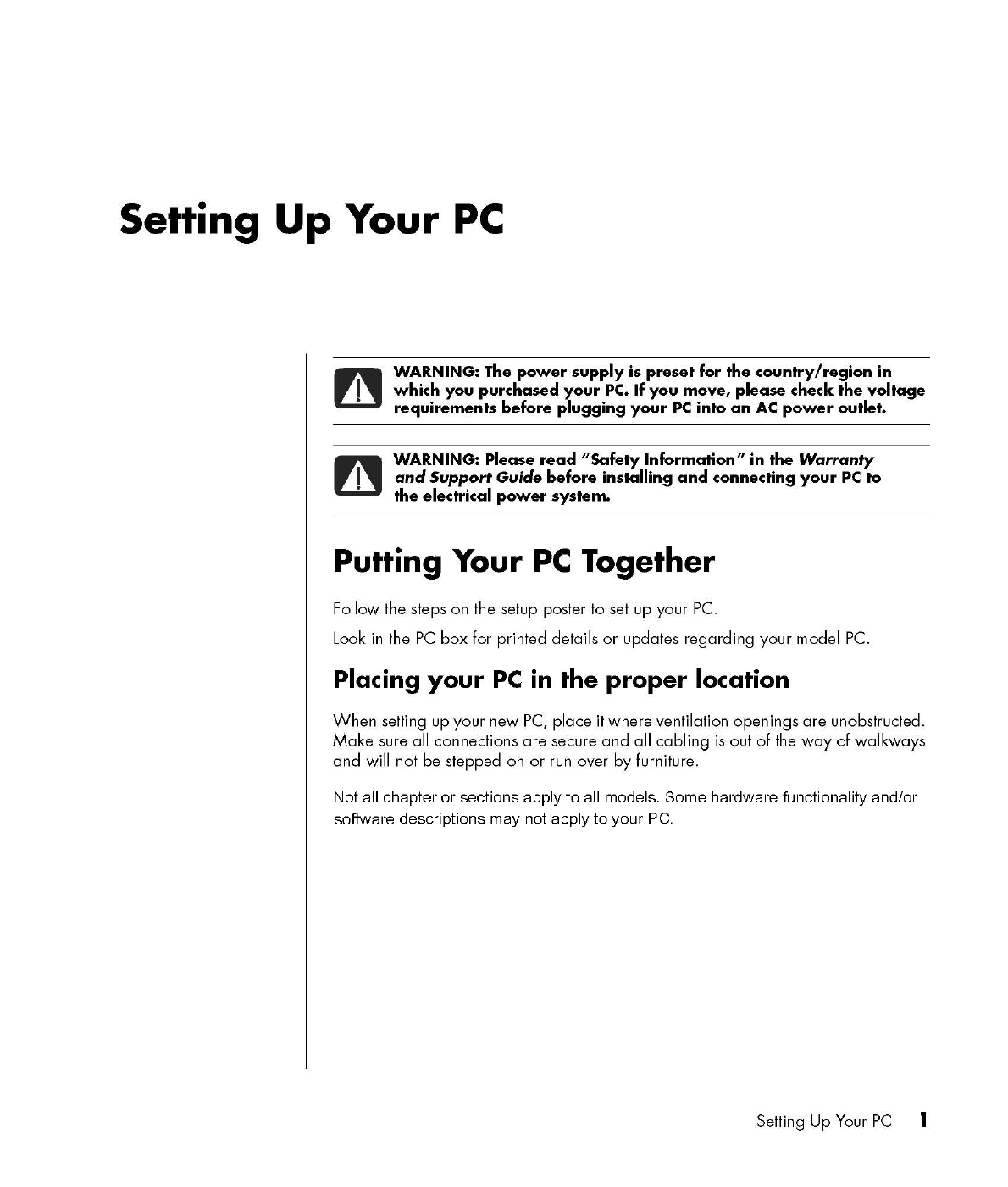
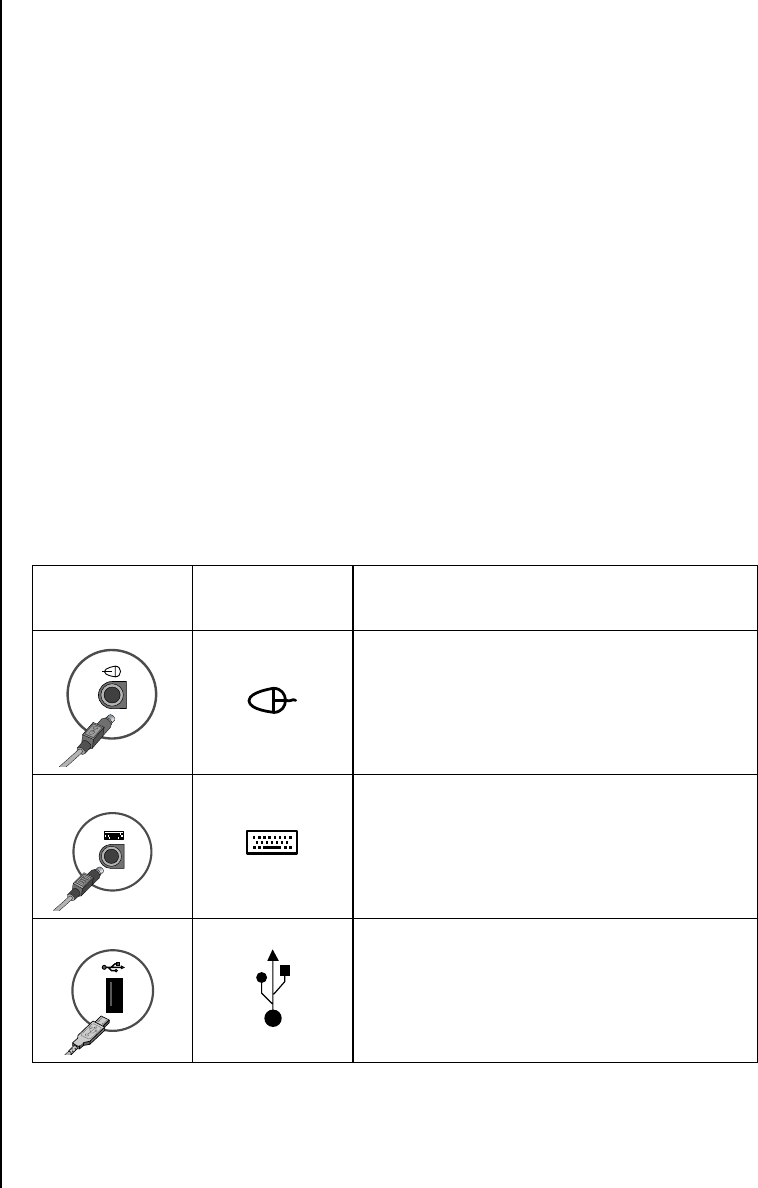
2Getting Started Guide
Using surge protection
Help protect your monitor, PC, and accessories by connecting all power cords for
your PC and peripheral devices (such as a monitor, printer, or scanner) to a
surge-protection device such as a power strip with surge protection or
uninterruptible power supply (UPS). Many surge protection devices have
surge-protection inputs and outputs for modem/phone lines. Phone lines are a
common path for lightning spikes to get into your system. Some surge protection
devices also have surge protection for television cable connections as well: use
those if your PC has a television tuner installed.
Not all power strips provide surge protection; the power strip must be specifically
labeled as having this ability. Use a power strip whose manufacturer offers a
damage replacement policy so you can replace your equipment if surge protection
fails.
Connecting to the PC
Connect your main hardware devices such as the monitor, keyboard, and mouse to
the back of the PC. Other peripheral devices such as a printer, scanner, or camera
also plug into connectors on the back of your computer. Some PC models also have
connectors on the front of the PC. The table does not show all connectors.
Connector
Connector
symbol Description
Mouse (PS/2 connector)
Keyboard (PS/2 connector)
Universal Serial Bus (USB) for mouse,
keyboard, digital cameras, or other devices
with USB connectors
NOTE: Your PC
f
eatures
and location, availability,
and number of connectors
may vary.
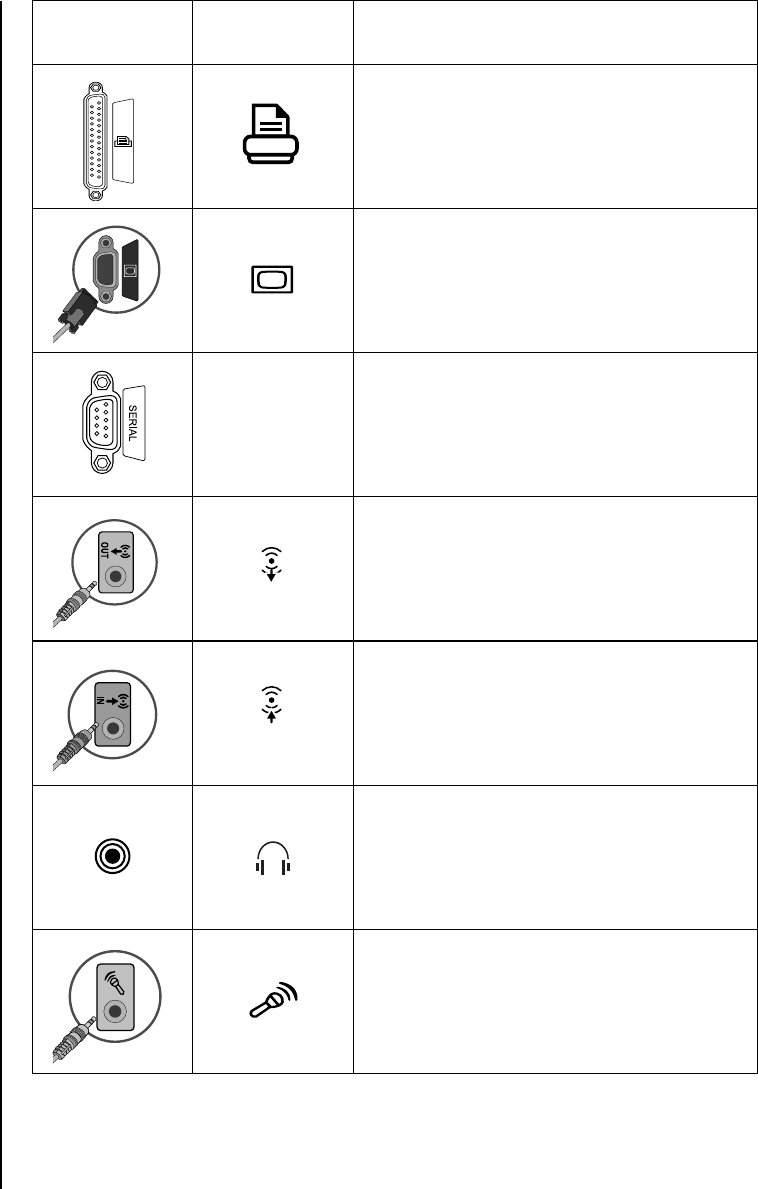
Setting Up Your PC 3
Printer (parallel)
Monitor
Serial
Serial port for some digital cameras or
other serial devices
Audio Line Out (powered speakers)
Audio Line In
Headphones
Microphone
Connector
Connector
symbol Description
OUT
IN
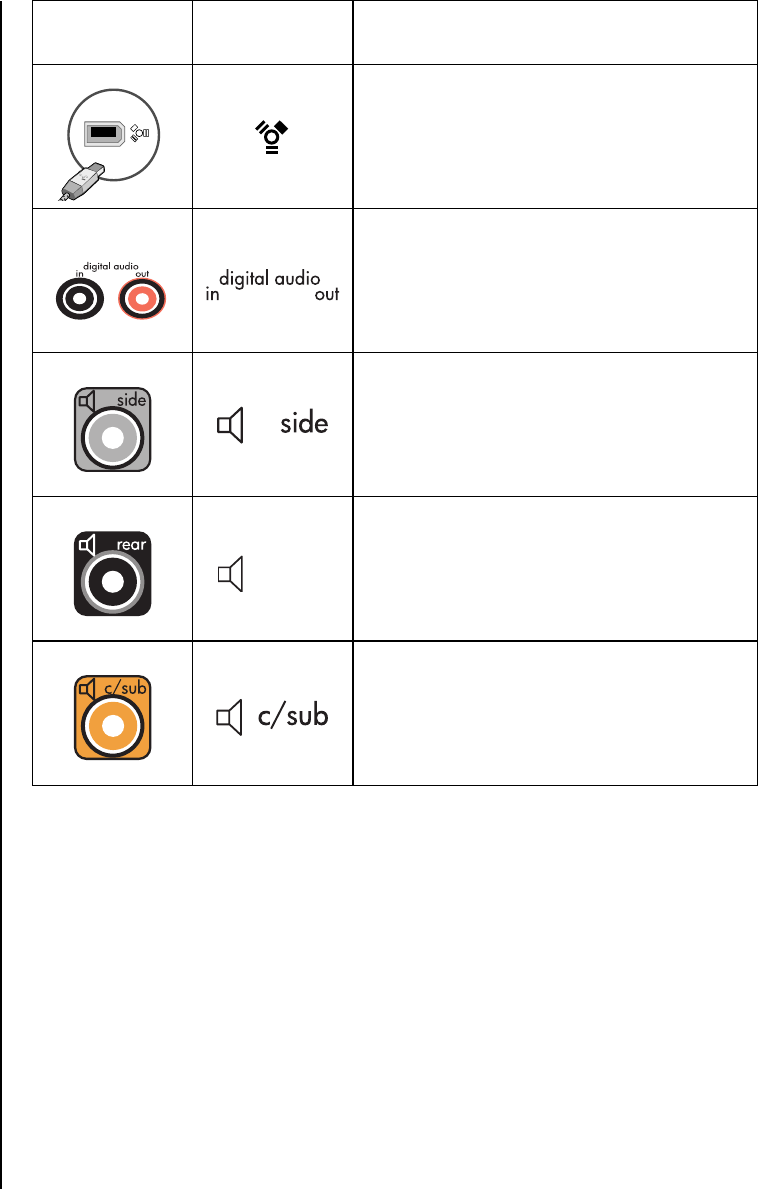
4Getting Started Guide
FireWire® (IEEE 1394) for video cameras
or other devices with very fast transfer rates
S/PDIF In and S/PDIF Out
Side speaker out
Rear speaker out
Center/subwoofer
Connector
Connector
symbol Description
rear

Setting Up Your PC 5
Storing documentation and recovery discs
Store all PC user manuals and warranty information in an easy-to-find, safe location.
It is a good idea to store your system recovery discs with your documentation. This
will allow easy access to all important PC documents and files in one place.
Turning On Your PC for the First Time
After you have completed the steps on the quick setup poster, you are ready to turn
on your PC.
1Press the Power button on the monitor.
2Press the On button on the front of the PC.
3Turn on the speakers, if they are present.
4Click an option to select your language (if applicable for your model). Click
OK, and then confirm your selection by clicking Yes. Wait until the PC makes
preparations. (It may take up to 30 minutes for this one-time language setup on
the PC.)
5Set up Microsoft® Windows® by following the onscreen instructions.
6(Select models only) Follow the Easy Internet Sign-up or Internet Services wizard
to set up an Internet connection. If you do not wish to set up an Internet
connection at this time, Easy Internet Sign-up or Internet Services can be
manually started at a later time. See “Setting Up and Connecting to the
Internet” on page 6.
7(Select models only) Follow the Easy Setup wizard to update the PC security
tools, register the PC and finish PC setup. If you decide to finish setup at a later
time, the wizard can be started by double-clicking the Easy Setup icon on the
desktop.

6Getting Started Guide
Setting Up and Connecting to the
Internet
Requirements:
•A PC.
•A dial-up modem or a cable or DSL modem for high-speed broadband
connections. Contact your Internet service provider (ISP) for any specific
software and hardware you may need.
•Internet service with an ISP.
•A Web browser.
To set up and connect to the internet:
1Make sure the modem or other Internet access cable is connected.
2Sign up with an ISP. If you already have an account with an ISP, skip this step
and follow the instructions provided by the ISP.
If Internet service was not set up during the initial setup of the PC, it can be set
up now using the Easy Internet Sign-up or the Internet Services wizard (select
models only).
Click Start on the taskbar, All Programs, Online Services, and Easy
Internet Sign-up or Internet Services.
Follow the onscreen instructions to select an ISP and set up Internet service.
3Connect to the Internet. You must connect through the ISP to connect to the
Internet.
Double-click the ISP-provided icon on the desktop.
4Open your Web browser and browse the Web.
You can use any Web browser; most PCs have Internet Explorer.
Click Start, All Programs, and Internet Explorer.
NOTE: Easy Internet Sign-up or Internet Services provides a list of Internet
service providers; however, you may choose another ISP or transfer an existing
account to this PC. To transfer existing accounts, follow the instructions
provided by the ISP.
NOTE: If you have questions, contact the ISP directly.

Setting Up Your PC 7
Configuring and Registering Norton
Internet Security Software
Norton Internet Security software is preinstalled on your PC and includes a
complimentary 60-day subscription to protection updates. You can enable
Symantec’s LiveUpdate™ to obtain protection updates automatically whenever you
are online.
When you first set up the PC, the Norton Internet Security Information Wizard helps
you to configure and register your copy of Norton Internet Security.
Be sure to set up Norton Internet Security before you start surfing the Internet. Just
click on the Norton Internet Security icon after you’ve established an Internet
service account, and a wizard will guide you through the simple setup process.
1Double click the Norton Internet Security icon in the system tray to
launch the Configuration Wizard.
2Click Next and follow the instructions to:
•Complete registration
•Schedule post-installation tasks including running LiveUpdate™, scanning
for viruses, and scheduling weekly scans of local hard drives.
3On the Summary page, click Finish.
When registration and initial setup is finished, Norton Internet Security
automatically begins the post-installation tasks you selected.
For information about using and updating the Norton Internet Security software,
click Start, All Programs, Norton Internet Security, and then click Help
and Support.

8Getting Started Guide
Using the PC with Safety and Comfort
Before you begin using the PC, arrange the PC and your work area to maintain your
comfort and productivity. Refer to the Safety & Comfort Guide for important
ergonomic information:
•Click Start, choose All Programs, choose User’s Guides, and then click
Safety & Comfort Guide.
Or
•Type
http://www.hp.com/ergo/
into your Web browser address box, and then press Enter on the keyboard.
Signing Up for Software Updates
Microsoft continually updates the Windows operating system. It is recommended
that you check for, download, and install these updates at least monthly. Take
advantage of the Automatic Updates feature, a convenient way to keep the
operating system up to date. When you are connected to the Internet, Windows
Update automatically notifies you through a pop-up message or icon in the
notification area when critical updates are available. When you see the Windows
Update message, allow the updates to download to the system. If you update the
system weekly, or at least monthly, the time required for download is minimal.
To configure Automatic Updates:
Click Start, Control Panel, Other Control Panel Options, and then
Automatic Updates.
In the Automatic Updates window, select the desired configuration:
•Automatic (recommended) — This is the default setting, and it allows you to
specify a day and time to automatically download and install recommended
updates.
•Download updates for me, but let me choose when to install them.
•Notify me but don’t automatically download or install them.
The Turn off Automatic Updates option makes the PC more vulnerable and is
not recommended.
WARNING: To reduce the risk of serious injury, read the Safety &
Comfort Guide. It describes proper workstation setup, posture, and
health and work habits for PC users. It also provides important
electrical and mechanical safety information.

Setting Up Your PC 9
Setting Up Accounts on Your New PC
User accounts allow you to set the privileges for each user of your PC. For example,
you can set the software programs that each user is allowed to access. Follow the
simple steps in this section when setting up your PC to create user accounts.
Creating user accounts
The information below describes the different account types in Windows XP and
explains how to change account types.
Creating multiple user accounts on the same PC has certain advantages as well as
some drawbacks.
•Advantages to multiple user accounts:
•Ability to create individual user settings
•Ability to limit access to software for certain users
•Drawbacks to multiple user accounts:
•More memory (RAM) usage
•Multiple Temporary Internet Files folders to remove during Disk Cleanup
•More data to back up
•Longer time to complete virus scan
Windows XP provides three types of user accounts:
•Administrative
Allowed to change account types for other users, change passwords, change
system-wide settings, and install Windows XP-compatible software and drivers.
•Limited
Not allowed to change other user settings, or passwords. Limited account may
not be able to install or run some software.
Allowed to change the limited account picture, and create, edit, or delete the
account password.
•Guest
Not allowed to change other user settings or passwords.
Users who log on to the PC using the guest account do not have access to
password-protected files, folders, and settings.

10 Getting Started Guide
Creating passwords
Passwords help protect your PC and information from unauthorized access and help
ensure that information on the PC stays private and secure. Use the following list as
a basic guide when choosing your password:
•Choose a password that is easy for you to remember but difficult for others to
guess.
•Choose a long password (minimum of 6 characters).
•Use a combination of upper and lower-case letters, numbers, and symbols.
•Don’t use personal information that others can easily figure out, such as your
birthday, child’s name, or phone number.
•Don’t write down your password.
Guidelines for Installing Software and
Hardware Devices
After you set up the PC, you may wish to install additional software programs or
hardware devices. Keep in mind these important guidelines:
•Before installation, make a restore point using the Microsoft System Restore
program.
Click Start, All Programs, PC Help & Tools, and then System Restore.
The restore point is a snapshot of your PC configuration. By using System
Restore, you ensure that you have a point to return to before an issue occurred.
For information about System Restore, refer to the Microsoft Web site at:
http://www.microsoft.com/worldwide
•Choose software that is compatible with your PC — check the operating system,
memory, and other requirements listed for the new software for compatibility
with your PC.
•Install the new software according to the directions provided by the software
manufacturer. Check the manufacturer’s documentation or customer service
information for help if you need it.
•For antivirus software, uninstall the existing software program before
reinstalling it or installing a new antivirus program.
NOTE: Only use licensed original software. Installing copied software may be
illegal, may result in an unstable installation, or may infect your PC with a virus.

Setting Up Your PC 11
Using HP Products
HP PCs include preloaded software for select HP All-In-One, camera, scanner, and
printer peripheral products. Preloaded software simplifies and speeds product setup
for HP peripherals. Simply connect the HP peripheral product, turn it on, and your
HP PC automatically configures it so it is ready to use.
Transferring Files and Settings from
Your Old PC to Your New PC
You can copy the old PC files to the new PC using media such as CD or DVD discs,
memory sticks, or personal media drives. You can also copy certain settings such as
Web browser Favorites and address books using Microsoft’s Files and Settings
Transfer Wizard.
For more information click Start, All Programs, and then Help and Support.
Search for transfer wizard, and select the overview article, “Files and Settings
Transfer Wizard overview.” This information describes a Microsoft solution for
moving your files onto your new PC.
Using HP Organize Software
HP Organize software (select models only) is a desktop tool you use to organize
both your PC shortcuts and your favorite Internet destination links. You use it to
organize the important things you do on the PC and the Internet and to arrange
them the way you want. HP Organize makes all your information available with just
a few mouse clicks.
HP Organize looks like a window with multiple category frames. Each category has
links to Internet destinations or shortcuts to software programs or files on your PC.
Use the player area for viewing pictures, for listening to your MP3 music files stored
on your PC, or for watching video clips. For searching, there is a search bar at the
top of HP Organize where you can select the search engine you want to use.
To open HP Organize:
1Click Start on the taskbar.
2Choose All Programs.
3Click HP Organize.

12 Getting Started Guide
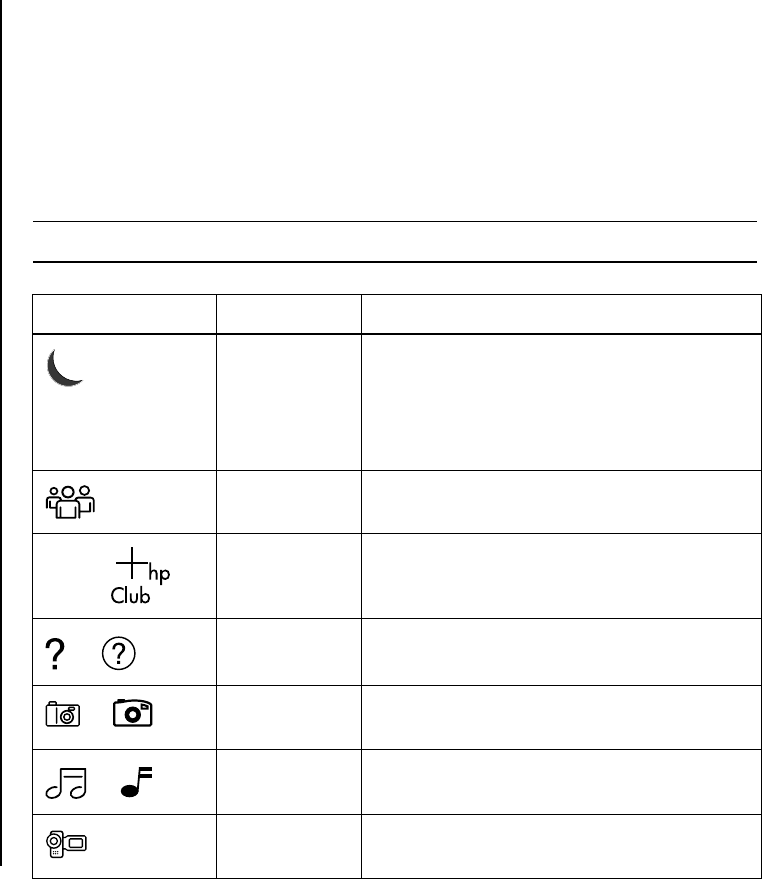
Using the Keyboard 13
Using the Keyboard
Your keyboard has an arrangement of standard keys, indicator lights, and special
buttons (select models only).
Identifying Special Keyboard Buttons
There are special buttons (select models only) at the top of the keyboard. (Some
models have some of these special buttons on the left side of the main keys.) These
buttons operate a CD or DVD player, connect you to the Internet, or provide quick
access to specific functions.
NOTE: The number, location, and labeling of buttons vary by keyboard model.
Icon Feature Description
Standby Puts PC into power-saving mode (screen is
blank but PC is still on). To make the screen
reappear, press the Esc key, or press
Standby again. May take 10–30 seconds
before the screen reappears.
User Switches between the PC users.
hp or
HP Links to an HP Web site.
or
Help Opens the Help and Support Center.
or Pictures
(Photos) Opens an imaging software program. Can
be reconfigured.
or
Music Opens music software program. Can be
reconfigured.
Video Opens video software program. Can be
reconfigured.
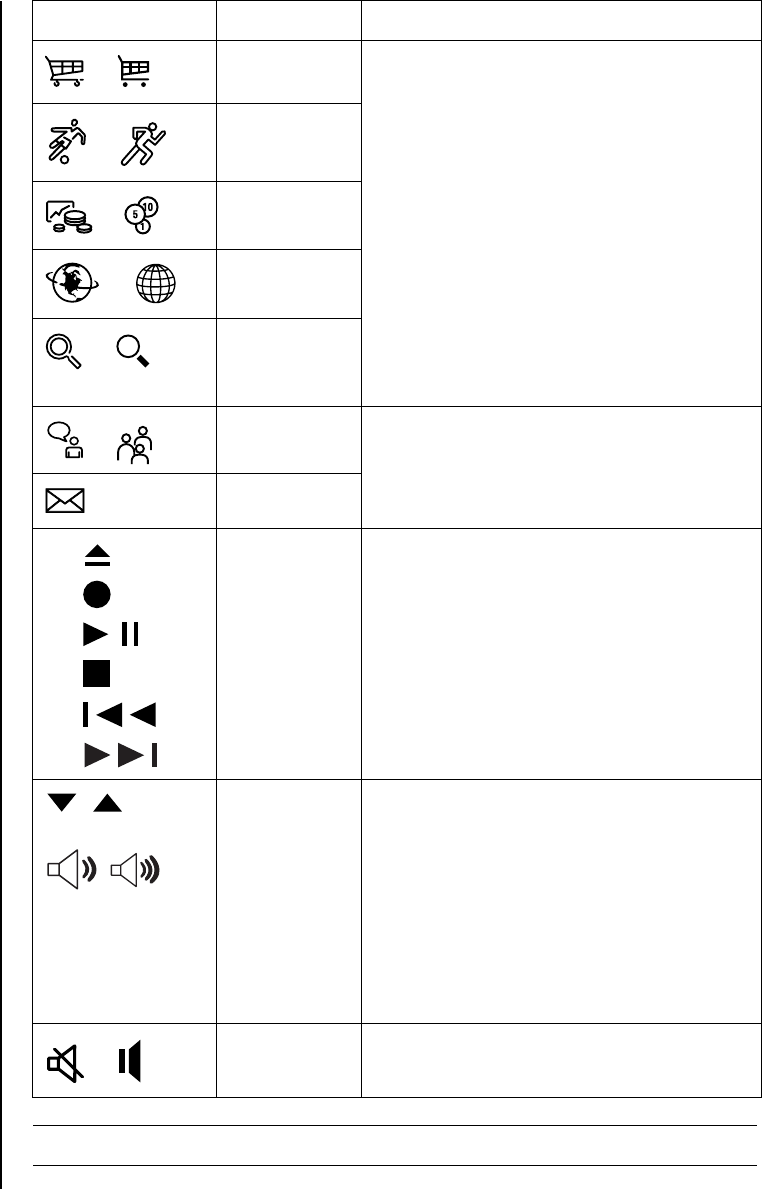
14 Getting Started Guide
or Shopping
or
Sports
or
Finance
or
Connect to
Internet
or
Search Goes to popular Web sites. Can be
reconfigured to open a site or software
program.
or
Chat
E-Mail
A
B
C
D
E
F
Media
controls (CD/
DVD/MP3)
Operates a disc player.
AOpen and close disc tray
BRecord
CPlay or pause
DStop
ESkip to the previous track
FSkip to the next track
or
or
–+
Volume
control
(Volume knob
or Volume Up
and Volume
Down
buttons)
Volume knob: Increases speaker volume
when turned clockwise and decreases
volume when turned counterclockwise. It
can be turned indefinitely, even after
maximum sound has been reached.
Volume Up and Down buttons: Press the
Volume Up button to increase volume and
the Volume Down button to decrease
volume.
or
Mute Turns speaker sound on and off.
NOTE: The number, location, and labeling of buttons vary by keyboard model.
Icon Feature Description

Using the Keyboard 15
Customizing the keyboard buttons
You can customize some of the special buttons on the keyboard (select models only)
to open different programs or files or to connect to favorite Web sites:
1Click Start on the taskbar.
2Choose Control Panel.
3Click Printers and Other Hardware, if it is present.
4Double-click Keyboard.
5On the Buttons tab, double-click the button you want to change.
6For the Button configuration, click the Down arrow to the right of the list and
choose the button capability, such as Complex remote page with label or
Simple local file with label.
7Enter a display label and the address information. For a Web page, enter
the URL.
8Click OK.
9On the Buttons tab, click Apply.
10 Repeat steps 5 through 9 for each button you want to customize.
11 Click OK to finish.
NOTE: Clicking the Restore Defaults button on the Button tab restores all of the
Internet buttons to the factory settings.

16 Getting Started Guide
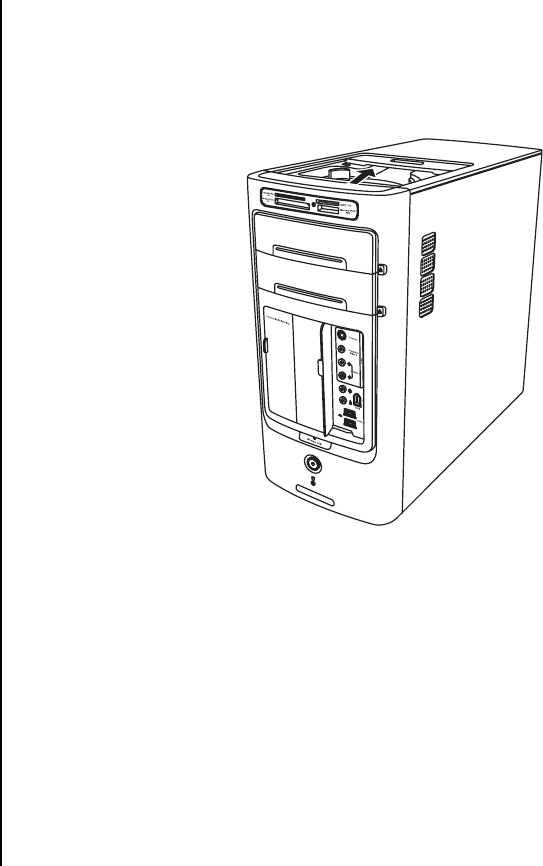
Using Your PC Top 17
Using Your PC Top
Your PC may have a storage area or docking bay (select models only) on the top of
the PC chassis.
Using Your Docking Bay
You can use the docking bay to:
•Store CDs, DVDs, or memory cards.
•Dock a peripheral device in the bay, such as a digital camera docking station.
•Install a special cover (optional) and an HP camera and HP camera docking
station. (Both the camera and the docking station are sold separately.)
The bay design allows you to place a device and thread the USB or FireWire
(IEEE 1394) data cable and the power cord underneath the rear top cover to the
connectors on the back of the PC.
Your PC may look different from the one shown here. Components and location,
availability, and number of connectors may vary.

18 Getting Started Guide
To store CDs, DVDs, or memory cards:
Gently press down on the bay lid and slide it open.
To install a peripheral device or an HP camera and HP camera
docking station:
1Gently press down on the bay lid and slide it open.
2Place the peripheral device or the camera docking station (A) on the top of
the PC.
3For a camera, place the camera cradle (B) that came with the digital camera
on the camera docking station. The cradle clips onto the camera docking
station.
A
B
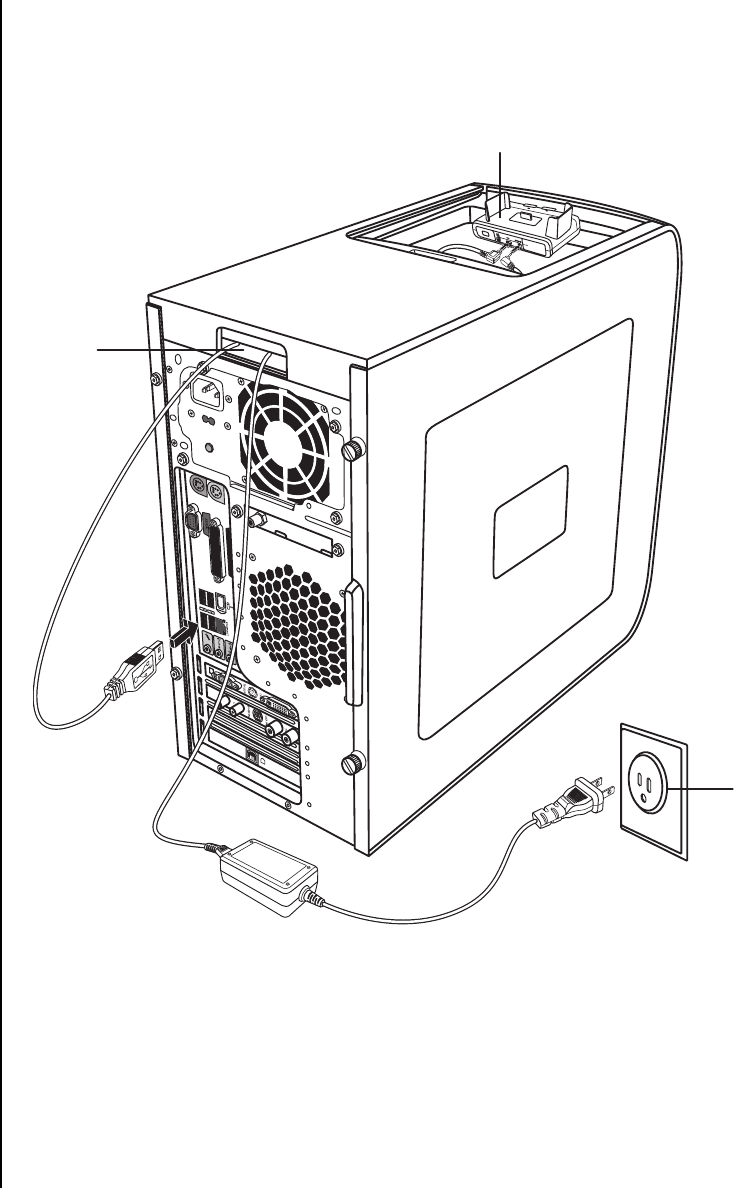
Using Your PC Top 19
4Thread the cables that came with your peripheral devices or camera docking
station through the cable tunnel (C). Starting from the back of the PC, thread
them to the front of the PC. Pull the cables to the center and connect them to the
peripheral or the docking station (D).
5Connect the cables to the back of the PC or to a power outlet (E).
For a peripheral, refer to the instructions that came with your peripheral device.
D
E
C

20 Getting Started Guide
For an HP camera docking station:
•Plug the USB cable into the back of the PC.
•Plug the power cord into a power outlet.
Optionally, if you want to view the camera images on a TV, plug the red and
yellow connectors (not shown) into the TV.
Refer to the instructions that came with the HP camera docking station.
6Place the correct camera docking station lid (F) on top of the PC. Gently guide
the edge of the lid into the top of the PC.
7When you want to use it, place the HP digital camera (G) into the docking
station.
8Follow the instructions that came with your peripheral or docking station.
F
G

Configuring Speaker and Sound Options 21
Configuring Speaker and Sound
Options
HP PCs support many different audio options, sound connections, and speaker
configurations. You may set up your PC for two stereo speakers or for multichannel
audio speaker systems. Connect your speaker system to the PC, and then configure
the audio software for sound output. For more details about connecting stereo
speakers to the PC, see the setup poster.
This chapter describes the most typical options. Your system may have different
components.
Sound Connector Types
Your model may include one of three analog sound connector types on the back of
your PC:
•Three connectors
•Six connectors
•Sound card
Your system may also have a separate Digital Out connection (select models only).
NOTE: For additional information on connecting the speakers, refer to the setup
poster that came with the PC and the documentation that came with your speakers.
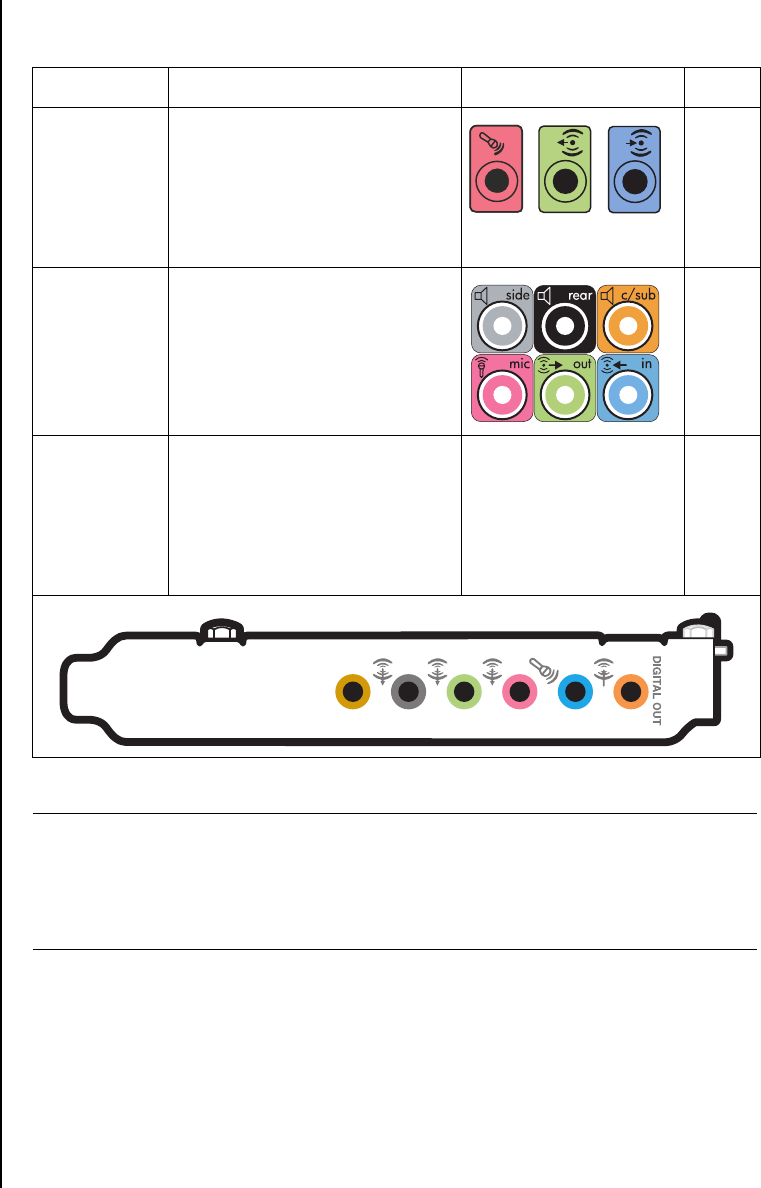
22 Getting Started Guide
Software configuration is different for each connector type, as noted in the
instructions.
Use the sound connectors that match your PC model when installing cables, as
shown in the installation procedure steps.
Connector Description Illustration Type
Three
connectors Your PC model may include
three sound connectors. You
can connect up to a 5.1 audio
system to the PC. If you want to
connect multichannel audio,
follow the instructions carefully.
3
Six
connectors Your PC model may include six
sound connectors on the back
of your PC. You can connect
up to a 7.1 audio system to
the PC.
6
Sound card
connector Your PC may include a sound
card. You can connect up to a
5.1 audio system (7.1 audio
system for select models) or
digital speakers to the sound
card on the PC.
See below.S
NOTE:
•Type 3 is three connectors
•Type 6 is six connectors
•Type S is sound card
OUT
IN
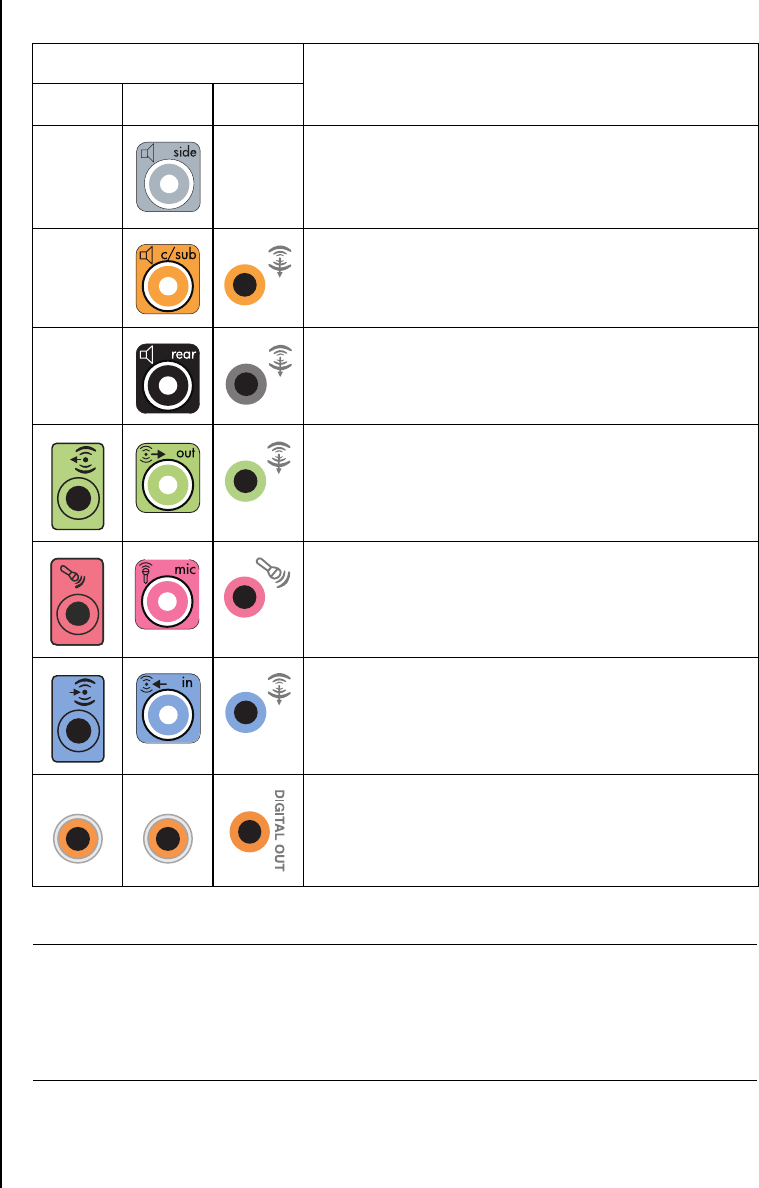
Configuring Speaker and Sound Options 23
The following table shows the sound connectors on the back panel of PC systems.
Sound connector
Description
36S
Line Side (gray) for side speakers in an eight-
speaker system (7.1).
Line C/Sub (gold) for center/subwoofer speakers
in a multichannel audio configuration.
Line Rear (black) for rear speakers in a
multichannel audio configuration.
Line Out (lime-green) for front speakers.
Mic (pink) connects to microphone.
(Type 3 also functions as center/subwoofer Line
Out when a multichannel audio configuration is
activated.)
Line In (light blue) connects to an analog audio
device such as a CD player for input into PC.
(Type 3 also functions as rear Line Out when a
multichannel audio configuration is activated.)
Digital Out (orange) connects to a digital audio
device with digital input (such as a home audio
receiver/amplifier) or digital speakers (select
models only).
NOTE:
•Type 3 is three connectors
•Type 6 is six connectors
•Type S is sound card
OUT IN
DIGITAL
AUDIO OUT
DIGITAL
AUDIO OUT

24 Getting Started Guide
Speaker Configurations
You may set up your PC for the following supported configurations:
Name Speaker system See
Headphones None, muted. “Using Headphones” on
page 47.
2 (stereo) Left speaker, right speaker. “Connecting 2.1
(2 speakers and a
subwoofer) audio speakers”
on page 25.
2.1 Left speaker, right speaker, and
a subwoofer. “Connecting 2.1
(2 speakers and a
subwoofer) audio speakers”
on page 25.
4.1 Two front speakers, two rear
speakers, and a subwoofer. “Connecting 4.1
(4 speakers and a
subwoofer) audio speakers”
on page 26.
6/5.1 Two front speakers, two rear
speakers, a center speaker,
and a subwoofer.
“Connecting 5.1
(5 speakers and a
subwoofer) audio speakers”
on page 28.
8/7.1 Two front speakers, two rear
speakers, two side speakers, a
center speaker, and a
subwoofer (select models only).
“Connecting 7.1
(7 speakers and a
subwoofer) audio speakers”
on page 29.
Home audio
system Home stereo or home theater
audio system with passive
speakers.
“Connecting the PC to a
Home Audio System” on
page 31.
Digital audio Digital speakers or digital input
connector on audio system. “Connecting Digital Audio”
on page 35.
Multi-streaming
audio Two front speakers, two rear
speakers, two side speakers,
a center speaker, and a
subwoofer (select models only).
“Configuring Multi-
streaming Audio” on
page 43.
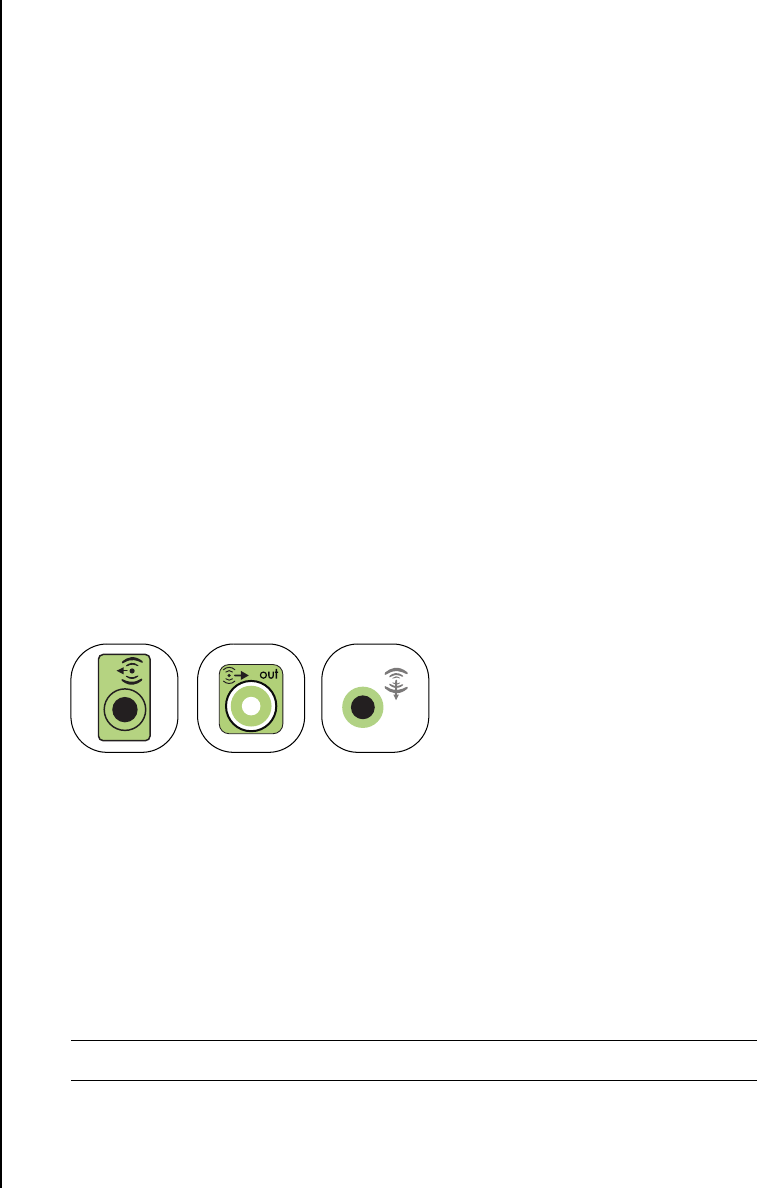
Configuring Speaker and Sound Options 25
Speaker types
Speakers may be included with the monitor (select models only) or are sold
separately. Refer to the product documentation for your speakers.
Your PC supports only an active (powered) speaker system. An active speaker
system must have its own power cord. A home audio system does not require active
speakers because the receiver provides amplification.
A stereo speaker set is a left-right, two-channel speaker system. A multichannel
audio speaker system has a left-right front and left-right rear channel, and it may
include a subwoofer and a center speaker. Side speakers are included in more
advanced systems. A subwoofer provides enhanced bass sounds.
“.1” indicates a subwoofer. For example, 7.1 channels refers to an eight-speaker
mode and uses two front speakers (left-right), two side speakers (left-right), two rear
speakers (left-right), a center speaker, and a subwoofer.
Connecting 2.1 (2 speakers and a subwoofer)
audio speakers
To connect simple left/right stereo active speakers or two speakers and a subwoofer
for 2.1 speaker output:
1Turn off the PC.
2Connect the speaker cable to the lime-green Audio Line Out connector that
matches the back of your PC.
•Type 3 is three connectors
•Type 6 is six connectors
•Type S is sound card
3Connect the cable to the audio system.
4For 2.1 speakers that were shipped with your PC (select models only), connect
the Audio Line Out connector to the subwoofer.
5Connect the left and right speakers to the subwoofer. Refer to the speaker
documentation.
6Turn on the PC.
NOTE: Always turn on the PC before you turn on the speaker system.
OUT
36S
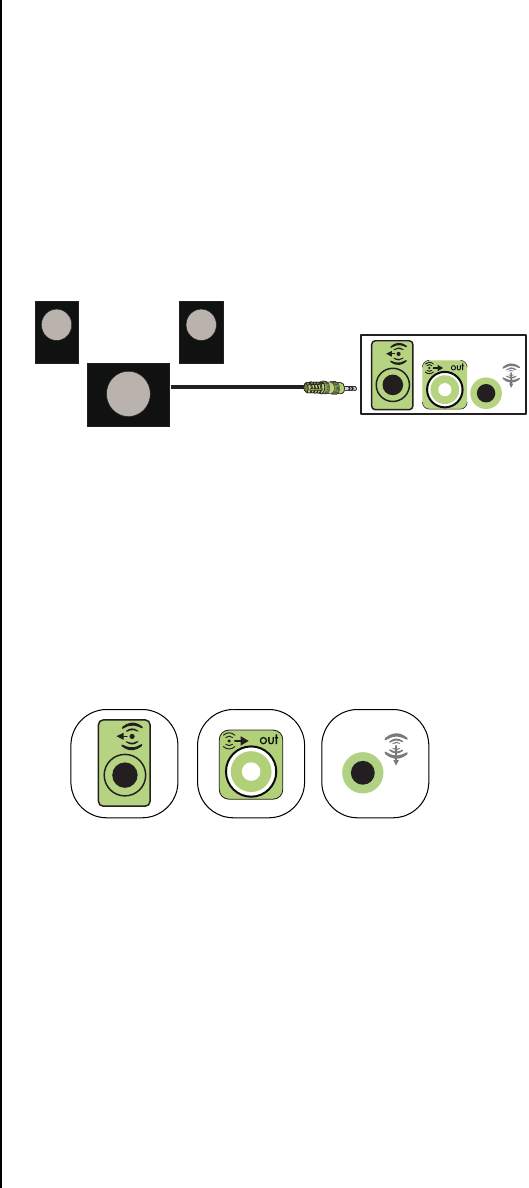
26 Getting Started Guide
7Plug in the speaker system power.
8Turn on the speaker system.
Step 8 is optional for a two-speaker setup.
9After the speakers are connected to the PC, configure the audio software for
sound output for your PC model:
•Type 3 connectors: See “Configuring Audio Output with Multi-channel
Sound Manager” on page 37.
•Type 6 connectors: See “Configuring Audio Output with Sound Effect
Manager” on page 38.
The following diagram shows a typical 2.1 audio installation:
Connecting 4.1 (4 speakers and a subwoofer)
audio speakers
To connect two front speakers, two rear speakers, and a subwoofer for four-channel
(4.1 speaker) output:
1Turn off the PC.
.
2Connect the front speaker cable to the lime-green Audio Line Out connector that
matches the back of your PC.
•Type 3 is three connectors
•Type 6 is six connectors
•Type S is sound card
OUT
OUT
36S
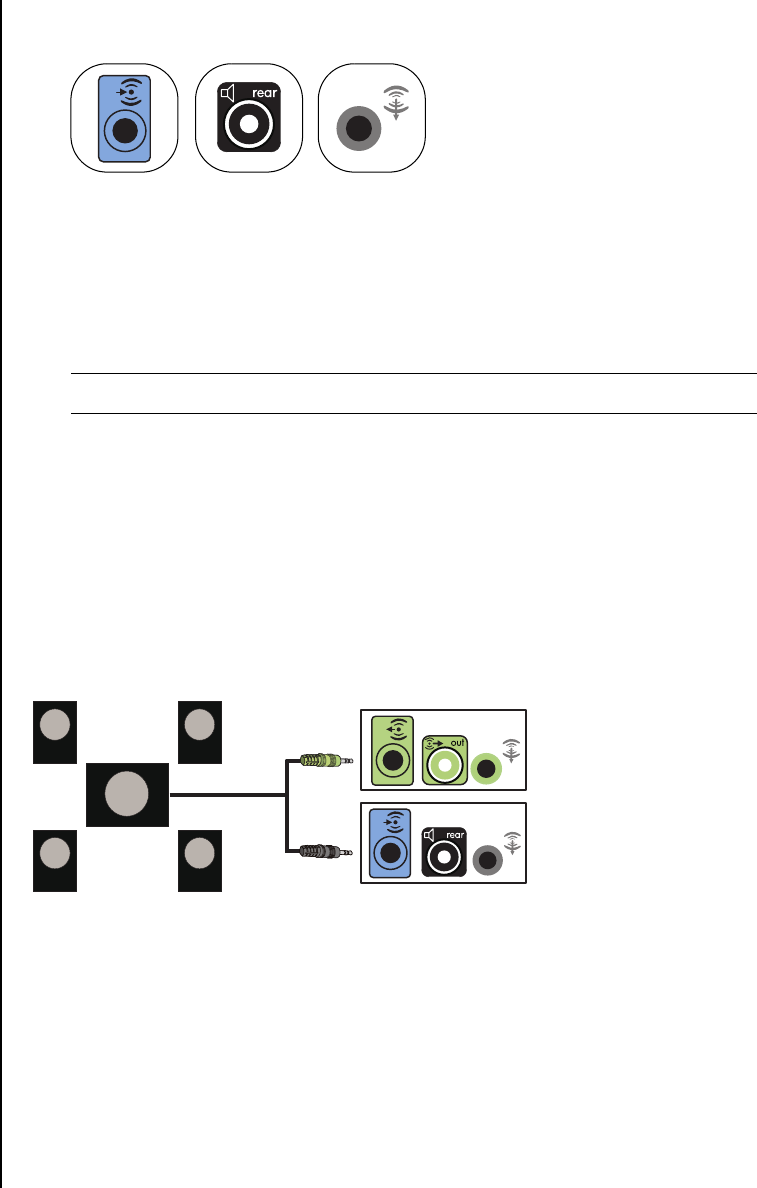
Configuring Speaker and Sound Options 27
3Connect the rear speaker cable to the black connector that matches the back of
your PC.
For type 3 connectors, the blue Audio Line In connector functions as a rear line
out when a multichannel audio configuration is activated.
4Connect the cables to the audio system.
5Connect the front and rear speakers to the subwoofer. Refer to the speaker
documentation.
6Turn on the PC.
7Plug in the speaker system power.
8Turn on the speaker system.
9After the speakers are connected to the PC, configure the audio software for
sound output for your PC model:
•Type 3 connectors: See “Configuring Audio Output with Multi-channel
Sound Manager” on page 37.
•Type 6 connectors: See “Configuring Audio Output with Sound Effect
Manager” on page 38.
The following diagram shows a typical 4.1 audio installation:
NOTE: Always turn on the PC before you turn on the speaker system.
IN
36S
OUT IN
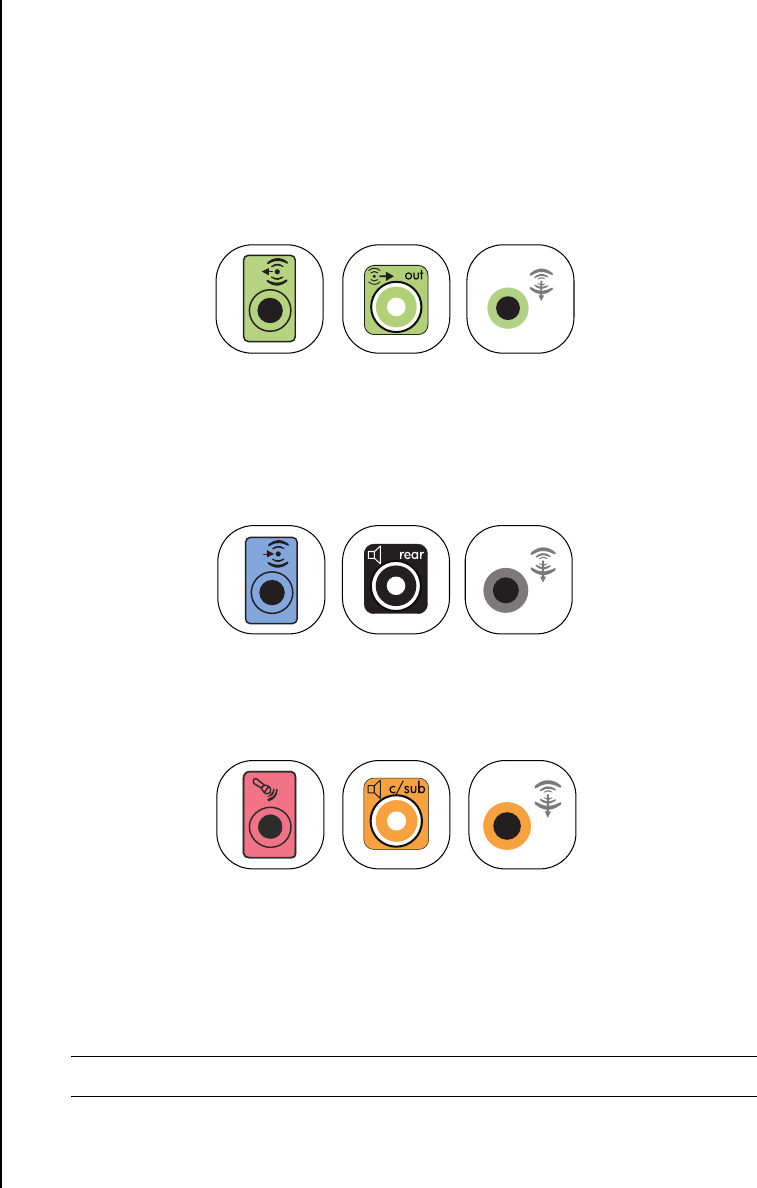
28 Getting Started Guide
Connecting 5.1 (5 speakers and a subwoofer)
audio speakers
To connect two front speakers, two rear speakers, a center speaker, and a
subwoofer for six-channel (5.1 speaker) output:
1Turn off the PC.
.
2Connect the front speaker cable to the lime-green Audio Line Out connector that
matches the back of your PC.
•Type 3 is three connectors
•Type 6 is six connectors
•Type S is sound card
3Connect the rear speaker cable to the black connector that matches the back of
your PC.
For type 3 connectors, the blue Audio Line In connector functions as a rear line
out when a multichannel audio configuration is activated.
4Connect the center/subwoofer speaker cable to the gold (or pink Mic)
connector that matches the back of your PC.
For type 3 connectors, the pink Mic connector functions as a center/subwoofer
speaker Line Out when a multichannel audio configuration is activated.
5Connect the cables to the audio system.
6Connect the front, rear, and center speakers to the subwoofer. Refer to the
speaker documentation.
7Turn on the PC.
NOTE: Always turn on the PC before you turn on the speaker system.
OUT
36S
IN
36S
36S
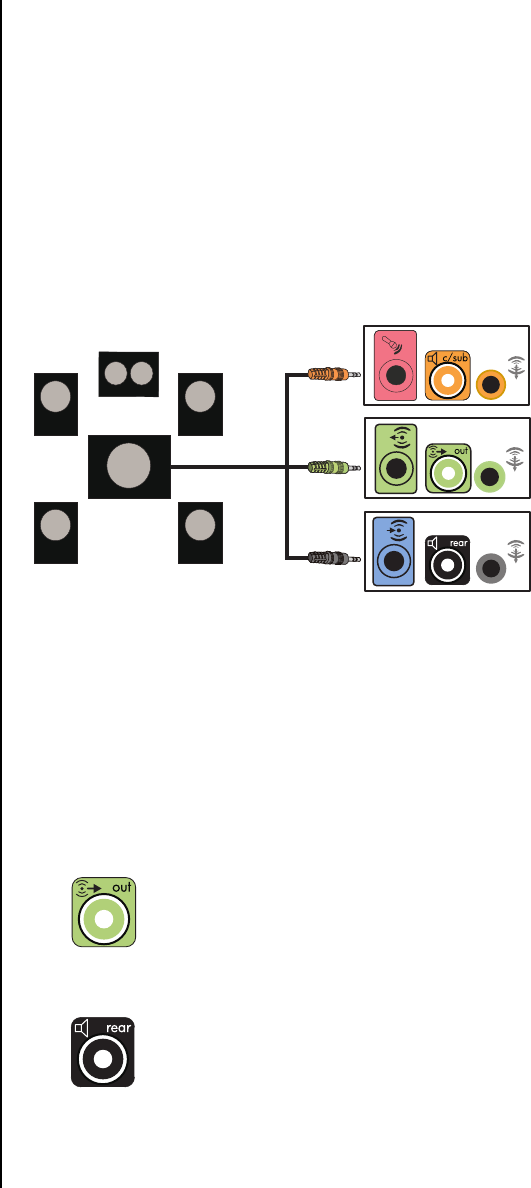
Configuring Speaker and Sound Options 29
8Plug in the speaker system power.
9Turn on the speaker system.
10 After the speakers are connected to the PC, configure the audio software for
sound output for your PC model:
•Type 3 connectors: See “Configuring Audio Output with Multi-channel
Sound Manager” on page 37.
•Type 6 connectors: See “Configuring Audio Output with Sound Effect
Manager” on page 38.
•Type 6 connectors — multi-streaming: See “Configuring Audio Output with
Realtek HD Sound Effect Manager” on page 41.
The following diagram shows a typical 5.1 audio installation:
Connecting 7.1 (7 speakers and a subwoofer)
audio speakers
To connect two front speakers, two side speakers, two rear speakers, a center
speaker, and a subwoofer for eight-channel (7.1 speaker) output:
1Turn off the PC.
.
2Connect the front speaker cable to the lime--green Audio Line Out connector on
the back of your PC.
3Connect the rear speaker cable to the black connector on the back of your PC.
OUT IN
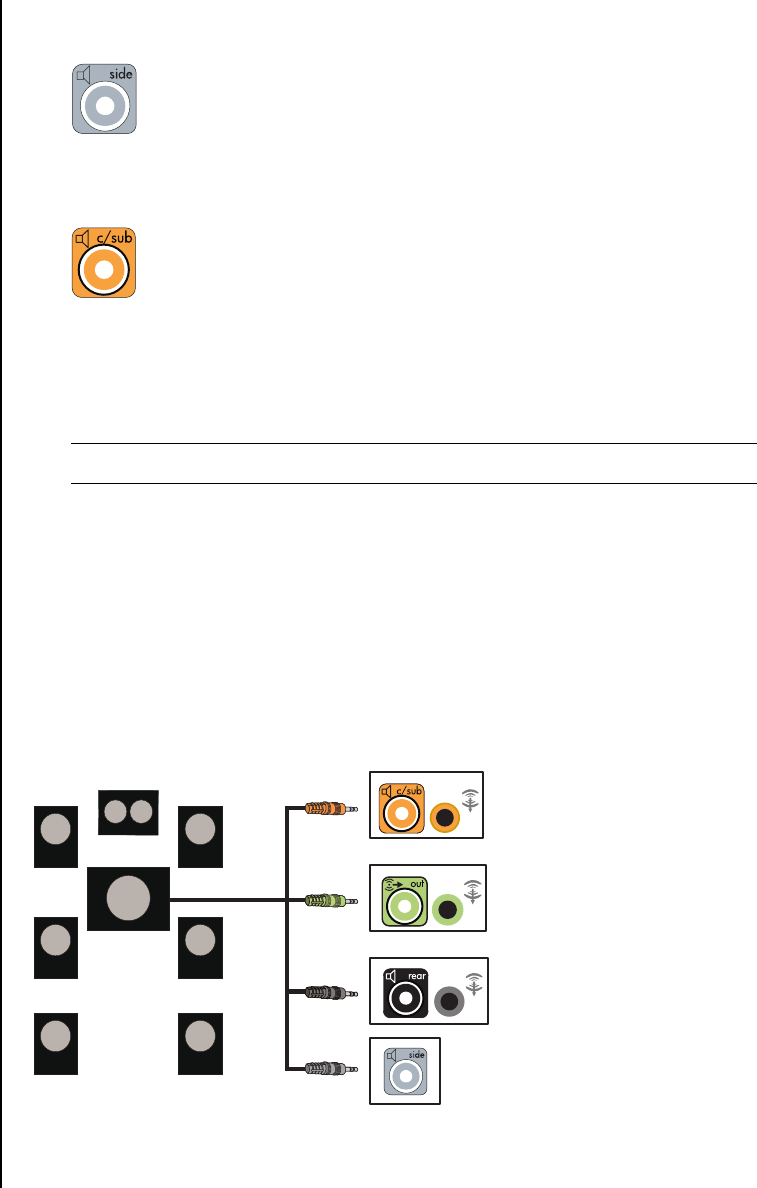
30 Getting Started Guide
4For type 6 connectors only, connect the side speaker cable to the gray
connector on the back of your PC.
5Connect the center speaker and subwoofer speaker cable to the gold connector
on the back of your PC.
6Connect the cables to the audio system.
7Connect the front, rear, side, and center speakers to the subwoofer. Refer to the
speaker documentation.
8Turn on the PC.
9Plug in the speaker system power.
10 Turn on the speaker system.
11 After the speakers are connected to the PC, configure the audio software for
sound output for your PC model:
•Type 6 connectors: See “Configuring Audio Output with Sound Effect
Manager” on page 38.
•Type 6 connectors — multi-streaming: See “Configuring Audio Output with
Realtek HD Sound Effect Manager” on page 41.
The following diagram shows a typical 7.1 audio installation:
NOTE: Always turn on the PC before you turn on the speaker system.

Configuring Speaker and Sound Options 31
Connecting the PC to a Home Audio
System
You can connect your PC to your home stereo or home theater multichannel audio
receiver/amplifiers using your existing speakers.
For example, see “2 or 2.1 home stereo installation” on page 32, or “5.1 (5
speakers and a subwoofer) home audio installation” on page 33.
Y adapter cables
Most home receiver/amplifiers have RCA-type connectors. You may need
to connect Y adapter cables between your PC and your receiver/
amplifier. Y adapter cables have one 1/8-inch (3.5 mm) stereo mini-jack
on one end and two RCA connectors on the other end. These cables are
purchased separately.
The number of Y adapter cables you need to connect to your home stereo
system depends on the number of speakers you install:
•2/2.1 speaker system: 1 Y adapter cable
•4/4.1 speaker system: 2 Y adapter cables
•5.1 speaker system: 3 Y adapter cables
•7.1 speaker system: 4 Y adapter cables
Connecting a home stereo to a PC typically requires audio cables that are long
enough to connect from the PC to the stereo. You may also need to purchase RCA or
mini-extension cables.
NOTE: Y adapter and extension cables are purchased separately.
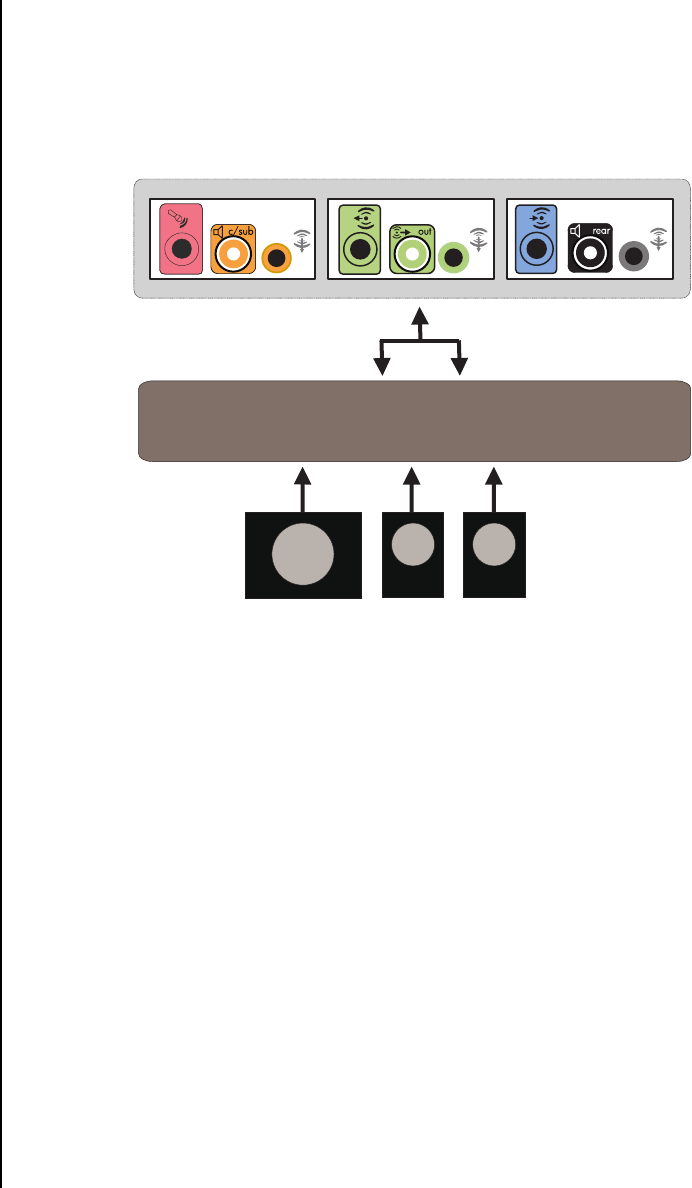
32 Getting Started Guide
2 or 2.1 home stereo installation
The following diagram shows a typical 2 or 2.1 speaker installation that uses
passive stereo speakers and that plugs into a home stereo standard left and right
input.
This is only a suggested configuration. Your system may be different.
PC to 2.1 multichannel audio system connection
A
PC back-panel
connectors (3, 6, or
sound card)
BY adapter cables
CReceiver/amplifier
DSubwoofer
EFront speakers
(left and right)
OUT
IN
A
B
C
DE
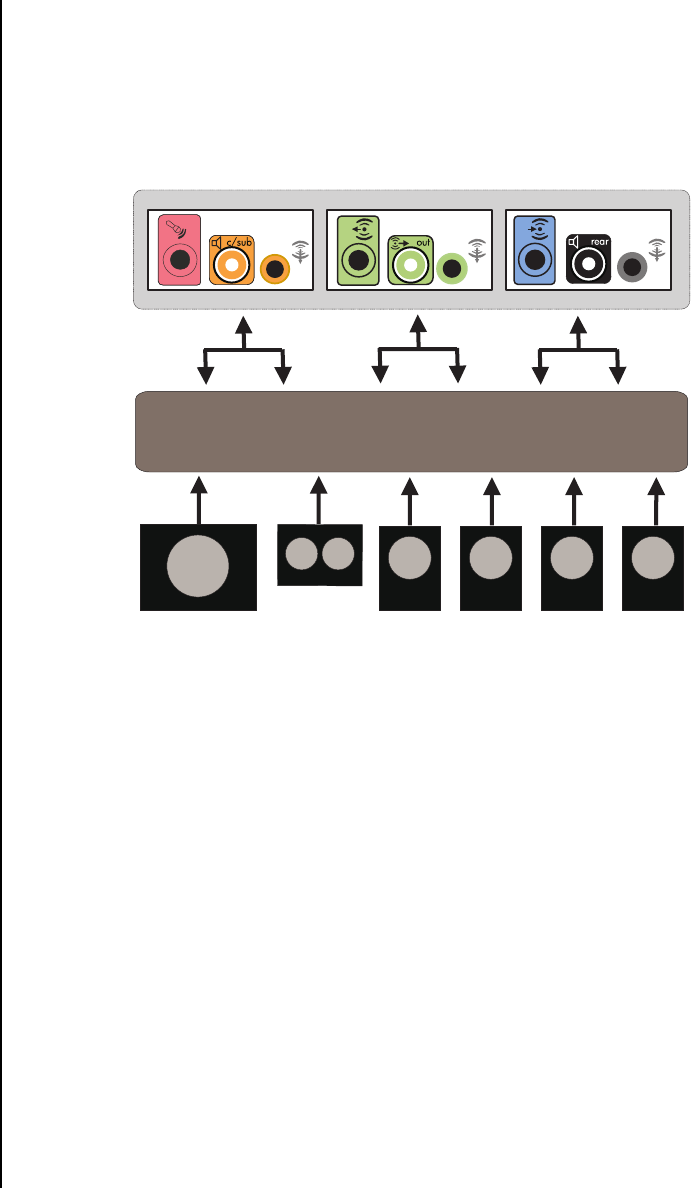
Configuring Speaker and Sound Options 33
5.1 (5 speakers and a subwoofer) home audio
installation
The following diagram shows a typical advanced home theater audio 5.1 speaker
installation that requires multichannel inputs on a receiver/amplifier.
This is only a suggested configuration. Your system may be different.
PC to 5.1 multichannel audio system connection
A
PC back-panel
connectors
(type 3, type 6,
or sound card)
BY adapter cables
CReceiver/amplifier
DSubwoofer
ECenter speaker
FFront speakers
(left and right)
GRear speakers
(left and right)
OUT
IN
A
B
C
DE F G
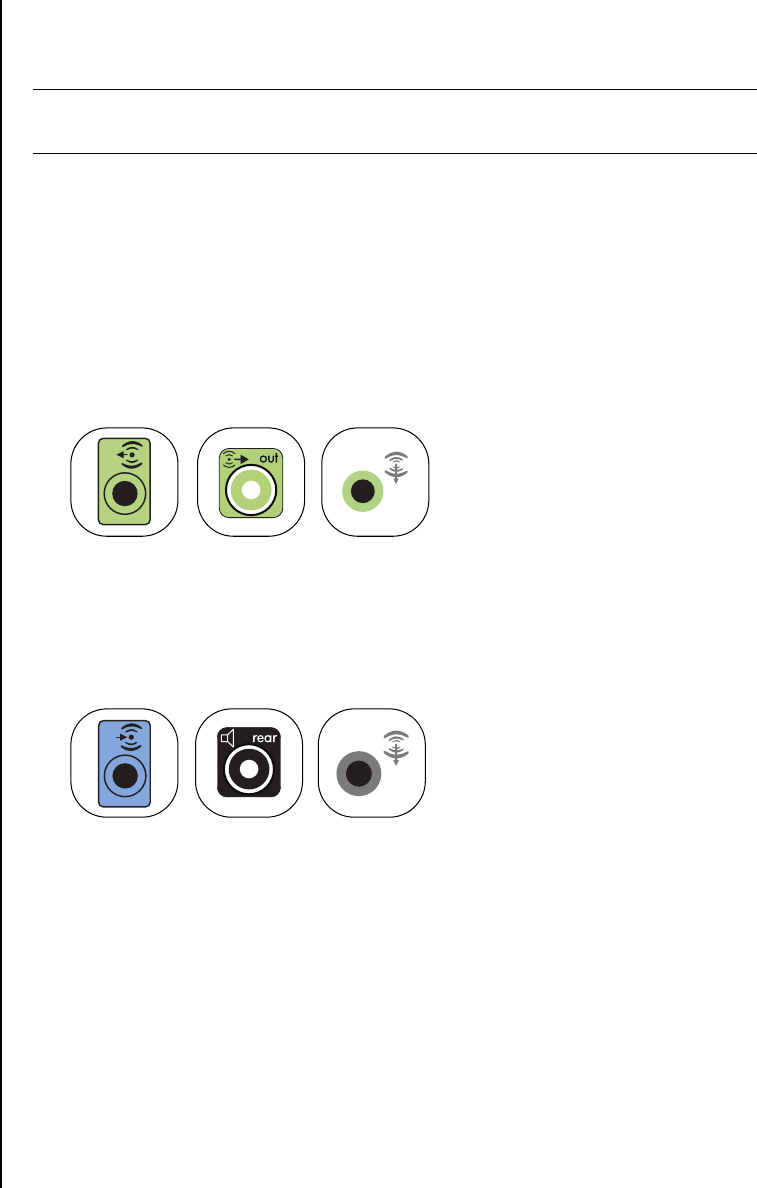
34 Getting Started Guide
5.1 (5 speakers and a subwoofer) home audio
installation procedure
To connect a six-channel (5.1 speaker) home audio system to the PC:
1Turn off the PC.
2Turn off the receiver/amplifier.
3Connect the front stereo mini-jack end of a Y adapter cable into the lime-green
Audio Line Out connector that matches the back of your PC:
•Type 3 is three connectors
•Type 6 is six connectors
•Type S is sound card
Connect the left and right ends of the Y adapter cable into the front left (L) and
right (R) inputs on the back of the receiver/amplifier.
4If you have rear speakers, connect the rear stereo mini-jack end of a Y adapter
cable into the Audio Line In (blue) or the rear speaker out (black) connector that
matches the back of your PC.
Connect the left and right ends of the Y adapter cable into the rear left (L) and
right (R) inputs on the back of the receiver/amplifier.
NOTE: Receiver/amplifier input connectors may be labeled Surround, 5.1, or
6 Channel inputs, CD, DVD, or DVD In.
OUT
36S
IN
36S
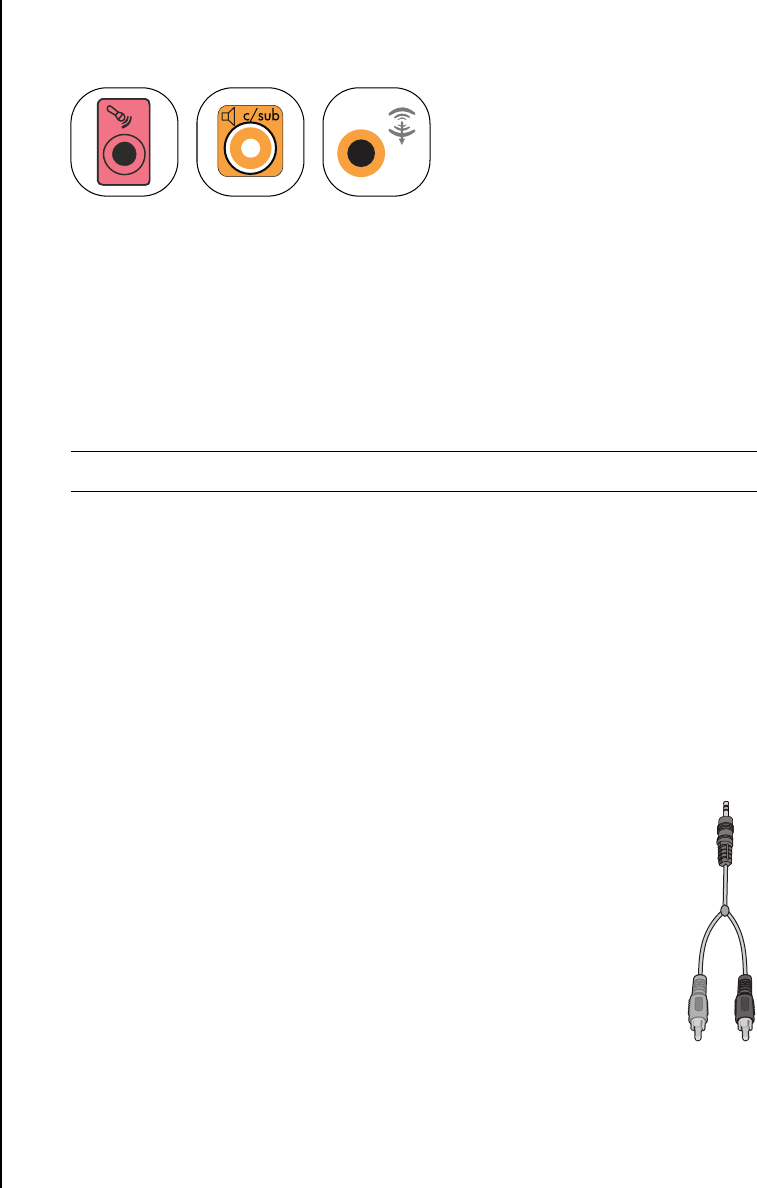
Configuring Speaker and Sound Options 35
5Connect the stereo mini-jack of a Y adapter cable into the microphone (pink)
connector or the center speaker/subwoofer (gold) connector that matches the
back of your PC.
•Connect the left and right ends of the Y adapter cable into the center/
subwoofer inputs on the back of the receiver/amplifier (5.1 or higher
channel system).
•Plug the Y adapter cable into the subwoofer connector on the back of the
receiver even if a subwoofer is not used.
6Turn on the receiver/amplifier.
7Select the receiver/amplifier input that the Y adapter cables are plugged into.
8Turn on the PC.
9After the audio system is connected to the PC, configure the audio software for
sound output for your PC model:
•Type 3 connectors: See “Configuring Audio Output with Multi-channel
Sound Manager” on page 37.
•Type 6 connectors: See “Configuring Audio Output with Sound Effect
Manager” on page 38.
Connecting Digital Audio
(Select models only)
If you have a sound card and you are connecting your home stereo
AV receiver via Digital Out, plug the 3.5-mm stereo plug into the Digital
Out connector on the sound card. Connect the red RCA stereo plug in
the 3.5-mm Y cable to the AV receiver’s digital input connector. If the red
RCA stereo plug does not work, try the white stereo plug. One of the
connectors is not used.
To connect digital audio, your PC must include a digital out connector on
the sound card or on the back panel. You do not need to connect
multichannel speaker outputs if you connect the digital output.
NOTE: Always turn on the PC before you turn on the speaker system.
36S

36 Getting Started Guide
To connect digital audio speakers:
1Turn off the PC.
2Connect the digital input (S/PDIF) on the digital speakers or a digital audio
system to the orange digital out connector that matches the back of your PC:
•Type 3 is three connectors
•Type 6 is six connectors
•Type S is sound card
3Turn on the PC.
4Plug in the speaker system power.
5Turn on the speaker system.
6After the speakers are connected to the PC, configure the audio software for
sound output for your PC model:
•Audio card with digital output and type 3 connectors: See “Configuring
Audio Output with Multi-channel Sound Manager” on page 37. Follow the
instructions to enable digital audio output.
•Audio card with digital output and type 6 connectors: See “Configuring
Audio Output with Sound Effect Manager” on page 38. Digital audio
output is already enabled as the default.
Configuring Audio Output
You can configure your speaker’s audio output with the following software. Use the
software that applies to your PC model:
•WinDVD Player
•Multi-channel Sound Manager (type 3 connectors)
•Sound Effect Manager (type 6 connectors)
•Realtek HD Sound Effect Manager (multi-streaming audio)
NOTE: Always turn on the PC before you turn on the speaker system.
DIGITAL
AUDIO OUT
36S
DIGITAL
AUDIO OUT
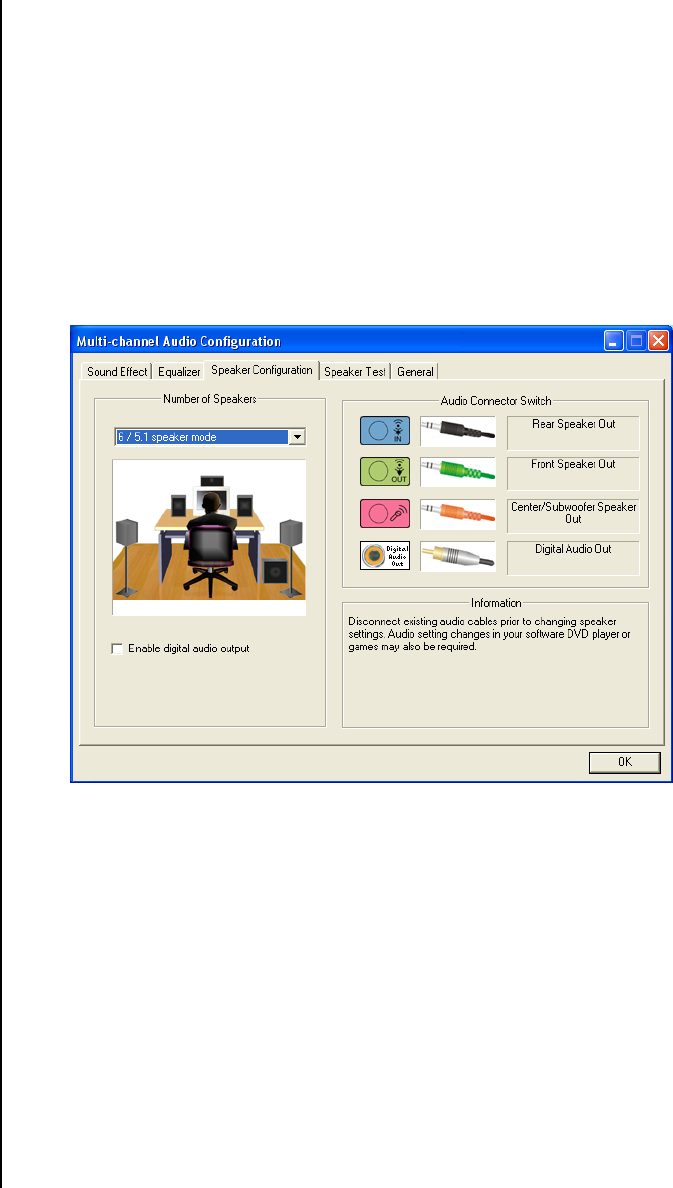
Configuring Speaker and Sound Options 37
Configuring Audio Output with Multi-
channel Sound Manager
If your PC model has type 3 connectors, follow these steps after you have installed
and connected your speakers.
To configure multichannel audio output for PCs with Multi-channel Sound Manager:
1Click Start on the taskbar.
2Choose All Programs.
3Click Multi-channel Sound Manager. The Multi-channel Audio
Configuration window opens with one of five control screens.
•Sound Effect — Select the environment settings.
•Equalizer — Equalize the audio frequencies.
•Speaker Configuration — Select the number of speakers. The Audio
Connector Switch indicates the speaker configuration.
•Speaker Test — Test all connected speakers for correct configuration.
•General — View driver and audio information.
4Click the Speaker Configuration tab near the top of the window to open
the control screens. (Your speakers may need to be plugged in to see this tab.)
5Select the option describing the number of speakers in your system, in a range
from 2/2.1 speaker mode to 5.1 speaker mode.
6Enable digital audio if you want digital audio output. See “Enabling digital
audio output with Multi-channel Sound Manager (optional)” on page 38.

38 Getting Started Guide
7Click OK.
8Test the speakers. Click the Speaker Test tab. Follow the instructions.
9Configure audio output for the WinDVD Player. See “Configuring Audio for
WinDVD Player” on page 47.
Enabling digital audio output with Multi-channel
Sound Manager (optional)
Your PC must include a digital audio out connector on the back panel.
To enable digital audio output:
1Follow steps 1 through 5 of the previous procedure, “Configuring Audio Output
with Multi-channel Sound Manager.”
2Place a check next to Enable digital audio output. The Output digital and
analog option is automatically selected.
3Connect the digital audio output connector on the back of your PC to your
home audio system’s digital audio input.
4Select your stereo system’s digital audio input.
5Click OK.
6Test the speakers, by playing a CD, for example. (If you test using a DVD, you
need to configure WinDVD first. See “Configuring Audio for WinDVD Player”
on page 47.)
7Configure audio output for the WinDVD Player. See “Configuring Audio for
WinDVD Player” on page 47.
If you select Enable digital audio output, the microphone volume setting
becomes not muted, and the recording source is fixed in Stereo Mix. If you place the
microphone too close to the speakers, feedback can occur.
Configuring Audio Output with Sound
Effect Manager
Follow these steps after you have installed and connected your speakers, if your PC
model has type 6 connectors.
1Click Start on the taskbar.
2Click Control Panel.
3Click Sounds, and then Speech and Audio Devices (or Sounds and
Audio Devices).
NOTE: A connector with no descriptive text in the Connection Guide indicates that
the connector is not used for the selected speaker configuration.

Configuring Speaker and Sound Options 39
4Click Sound Effect Manager. The window opens.
5Click the Speaker Configuration tab.
6Select the option describing the number of speakers in your system in a range
from 2.1 Speaker to 7.1 Speaker.
7Click the Speaker Test button to test the speakers.
8Click OK.
9Configure audio output for the WinDVD Player. See “Configuring Audio for
WinDVD Player” on page 47.
The Sound Effect Manager control screens
• Sound Effect — selects the Environment and the Equalizer settings. You can
select an environment such as Under Water or Auditorium. To use the Equalizer,
click the Power button in the center of the circular equalizer control to turn it on.
You can click a preset button, such as Pop or Live, or manually adjust the
settings and then save them for easy selection later.
• Speaker Configuration — selects the number of speakers, shows the
Connection Guide, and has the Speaker Test button to test the speakers. A
connector with no descriptive text in the Connector Guide indicates that the
connector is not used for the selected speaker configuration.
• Digital Audio — selects the digital audio output and digital audio frequency
for the digital audio connectors on the PC.
•Audio Wizard — opens a window that shows the connector panel on the
front of the PC. To close the window without enabling the wizard, click OK.
To enable the Audio Wizard:
Make sure the Enable auto detection check box is selected to enable the wizard.
Click OK to close the window.
Using the Audio Wizard in the Sound Effect
Manager
The Sound Effect Manager Audio Wizard can help you connect front-panel audio.
To use the Audio Wizard:
1Turn on the PC.
2Click Start on the taskbar.
3Choose Control Panel.
4Click Sounds, then Speech and Audio Devices (or Sounds and Audio
Devices).
5Click Sound Effect Manager. The window opens.

40 Getting Started Guide
6Click Audio Wizard. A window opens that shows the connector panel on the
front of the PC.
7Place a check in the Enable jack detection check box to enable the wizard.
8Connect the speaker system audio cable plugs into the connectors on the front
of your PC. The panel display highlights a cable that is properly inserted in a
connector.
9Close the window.
Retasking front-panel connectors
With the Audio Wizard enabled, both the microphone connector and the
headphones connector on the front of the PC can be retasked to perform a different
audio function. These two connectors are universal audio jacks. When you plug in a
cable, the wizard asks you to select the function for the cable from a list, and then it
sets the universal audio jack to perform as the selected function. The functions are:
•Stereo Speaker (Out)
•Microphone (In)
•Headphone (In)
•Audio Line In
To retask front-panel connectors:
1Follow steps 1 through 7 of the procedure, “Using the Audio Wizard in the
Sound Effect Manager” on page 39.
2When you plug in a cable, the wizard asks you to select the device you
plugged in from a list.
3Close the window.
Disabling digital audio output with Sound Effect
Manager (optional)
To disable digital audio output:
1Open the Sound Effect Manager:
Click Start, Control Panel, Sounds, Speech, and Audio Devices, and
then Sound Effect Manager.
2Click Audio Wizard. A window opens displaying the connector panel on the
front of the PC.

Configuring Speaker and Sound Options 41
3Click the Digital Audio button. Select Digital output off (you can also
select Digital-in to Digital-out pass through mode).
4Close the window.
If you select Enable digital audio output, the microphone volume setting
becomes active, the recording source is fixed in Stereo Mix, and if you place the
microphone too close to the speakers, feedback can occur.
Configuring Audio Output with
Realtek HD Sound Effect Manager
Follow these steps after you have installed and connected your speakers, if your PC
model has type 6 connectors and is capable of multi-streaming audio.
To configure multichannel audio output for PCs with Realtek HD Sound Effect
Manager:
1Click Start on the taskbar.
2Click Control Panel.
3Click Sounds, then Speech and Audio Devices (or Sounds and Audio
Devices).
4Click Realtek HD Sound Effect Manager. The window opens.
5Click a button near the top of the window to see that control screen.
The Realtek HD Sound Effect Manager control screens
• Sound Effect — selects the Environment and the Equalizer settings. You
can select an environment, such as Under Water or Auditorium. To use the
Equalizer, click the Power button in the center of the circular equalizer control to
turn it on. You can click a preset button, such as Pop or Live, or manually adjust
the settings and then save them for easy selection later.
•Mixer — allows control over volume, playback, mute, recording, and
multi-streaming audio. Click the Multi-streaming setting button to set up
multi-streaming.
•Audio I/O — selects the number of speakers, shows the whether the plugs are
analog or digital, and selects the digital audio output and digital input device.
Only speakers being used are displayed.
•Microphone — allows fine control over the microphone/recording quality.
Includes buttons for noise suppression and acoustic echo cancellation.
NOTE: If you do not see the device for your configuration, change the speaker
selection in the Speaker Configuration window.

42 Getting Started Guide
Configuring the Realtek HD Sound Effect
Manager
1Click the Audio I/O tab.
2Select the option describing the number of speakers in your system — for
example, 7.1 speakers.
3Only connectors being used are shown; if the connector is not shown it means
that it is not used for the selected speaker configuration.
4Click OK.
To hear DVD movies recorded with multi-channel audio from all speakers, change
the audio properties for the DVD player software program to match your speaker
configuration (if your DVD program supports more than two channels).
To use a microphone or set up the PC for recording, see “Configuring sound for
recording with the Realtek HD Sound Effect Manager” on page 42.
To use Multi-streaming Audio, see “Configuring Multi-streaming Audio” on page 43.
Configuring sound for recording with the
Realtek HD Sound Effect Manager
The microphone connector is ready to use for recording sound. If you want to use
another connector for recording, such as the Digital Audio In connector, use these
steps to select it.
1Click Start on the taskbar; then Control Panel, Sounds, Speech, and
Audio Devices, and then Realtek HD Sound Effect Manager.
2Click the Mixer tab.
3In Record click the drop-down list. Choose:
•RealTek HD Digital Input to use the digital audio in connector (select
models only).
•Line in/Mic in to use the Audio Line In (In) or the Microphone (Mic)
connectors.
4Click OK to close the window.
NOTE: The front pink and green connectors can be retasked to perform other audio
functions; refer to “Retasking front panel audio connectors” on page 43.

Configuring Speaker and Sound Options 43
Retasking front panel audio connectors
The pink and green connectors on the front of the PC connectors can be retasked as
needed.
1Click Start on the taskbar; then Control Panel, Sounds, Speech, and
Audio Devices, and then Realtek HD Sound Effect Manager.
2Click the Audio I/O tab.
3Click the tool icon in the Front Panel section. The connector settings
window displays.
4Select Enable Jack detection when device is plugged in, and click OK.
The front pink and green connectors can now be used as input or output devices.
Configuring Multi-streaming Audio
The Realtek HD Sound Effect Manager software allows you to listen to two different
audio sources on two different speaker sets.
For example, you hear one audio source through a rear-panel speaker connection
and a second source through a front-panel headphone or speaker connection. You
must configure Multi-streaming Audio for your system if you want to hear two audio
sources on separate speakers.
Audio output overview
The front-panel audio output is the stereo headphone (green) connector only.
The rear-panel outputs are the speaker connectors that can be set up as multi-
channel out from stereo (2.1) to 7.1 (select models only) configurations. Refer to
your user documentation for powered speakers or AV receiver setup information.

44 Getting Started Guide
Audio input overview
You can select two of the following audio sources to play through front-panel
headphone and rear-panel speaker connectors:
1From an externally connected device source, such as:
•A microphone with cable connected to Mic In (pink).
•An MP3 player cable connected to Line In (blue).
2From an internal source inside or directly connected to the PC, audio files may
reside on: hard disk drives, DVDs, CDs, USB drives, HP Personal Media Drives,
or any connected device. Play internal media files through programs such as:
•Windows Media Player
•WinDVD
•HP Tunes
•Other installed media player software
When to use multi-streaming audio
You may multi-stream two audio sources as described in the following typical
examples:
1For online gaming, where you hear 5.1 game sound on your AV receiver or
powered speakers, while you also hear gaming conversation on your headset.
See “Example 1: For Online Gaming” on page 45.
2For digital home entertainment, where you hear:
•DVD sound on your living room TV/display or AV receiver from the rear
speaker connections.
•While you also hear your PC headphone or powered speakers that are
connected to the front panel green headphone jack, from one of the
following external PC audio sources:
aFront panel Line In
bInternal source residing on: a hard disk drive, DVD, CD, USB Drive, or
other external device.
See “Example 2: For Digital Home Entertainment” on page 46.
NOTE: Digital Audio In cannot be multi-streamed.

Configuring Speaker and Sound Options 45
Setting up multi-streaming audio
Example 1: For Online Gaming
To configure multi-streaming audio output for online gaming with Realtek HD Sound
Effect Manager, you must enable Voice-Over-IP software (software used to converse
over the Internet). Other players hear your voice from the microphone via the
Internet and you hear the game audio from the rear speakers:
1Connect the audio input and output connectors to:
•A headphone set to the front Headphone Out (green) connector.
•A microphone to the front Mic In (pink) connector for online conversation.
•A set of powered stereo 5.1, or 7.1 speakers to the rear Speaker Out
connectors for gaming sound output.
2Click the Realtek HD Audio Manager icon on the system tray to
open the Realtek HD Audio Sound Effect Manager window.
3Choose the Mixer tab.
4Click the Multi-streaming setting audio button. The dialog box
opens.
5Select the Enable multi-streaming playback check box.
6Select one of the following options to determine how you would like to hear
your own voice:
•Check the Output Mic In/Line In to front panel check box, and
select OK.
•Check the Output Mic In/Line In to rear panel check box, and
select OK.
7Select Realtek HD Audio rear output from the drop-down list.
8Start the game that you are about to play. You should hear the gaming sound
on the rear stereo, 5.1, or 7.1 speakers.
9At the Mixer tab, select Realtek HD Audio front output to enable audio
conversation with your teammates.
NOTE: To ensure you have sound output, go to the Mixer window and check that
the setting of the front pink microphone is not on mute.

46 Getting Started Guide
Example 2: For Digital Home Entertainment
To configure multi-streaming audio output for digital home entertainment with Sound
Effect Manager:
1Connect the audio output connectors to:
•A headphone set or powered speakers connected to the front Headphone
Out (green) connector for stereo music playback.
•A set of powered stereo, 5.1, or 7.1 speakers connected to the rear
Speaker Out connectors for DVD playback sound output.
2Click the Realtek HD Audio Manager icon on the system tray to
open the Realtek HD Audio Sound Effect Manager window.
3Choose the Mixer tab.
4Click the Multi-streaming setting audio button. The dialog box
opens.
5Select the Enable multi-streaming playback check box, and
select OK.
6Select Realtek HD Audio rear output from the drop-down list.
7Open WinDVD to play a DVD movie. You should hear the DVD sound on the
rear speakers.
8Select Realtek HD Audio front output from the drop-down list.
9Open Windows Media Player to play music. You should hear the music sound
on the front headphone connection.
10 To hear an external device source from the Line In or Mic In connection:
aClick the Multi-streaming setting audio button. The dialog box
opens.
bCheck the Output Mic In/Line In to front panel check box in the
dialog box, and select OK.

Configuring Speaker and Sound Options 47
Configuring Audio for WinDVD Player
Follow these steps after you have installed, connected, and configured your
speakers.
The InterVideo WinDVD program (select models only) is set up for two-speaker
(stereo) output. To hear all speakers from DVD movies recorded with multichannel
audio, change the audio properties for WinDVD to match your speaker
configuration (if your InterVideo WinDVD program supports more than two
channels).
If you want to play a stereo DVD, you may change the audio properties of WinDVD
to match the recorded DVD audio output.
1Insert a DVD.
Or
Click Start, choose All Programs, InterVideo WinDVD, InterVideo
WinDVD Player, and then click InterVideo WinDVD. The WinDVD video
window opens.
2Right-click anywhere in the WinDVD video window, and then click Setup. The
Setup window opens.
3Click the Audio tab.
4Select Audio Output Configuration. Choose Analog or Digital
(S/PDIF). Click Apply.
5Select Audio Speaker Configuration. Click the option for the number of
speakers to match your multichannel speaker system.
6You can click the Test button to test the speakers. You should be able to hear
the speakers. Click Stop, and then click OK.
Using Headphones
Your PC comes with a headphones connector (lime-green) on the front of the
PC. The headphones connector is labeled with a headphones icon.
You can also connect headphones to the Line Out connector (lime-green) on
the back of your PC.
Using a 2.1 speaker system with headphones
For select models with the 2.1 speaker system, look for the headphones connector
on the right side of the main speaker. When headphones are plugged in, the sound
to the speakers and the subwoofer is muted.
OUT

48 Getting Started Guide
Using a 5.1 to 7.1 speaker system with
headphones
For select models that include a 5.1 or higher speaker system, a headphones
connector is located on the right side of the control tower.
If the control tower displays HP (for headphones), the headphones are enabled; the
sound to the speakers and the subwoofer is muted.
•Push and hold the On button on the control tower for several seconds to enable
sound from the speakers.
•Press the On button briefly to enable the headphones.
Selecting recording devices
(Type 6 connectors only)
To select a sound recording device:
1Click Start on the taskbar.
2Choose Control Panel.
3Click Sounds and Audio Devices (or Sounds, Speech, and Audio
Devices). The Sounds and Audio Devices window opens.
4Click the Audio tab. The window opens.
5In Sound Recording, select a recording device; for example, Realtek HD Front
Pink Jack.
6Click OK.
7Close the window.
Resolving Sound Issues
If you don’t have sound from your speakers, check the following:
•Check volume and mute settings. See “Using Headphones” on page 47.
•Use active, powered speakers, or speakers with an amplifier.
•Verify cable connections.
•Make sure the software program and sound software are configured.
•Some programs may result in low volume, even when the Volume knob is turned
to the maximum position. If this is the case, double-click the Volume icon on
the taskbar, and increase the volume.
•Reconfigure the sound software for surround sound.
•Reinstall the sound card drivers by using HP Application Recovery. See
“Application Recovery” in the PC Troubleshooting and Maintenance Guide.
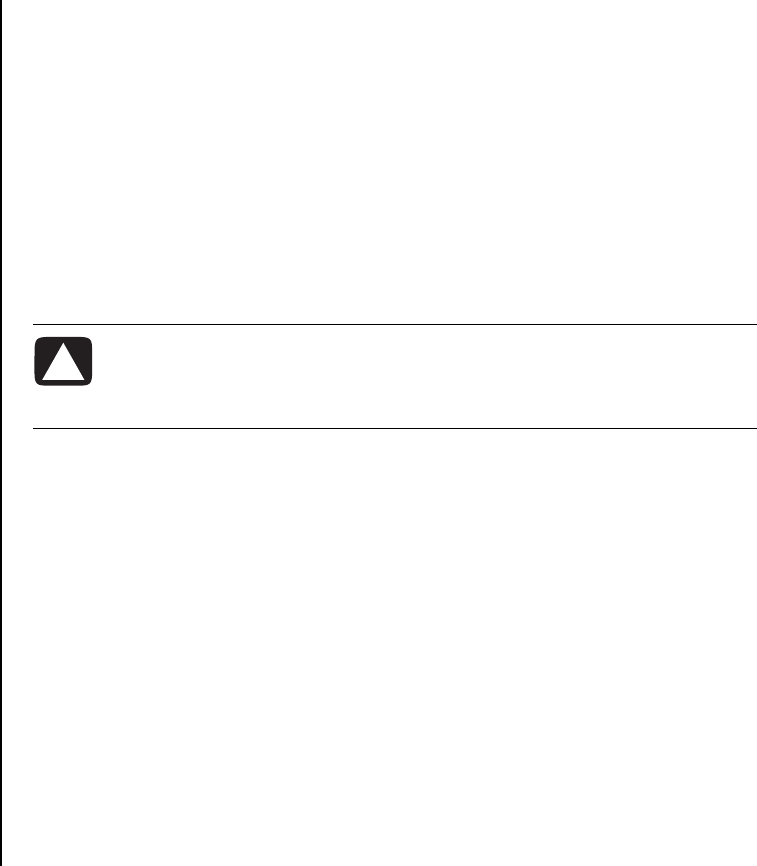
Using the Memory Card Reader 49
Using the Memory Card Reader
Digital cameras and other digital imaging devices use memory cards, or media,
to store digital picture files. The optional memory card reader (select models only)
can read and write to a variety of types of memory cards and the IBM Microdrive
disk drive.
The card reader is accessible directly on the front of the PC or located inside a
cover. It has two or four horizontal card slots, which accept the memory cards and
the Microdrive disk drive.
You can place media in one or more of the card slots and use each media
independently. Place only one piece of media in a slot at one time.
Each card slot has its own drive letter and icon. When you insert media, the display
label may change to the title of the media, if the title is present.
If you open the Safely Remove Hardware window by mistake, click Close.
CAUTION: Do not click Stop in the Safely Remove Hardware window
with the USB Mass Storage Device selected. Doing so removes the
operating system recognition of the memory card reader from your
PC; you must restart the PC to see your memory card reader again.

50 Getting Started Guide
Using the Memory Card Reader
1Insert the media into the card slot until it stops.
The activity light (A) on the memory card reader lights, and the PC
automatically detects the media.
2The PC opens a window so you can use the media contents. You can copy files
from or to the media.
3When you are finished, right-click the drive icon, select Eject, check that the
activity light is on but not blinking, and then remove the media. A steady
activity light indicates that the PC is not reading or writing the media.
NOTE: Media must be inserted correctly. Note the direction of the notched
corner on the media. See the “Media Insertion Guide” on page 51.
CompactFlash and Microdrive are keyed and cannot be inserted incorrectly.
Insert the receptacle edge (holes) of this media into the slot.
WARNING: Do not try to remove media when the activity light is
blinking; doing so may cause loss of data.
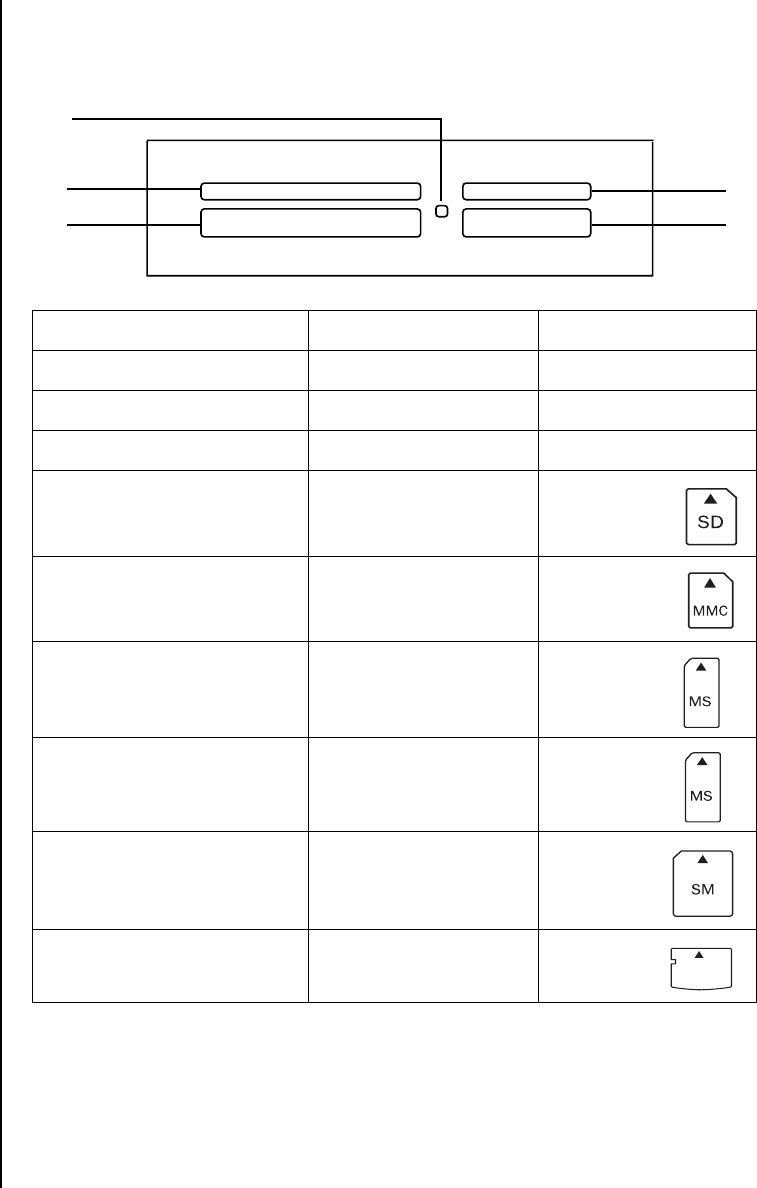
Using the Memory Card Reader 51
Media Insertion Guide
4-slot memory card reader (select models only)
Card Insert Into 4-slot reader
CompactFlash Type I media Receptacle edge (holes) C (lower-left)
CompactFlash Type II media Receptacle edge (holes) C (lower-left)
IBM Microdrive disk drive Receptacle edge (holes) C (lower-left)
Secure Digital (SD)
Memory Card Facing up D (upper-right)
MultiMediaCard (MMC) Facing up
D (upper-right)
Memory Stick (MS)
Memory Card Facing up
E (lower-right)
Memory Stick (MS-Pro)
Memory Card Facing up
E (lower-right)
SmartMedia (SM)
Memory Card Facing up
B (upper-left)
xD media Facing up B (upper-left)
AA
ct
i
v
i
ty
li
g
h
t
BUpper-left slot
CLower-left slot
DUpper-right slot
ELower-right slot
A
E
D
B
C
xD
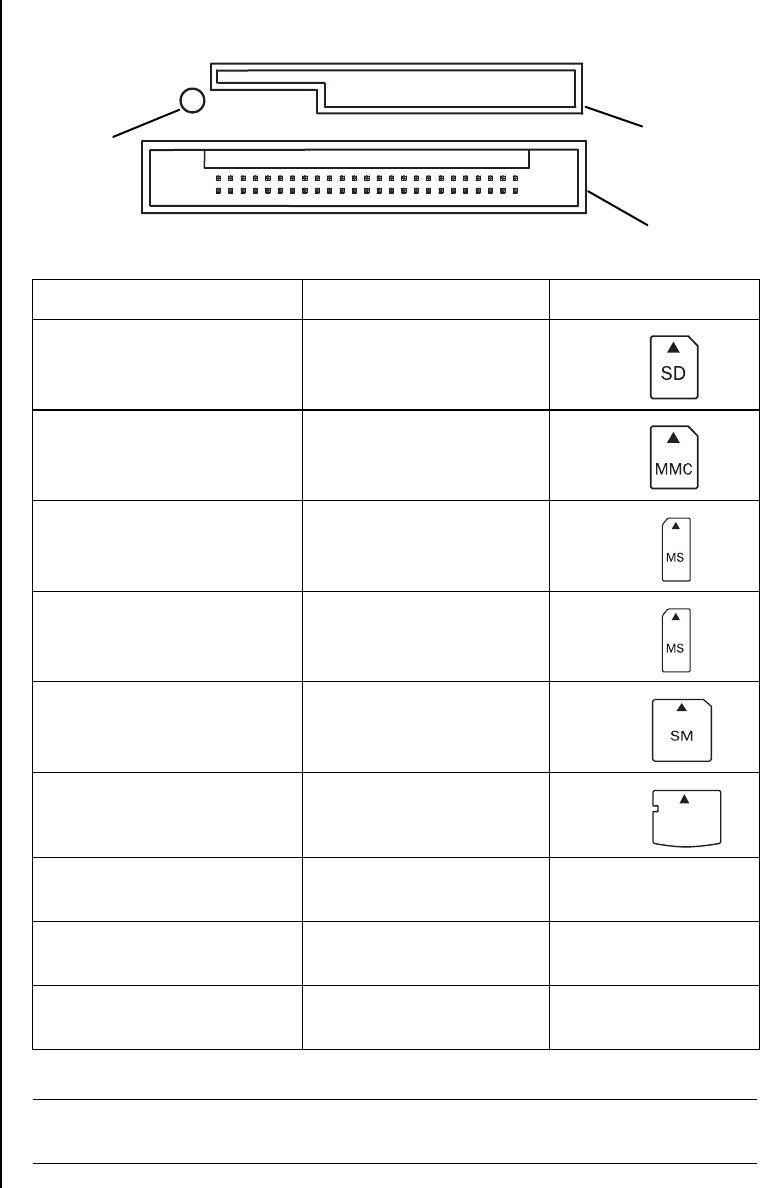
52 Getting Started Guide
2-slot memory card reader (select models only)
Card Insert Into 2-slot reader
Secure Digital (SD)
Memory Card Label up (gold connector
fingers down) F (Upper)
MultiMediaCard (MMC) Label up (gold connector
fingers down) F (Upper)
Memory Stick (MS)
Memory Card Label up (gold connector
fingers down) F (Upper)
Memory Stick (MS-Pro)
Memory Card Label up (gold connector
fingers down) F (Upper)
SmartMedia (SM)
Memory Card Label down (gold
connector fingers up) F (Upper)
xD media Label up (gold connector
fingers down) F (Upper)
IBM Microdrive disk drive Receptacle edge (holes)
(label up) G (Lower)
CompactFlash Type I media Receptacle edge (holes)
(label up) G (Lower)
CompactFlash Type II media Receptacle edge (holes)
(label up) G (Lower)
NOTE: Do not use SM and xD media in the memory card reader at the same time.
Only the first one inserted is recognized by the memory card reader.
AA
ct
i
v
i
ty
li
g
h
t
FUpper slot
GLower slot
AF
G
xD
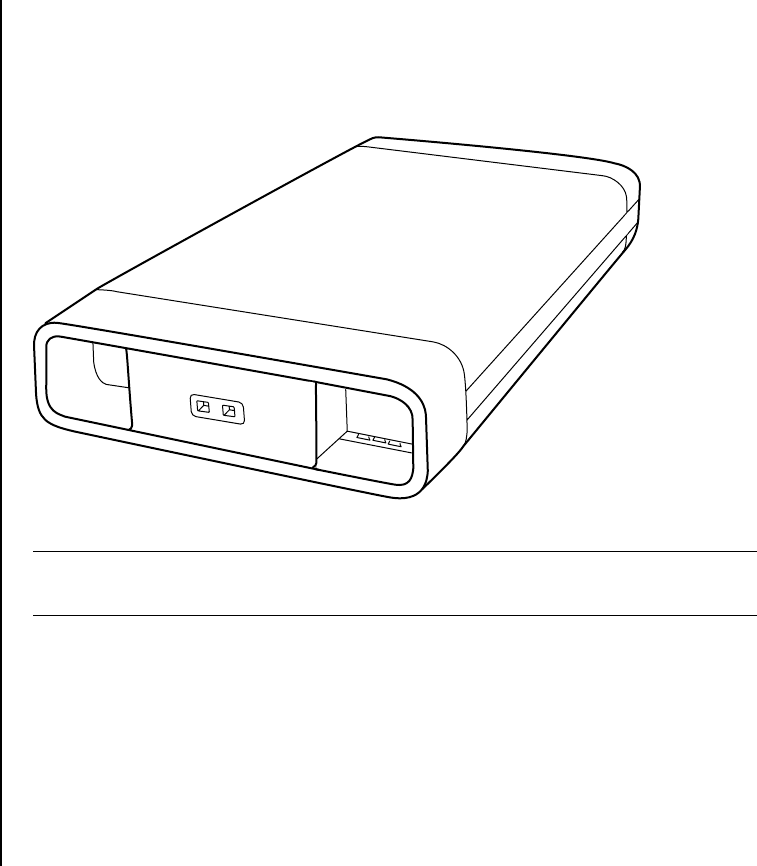
Using the HP Personal Media Drive 53
Using the HP Personal Media Drive
The HP Personal Media Drive (sold separately) can be used as an internal or
external USB hard disk drive designed to quickly and easily increase your storage
capacity and to transfer media files such as digital photos, music, videos, and other
important files. You can also use the HP Personal Media Drive to back up other
drives on your PC.
NOTE: Before starting the System Recovery Program, remove the HP Personal
Media Drive. See your System Recovery documentation.
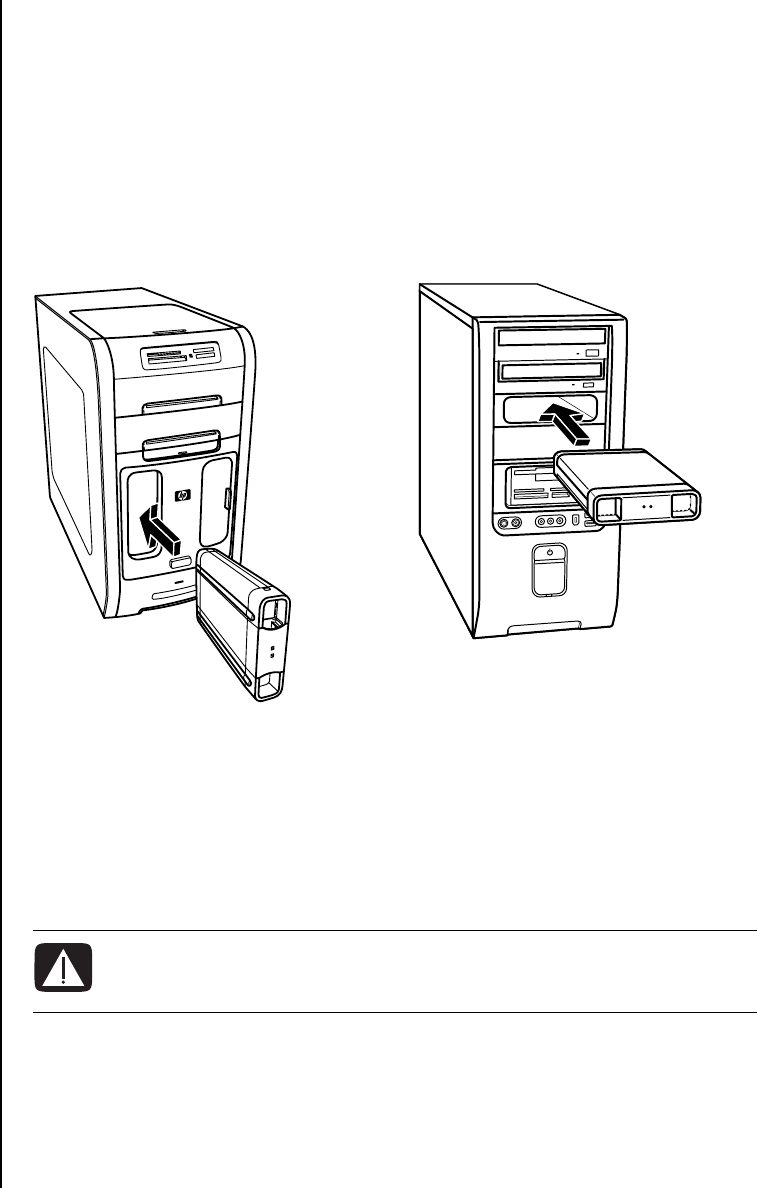
54 Getting Started Guide
Connecting the Drive
As an external drive, the HP Personal Media Drive connects and disconnects easily
from a USB 2.0 connector on the front or the back of most PCs. The drive comes
with software, an external USB cable, and an external power cord and power
adapter. For information about connecting and using the HP Personal Media Drive
as an external drive, refer to the documentation that came with the HP Personal
Media Drive.
For some PCs (select models only), the HP Personal Media Drive is designed to fit
inside a horizontal or vertical drive bay.
This special drive bay includes an internal USB port and power cable that connect
to the drive when it is inserted.
The drive turns on when it is plugged into an active USB port. If the PC is turned on
with the drive connected, the drive automatically turns on. When the USB cable for
the drive is not plugged in or when the USB power from the PC is turned off, the
drive automatically turns off. When the PC is in standby mode (a reduced power
state), the drive remains turned on.
WARNING: Do not move the PC with the HP Personal Media Drive
inserted in the bay or connected to a USB port on the PC. This can
cause damage to the drive and cause data loss.
NOTE: T
h
e
d
rive can
b
e
easily inserted and
removed from the bay
without turning off the
PC. This feature is
sometimes referred to as
w
arm swappable.
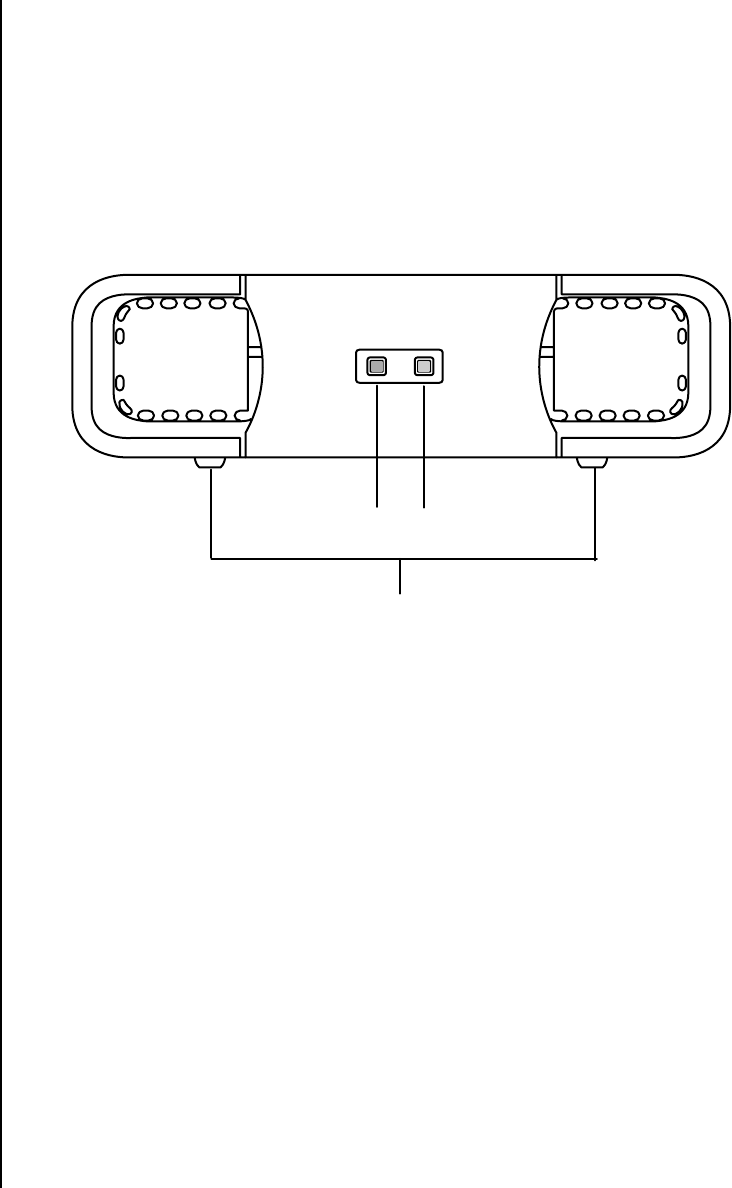
Using the HP Personal Media Drive 55
Inserting the Drive
1Turn on the PC.
2Line up the ridges on the bottom of the drive with the two slots on the side or the
bottom of the PC drive bay. Do not force the drive into the bay; it should slide
easily into the bay.
3Slide the drive all the way into the drive bay until the drive is firmly connected
to the internal power and USB port. With the PC turned on, the power indicator
(B) on the front of the drive is lit when the drive is inserted correctly.
A
C
B
A
Drive activity in
d
icator
light
BPower on indicator
light
CHP Personal Media
Drive guide ridges

56 Getting Started Guide
Locating the Drive and Assigning a
Drive Letter
After you insert the drive into the PC, you can find the drive in My Computer. The
operating system automatically assigns a letter to the drive. The assigned letter
depends on the other storage devices connected to the PC.
To locate the drive:
1Click Start on the taskbar.
2Click My Computer.
3Select the drive under Hard Disk Drives. The default name is HP Personal Media
Drive.
You can permanently assign a drive letter to avoid the letter changing when you
connect and disconnect this drive and other devices. Also, it is easier for a software
program to locate the files on the HP Personal Media Drive if a drive letter is
assigned. Some programs may not be able to find files if the drive has a new drive
letter.
It is best to always remove your drive safely to avoid errors. See “Disconnecting the
Drive” on page 58.
To assign a drive letter:
1Click Start on the taskbar.
2Right-click My Computer.
3Select Manage and then click Disk Management.
4Right-click the HP Personal Media Drive.
5Select Change Drive Letter and Paths.
6Click Change, and select a letter. Then apply the changes by clicking OK.
The default volume label of this drive is HP Personal Media Drive. You can rename
the drive in the My Computer window by right-clicking the drive, selecting
Rename, and then typing a new name. Rename the drive if you have more than
one HP Personal Media Drive.
NOTE: To avoid multiple
hard disk drives using the
same drive letter, when
connecting and removing
the drives, assign the
letter Z to the HP Personal
Media Drive.

Using the HP Personal Media Drive 57
Using the Drive
When running for long periods of time, the aluminum case of the HP Personal
Media Drive may become very warm. This is part of the HP Personal Media Drive’s
advanced design and is completely normal.
The built-in, low-noise fan is designed to automatically turn on at pre-set
temperatures. If you are using the HP Personal Media Drive connected externally to
your PC, please place the drive in a well-ventilated area.
To store files
The best way to transfer files to the HP Personal Media Drive is to drag them from
your local hard disk drive. This allows you to place files in specific folders. Refer to
the following procedures for more detailed instructions about creating linked folders.
To play media files
You can play media from an HP Personal Media Drive:
1Click Start on the taskbar.
2Click My Computer.
3Double-click the HP Personal Media Drive icon to locate your media file.
4Double-click the file. Most media files open in Windows Media Player.
To play music files
You can play music files that are stored on the HP Personal Media Drive:
1Click Start on the taskbar, click My Computer, and then double-click the
HP Personal Media Drive icon.
2Create a personal music folder by right-clicking the drive window and choosing
New and then Folder. Type a name for your personal music folder.
3Drag or copy your music files into this created folder.
4Open Windows Media Player by clicking Start, All Programs, and then
clicking Windows Media Player.
5In the Windows Media Player window, click Tools, select Options, and then
select the Media Library tab.
6Click the Monitor Folders button.
7Click Add to add a pathway to your HP Personal Media Drive.
8Browse to locate your created music file folder on your HP Personal Media
Drive, and then click OK.
9Click OK, and then OK again to close the Options window. Now your music
files on your HP Personal Media Drive appear in the Windows Media Player
library when your drive is connected to the PC.
When you disconnect the drive, your music files may still appear in the Windows
Media Player Library. To refresh your PC, open and close Windows Media Player. If
that doesn’t work, restart the PC.

58 Getting Started Guide
Disconnecting the Drive
You can safely remove the drive when it is not active. When the amber activity light
is blinking, the drive is active, saving or transferring data. Removing the drive while
the light is blinking may cause data loss or damaged files.
To disconnect the HP Personal Media Drive safely:
1Close all programs that may be accessing your HP Personal Media Drive. Make
sure that the activity light on the drive is off.
2Double-click the Safely Remove Hardware icon in the system tray
(on the Start taskbar). If this icon is hidden, click the arrows on the
taskbar to display it. The Safely Remove Hardware window opens.
3Double-click USB Mass Storage Device to locate your HP Personal Media
Drive. USB Mass Storage Device may be listed twice. One may contain a
memory card reader or other mass storage drive.
4Select the HP Personal Media Drive, and then click OK. The name of the
drive may be different if you renamed it, or it may appear as Generic Volume
followed by the assigned drive letter.
A Safe to Remove Hardware message appears in the system tray, letting you
know that the device is safe to disconnect.
5Click Close.
6Disconnect the drive by removing it from the drive bay.

Working with Digital Images 59
Working with Digital Images
You can connect a digital image source, such as a digital camera or a digital video
camera, directly to the PC or through a docking station. Digital picture files you
copy or download from the device appear in the My Pictures folder. You can copy
digital picture files from the memory cards used by digital cameras and other digital
imaging devices by using the memory card reader (select models only). Refer to
“Using the Memory Card Reader” on page 49.
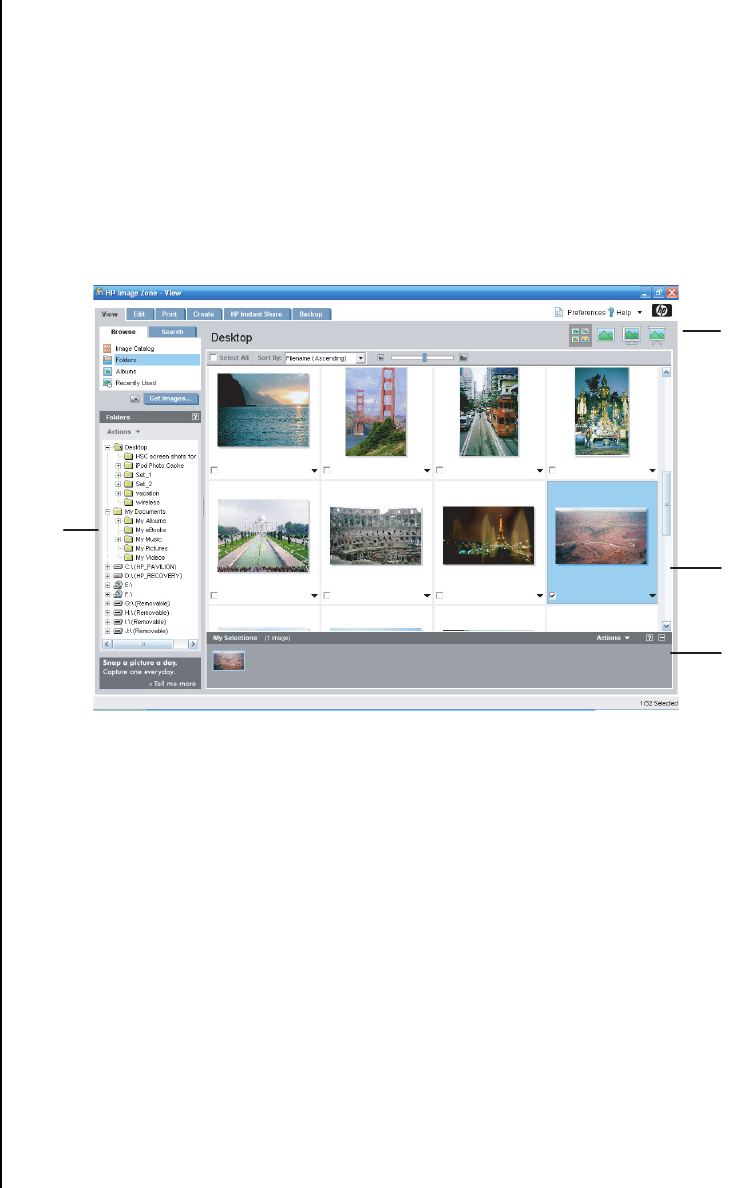
60 Getting Started Guide
Using HP Image Zone
Use the HP Image Zone software program to manage your photos, scanned images,
and video clips. It has all the tools you need for viewing, organizing, editing,
printing, sharing, and protecting digital images.
To open HP Image Zone:
Click Start on the taskbar, All Programs, HP, and HP Image Zone.
The HP Image Zone window opens.
Click a tab at the top of the application window (A) to choose the desired function
screen, as described in the following list.
View Click this tab to find, view, and manage single or multiple photos or video
clips. At the top of the control area (B), click Image Catalog to view all your
images, or choose Folders to browse for images. To select the images that you
want to print or use, click the image (or images) in the work area (C), and it appears
in the selection tray (D). The selection tray images appear under every tab. For
more information, see “View Tab Help” in Help.
Edit Click this tab to make changes, such as crop, resize, and red eye removal, to
the images and video clips you placed in the selection tray. For more information,
see “Edit Tab Help” in Help.
B
D
C
A
A
Function screen tabs
and different view
buttons for images in
the work area. Click
Preferences to
customize HP Image
Zone settings, such as
the default location for
storing images.
BControl area. Displays
controls for the
selected function
screen.
CWork area. Shows
images on the PC.
DSelection tray.

Working with Digital Images 61
Print Click this tab to print photos, photo packages, and index sheets using the
images in the selection tray. Projects include photo pages, cards, and flyers. For
more information, see “Print Tab Help” in Help.
Create Click this tab to create and to print a project using the images in the
selection tray. Projects include album pages, calendars, labels, panoramas, cards,
and flyers. For more information, see “Create Tab Help” in Help.
HP Instant Share Click this tab to share photos with family and friends. Using
HP Instant Share, you can create an e-mail, select the pictures to include, and then
send your message. HP Instant Share creates thumbnails of your images that the
recipients can view immediately in the message instead of opening a large e-mail
attachment. To view the original photo, they can click a thumbnail in their message,
which links them to a secure Web page. On the Web page, they can see the
photos, order prints (if the service is available in your country/region), save the
images to their PC, and other tasks. For more information, see “HP Instant Share
Help” in Help.
Backup Click this tab to create backup discs of all the images on your PC or to
recover images (either from a backup disc or from the Image Vault).
For more information on using HP Image Zone, click the Help link.
NOTE: You must be connected to the Internet to use the HP Instant Share feature.

62 Getting Started Guide

Playing CDs and DVDs 63
Playing CDs and DVDs
This section describes how to play CDs, VCDs, or DVDs using Windows Media
Player or InterVideo WinDVD (select models only).
Playing Music CDs
You must have either a CD or DVD drive.
1Insert the music CD into your CD or DVD drive.
The default audio program opens. If the Audio CD wizard window opens,
choose the program you want to use from the list. You may have to scroll down
in the window to see all available programs.
2The music CD automatically begins to play.
For help online, go to:
http://www.hp.com/music
(English only)
Playing CDs and DVDs with
Windows Media Player
Your PC must have a DVD drive to play DVD movies.
1Insert the music CD or DVD movie into the drive.
•The Windows Media Player window opens. If the wizard window opens,
select Windows Media Player from the list. You may have to scroll
down in the window to see Windows Media Player.
Or
•If the Windows Media Player window does not automatically open, click
Start on the taskbar, choose All Programs, and then click Windows
Media Player.

64 Getting Started Guide
2To play the CD or DVD, use the playback buttons in the Windows Media Player
window. To play a particular track, double-click the title (or track number) in the
Playlist. You can also control playback by using the media control buttons on
the keyboard (select models).
For more information on using Windows Media Player, click the Help menu in
the Windows Media Player menu bar. If necessary, first display the menu bar by
clicking the up arrow icon in the upper-left corner of the Windows Media Player
window.
Playing DVD Movies with
InterVideo WinDVD
The InterVideo WinDVD program uses a DVD drive (select models only) to play
DVD movies.
1Insert a DVD disc into the DVD drive.
2Close the disc tray by gently pushing the tray into the PC.
The movie plays in its own resizable video window, and the WinDVD control
panel appears. If the Play DVD movie wizard window opens, select Play DVD
movie using InterVideo WinDVD from the list. You may have to scroll
down in the window to see it.
Or
If the program does not automatically open:
aClick Start, choose All Programs, choose InterVideo WinDVD, select
InterVideo WinDVD Player, and then click InterVideo WinDVD.
bUse the playback buttons on the control panel to view the movie.
NOTE: Most DVD movies are localized to geographical countries/regions. See
“Using country/region codes” on page 65.
NOTE: On a double-sided DVD, read the text around the inner hole of the
disc to determine which side (A versus B or Standard versus Widescreen) to
play. Place the disc in the tray with the label facing up for the side you want
to play.
NOTE: To see what a button does on the control panel, place the mouse pointer
on the button; the button title appears onscreen.
NOTE: If you are playing a movie full screen and the WinDVD control panel is
hidden, you can redisplay it by clicking anywhere in the video window.
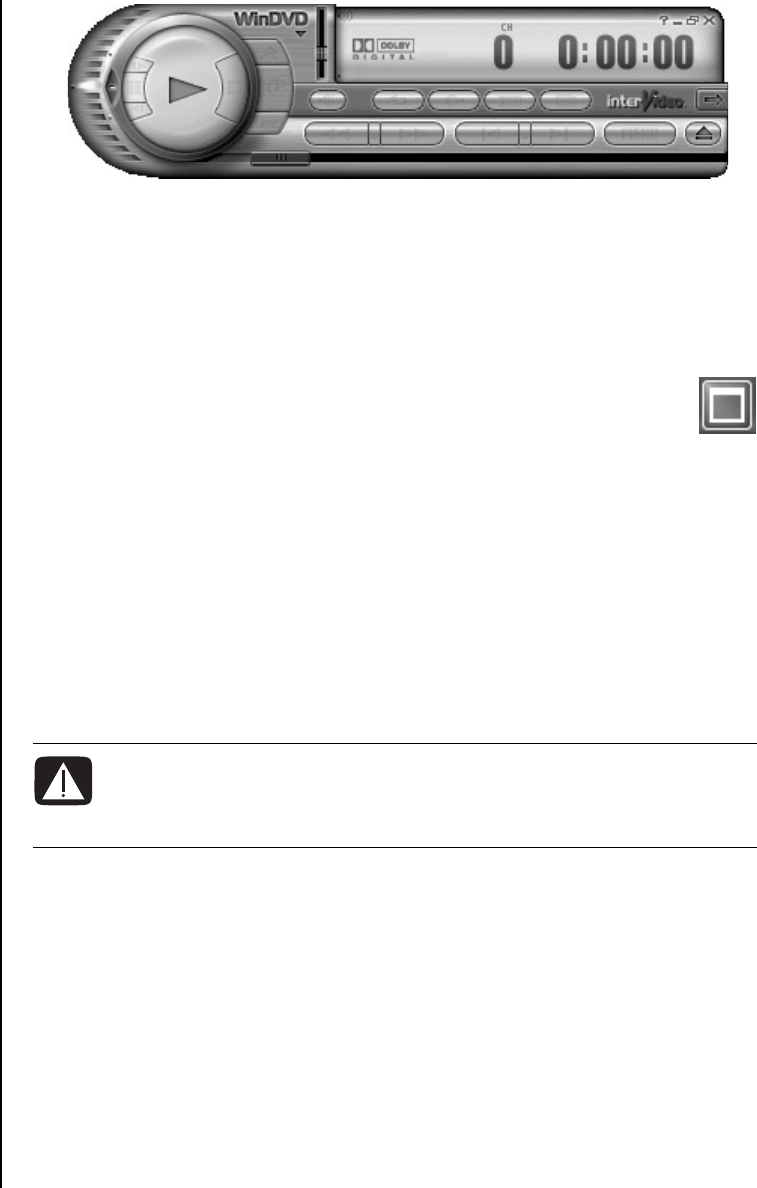
Playing CDs and DVDs 65
To use the WinDVD control panel:
•To move the WinDVD control panel, place the mouse pointer on the panel (but
not on a button), and drag it to the desired location on the screen.
•To resize the video window when it is not full screen, place the mouse pointer
on a window corner and drag the border.
Or
Click the Full Screen button in the upper-right corner of the WinDVD
control panel.
•For information on the InterVideo WinDVD software, refer to the online
Help within the program by clicking the ? (question mark) icon in the
WinDVD control panel.
Using country/region codes
Most DVD discs have country/region codes embedded in the disc data that limit
where the DVD movie can be played.
The country/region number is usually placed over a world globe printed on the
DVD packaging and disc. DVDs without country/region codes play on any player
or drive in any country/region.
WinDVD is not preset to a particular country/region — the country/region code of
the first DVD movie you play determines your DVD country/region.
For example, if you play a DVD with a country/region 1 code, WinDVD sets the
current country/region of your DVD player to 1. If you later play a DVD that is
coded for a different country/region, WinDVD asks if you want to set this as the
current country/region.
WARNING: You can change countries/regions only five times before
the country/region code locks and becomes permanent. Once the
code locks, you can play DVDs from that country/region only. If the
country/region code locks, and you need help, contact Support.

66 Getting Started Guide
Playing Video CDs (VCD) with
InterVideo WinDVD
1Insert your video CD (VCD) into a DVD or CD drive.
2Select Play DVD movie using InterVideo WinDVD, and click OK.
Or
If the program doesn’t open, click Start, choose All Programs, choose
InterVideo WinDVD, select InterVideo WinDVD Player, and then click
InterVideo WinDVD.
3If you have a dual-language VCD, the sound of one language comes
out of the left speaker and the other language comes out of the right
speaker. Double-click the Volume icon on the taskbar.
4Under Volume Control Balance, move the slider bar all the way to the right
or to the left, depending on which language you want to hear.
5Close the Volume Control window.
Playing Video CDs (VCD) with
Windows Media Player
1Insert your video CD (VCD) into a DVD or CD drive.
2Select Play DVD movie using Windows Media Player, and click OK.
Or
If the program doesn’t open, click Start, choose All Programs, and
Windows Media Player.
3Click File on the menu bar at the top, and click Open. (If you do not see the
menu bar, click the small circle with the up/down arrows in the upper-left corner
of the window.)
4Click the Look In drop-down arrow and select the drive that has the Video CD.
5Double-click the MPEGAV folder.
6Select Any File (*.*) from the Files of type drop-down list.
7Select the file, and click Open.
8If you have a dual-language VCD, the sound of one language comes out of the
left speaker and the other language comes out of the right speaker. Click View
on the menu bar, choose Enhancements, and select Graphic Equalizer.
9Move the Balance slider bar all the way to the left or to the right, depending
on which language you want to hear.
10 Close the Graphic Equalizer window.

Creating Audio and Data Discs 67
Creating Audio and Data Discs
This chapter contains the procedures you must perform to record (or burn) music
and data files to recordable CD and DVD discs. It also includes information about
labeling your discs using the LightScribe labeling technology included on select
models.
For information about recording video files to DVDs, see “Creating Video Discs and
Movies” on page 81.
Your PC includes one or more CD, DVD, or combination optical drives capable of
recording. Additionally, your PC may include the following software programs for
recording to CDs or DVDs:
•Windows Media Player
•Sonic MyDVD Plus (select models only)
•Sonic DigitalMedia Plus (select models only)
•Windows XP
These programs include features that enable you to copy, archive, and manage
music and data files and then record the files to CDs or DVDs. You can also use
Windows Media Player to download and copy music files to a portable device or
memory card.
IMPORTANT: HP supports the lawful use of technology and does not endorse
or encourage the use of our products for purposes other than those permitted by
copyright law.
NOTE: Burn is an Industry term used to describe the recording of information onto a
DVD or CD. Optical recording uses a laser beam to place information onto the disc,
thus the term burning.

68 Getting Started Guide
Erasing Rewritable Discs Before
Recording
Previously recorded files on CD-RW, DVD-RW, or DVD+RW discs must be erased
before recording new files. CD-R, DVD-R, and DVD+R discs cannot be erased.
To erase a rewritable disc in Sonic DigitalMedia Plus:
1Open the DigitalMedia Plus program by clicking Start, All Programs,
Sonic, and then DigitalMedia Home.
2Click Tools and then Erase Disc.
3Insert the rewritable disc you want to erase.
4Click the Quick Erase or Full Erase option, and then Erase Disc.
Working with Audio CDs
Sonic DigitalMedia Plus enables you to create audio CDs that play in your car or
home CD player, and on PCs. You can create two main types of music CDs:
• Uncompressed — Typical CD format like you would purchase on a
commercial CD. This type of CD holds 10 to 20 songs depending on
their length.
Uncompressed files can be burned on CD-Rs (which play in most home and
car stereos, DVD players, and computers) or CD-RWs (which play only in some
stereos, DVD players, and PCs).
The procedure for creating this type of CD is described in “Creating audio
CDs” on page 70.
• Compressed — Files are burned to a disc using a compressed file format
(.mp3, .wma, or .m4a). The smaller file format enables you to fit approximately
ten times as many songs onto the disc (depending on length and format).
Compressed files can be burned to CD-Rs, CD-RWs, DVDs, DVD-RWs, or
DVD+RWs (select models only). Compressed files can only be played on PCs,
CD players, or DVD players that support the file format you use to create the
disc (MP3 is most commonly supported). For file format compatibility, check the
documentation for the device where you intend to play the disc. You may hear
a slight loss of sound quality using compressed audio files.
The procedure for creating this type of CD is described in “Creating jukebox
discs” on page 70.
For more compatibility information, see “Disc Features and Compatibility Table” on
page 77.

Creating Audio and Data Discs 69
Both Sonic programs create closed-session music CDs, which means you must
record all music files on one CD in one recording session. Music files can be
recorded repeatedly on a rewritable CD-RW disc, but all previously recorded files
must be erased first. CD-R discs cannot be erased.
Verifying audio disc recorded without errors
When copying or burning audio files to CD, it is recommended that you use Sonic
DigitalMedia Plus because it includes a feature that confirms that your disc has been
created without errors.
This data verification feature is enabled by default.
To check the status of the write verification feature in DigitalMedia Plus:
1Open the DigitalMedia Plus program by clicking Start, All Programs,
Sonic, and then DigitalMedia Home.
2Click the Tools menu and then click Options.
3In the Options window, click Copy.
4Ensure the Verify copied data discs option is checked.
5Click OK.
Audio CD tips
When recording music files, it is important to note that:
•To play your music CD in a home or car stereo, it needs to be recorded as a
music CD in CD audio (CDA) format, not as a data CD.
•As you add music files in the recording session, DigitalMedia Plus calculates
and displays the amount of recording time available to record additional
music files.
•You can’t record song titles unless you make an exact copy of a music CD in
your collection.
•If your recording fails, manually select a slower recording speed, if available,
each time you make a recording. Refer to the Help menu in your selected
software program for more information about selecting a slower recording
speed.
•If you try to record more than a standard CD can hold, a message displays
warning you that all the tracks may not fit on your disc.
IMPORTANT: HP supports the lawful use of technology and does not endorse
or encourage the use of our products for purposes other than those permitted by
copyright law.
IMPORTANT: HP supports the lawful use of technology and does not endorse
or encourage the use of our products for purposes other than those permitted by
copyright law.

70 Getting Started Guide
Creating audio CDs
To create uncompressed audio CDs using Sonic DigitalMedia Plus:
1Open the DigitalMedia Plus program by clicking Start, All Programs,
Sonic, and then DigitalMedia Home.
2Click the Audio tab and then Audio CD.
3Do one or more of the following:
•Click Add Music and navigate to music stored on your PC.
•In the Quick Find panel, click Scan to automatically search your PC
for songs.
•Insert a CD and add songs from it.
4Select the songs you want to record, and then click Add.
5Click the Burn icon when you have added all the audio files to your
music CD project.
6When prompted, insert a blank CD-R or CD-RW disc. If you want to
play your music CD in your home or car stereo, use a CD-R disc.
CD-RW discs may not play in some stereos.
7Click OK.
You can get detailed online Help by clicking the Help menu and then
selecting Help.
Creating jukebox discs
To create compressed (jukebox) music CDs or DVDs using Sonic DigitalMedia Plus:
1Open the DigitalMedia Plus program by clicking Start, All Programs,
Sonic, and then DigitalMedia Home.
2Click the Audio tab, and then Jukebox CD/DVD.
3Do one or more of the following:
•Click Add Music, and navigate to music stored on your PC.
•In the Quick Find panel, click Scan to automatically search your PC
for songs.
•Insert a CD, and add songs from it.
4Select the songs you want to record, and then click Add.
5Click the Burn icon when you have added all the audio files to your
music CD project.
6When prompted, insert a blank disc.
DVD discs can store significantly more music files than a CD. Jukebox discs can
only be played on PCs, CD players, or DVD players that support the file format
you use to create the disc (MP3 is most commonly supported).
For file format compatibility, check the documentation for the device where you
intend to play the disc.
7Click OK.

Creating Audio and Data Discs 71
You can get detailed online Help by clicking the Help menu and then
selecting Help.
Working with Data DVDs and CDs
Unlike audio CDs and jukebox DVDs, data DVDs and CDs can be recorded in
multiple sessions.
Verifying data disc recorded without errors
When copying or burning data files to DVD or CD, it is recommended that you use
Sonic DigitalMedia Plus because it includes a feature that confirms that your disc
has been created without errors.
This data verification feature is enabled by default.
To check the status of the write verification feature in DigitalMedia Plus:
1Open the DigitalMedia Plus program by clicking Start, All Programs,
Sonic, and then DigitalMedia Home.
2Click the Tools menu and then click Options.
3In the Options window, click Data.
4Ensure the Verify data written to the disc after burning box is
checked.
5Click OK.
Data disc tips
When storing data files on a disc, it is important to note that:
•You can add new data files to a CD-R, DVD+R or DVD-R in a later
recording session, until the disc is full. With DVD+R or DVD-R discs,
insert your partially recorded DVD, click the Wrench icon to display
the Options window, click Data, select the first Write-Once DVD
Compatibility option, and then click OK.
•When you record files that have the same name as previously recorded files,
Sonic DigitalMedia Plus updates the file, and the previous version is
overwritten.
•Sonic DigitalMedia Plus allows you to change the names of files you want to
record and files that were previously recorded.
NOTE: DigitalMedia Plus scans for all audio files, even the sounds from your
operating system. If you don’t want to display some of these sounds, you can select
the Options icon (wrench). In the Options window, select Audio, and then Quick
Find. Select Hide Audio Files Shorter Than (in seconds), type the number of
seconds, and click OK.

72 Getting Started Guide
•As you select data files to record to your disc, Sonic DigitalMedia Plus
calculates and displays the amount of recording space used on your disc.
•If your recording fails, manually select a slower recording speed, if available,
each time you make a recording. Refer to the Help menu in your selected
software program for more information about selecting a slower recording
speed.
Creating data discs
To create data CDs or DVDs using Sonic DigitalMedia Plus:
1Open the DigitalMedia Plus program by clicking Start, All Programs,
Sonic, and then DigitalMedia Home.
2Click the Data tab, and then click Data Disc.
3Do one or more of the following:
•Click Add Data and navigate to files stored on your PC.
•In the Quick Scan panel, select a type of file to search for, and then click
Scan to automatically search your PC for the selected file type.
•Insert a CD or DVD that contains the file you want to add.
4Select the files you want to record, and then click Add.
5To name your disc, highlight Volume Label, and then type a name over it.
Sonic DigitalMedia Plus assigns a name based on the recording date if you do
not type a name.
6Click the Burn icon when you have added all the files to your data
project.
7When prompted, insert a blank or appendable disc.
DVD discs can store significantly more files than a CD.
8Click OK.
You can get detailed online Help by clicking the Help menu and then
selecting Help.
NOTE: An appendable disc can have additional files added to it, if there is disc
space available. Recorded audio CDs are closed-session discs that are not
appendable.
NOTE: You can rename your files in the file selection window by selecting and
typing over the current name. This does not affect the original files on your hard
disk drive.
NOTE: DVD discs can store significantly more files than a CD.

Creating Audio and Data Discs 73
Copying a DVD or CD
Sonic DigitalMedia Plus enables you to make copies of an existing music or data
disc. You can configure Sonic DigitalMedia Plus to verify that:
•Data files have been copied without errors by performing the procedure
described in “Verifying data disc recorded without errors” on page 71.
•Music files have been copied without errors by performing the procedure
described in “Verifying audio disc recorded without errors” on page 69.
To make a copy of an existing music or data disc using Sonic DigitalMedia Plus:
1Open the DigitalMedia Plus program by clicking Start, All Programs,
Sonic, and then DigitalMedia Home.
2Click the Copy tab, and then click Disc Copy.
3Insert the CD or DVD you want to copy.
4Insert a blank DVD or CD into the drive.
5Click the Copy icon.
6Click Done when the recording is complete.
Archiving Files on a CD or DVD
To make an archive file copy of files stored on your PC using
Sonic DigitalMedia Plus:
1Open the DigitalMedia Plus program by clicking Start, All Programs,
Sonic, and then DigitalMedia Home.
2Click the Data tab and then Easy Archive.
3Select the path to the files that you want to archive (or click Browse to
navigate to them).
4Select the type of files you want to add to the archive, or select All Files in the
Selected Path.
5Place a check mark in the Only Archive files changed since box, and
select a date to limit the scan to files that have been changed since that date.
6Click Save, enter a name for your archive, and then click OK.
7Click the Burn icon.
IMPORTANT: HP supports the lawful use of technology and does not endorse or
encourage the use of our products for purposes other than those permitted by
copyright law.

74 Getting Started Guide
8When prompted, insert a recordable disc, and then click OK.
If the files do not fit on one disc, you are prompted for additional discs.
9Click Done when recording is complete.
For additional information about saving archives on your hard disk drive or
scheduling automatic archives, see the online Help.
Working with Image Files
The Sonic recording programs can convert all the files from a CD or DVD and
convert them into a single .iso file, or a series of .gi files (none exceeding 2 GB)
known as an image file. You can use the image file to reproduce the original disc.
Image files are typically used when you need to make multiple copies of the
same disc.
Creating an image file
To make an image file using Sonic DigitalMedia Plus:
1Open the DigitalMedia Plus program by clicking Start, All Programs,
Sonic, and then DigitalMedia Home.
2Click Copy, and then click Save Image.
3Insert the CD or DVD from which you want to make an image file.
4Click Browse to select the location where the image file will be
created and choose the image type (.gi or .iso) to be saved. Click
Save.
5Click the Save Image icon to create the image file.
Burning from an image file
To burn a CD or DVD from an image file using Sonic DigitalMedia Plus:
1Open the DigitalMedia Plus program by clicking Start, All Programs,
Sonic, and then DigitalMedia Home.
2Click Copy and then Burn Image.
3Click Browse to select the image file.
4Insert a recordable CD or DVD into the drive.
5Click the Burn Image icon.
6Click Done when recording is complete.
NOTE: Your DVD Writer or CD Writer drive will not copy commercially available
DVD movies. Most commercial DVDs are encoded to prevent unauthorized
duplication.

Creating Audio and Data Discs 75
Disc Labeling with LightScribe
LightScribe (select models only) is a direct disc labeling technology providing you a
simple way to burn precise, silk screen-quality labels. It combines the CD or DVD
drive of your PC with specially coated discs (sold separately) and enhanced disc-
labeling software.
A LightScribe-enabled CD or DVD disc drive uses the optical laser in the drive to
burn a label onto a thin dye coating on the label side of the disc. There is no ink to
smear or paper to curl, and there are no adhesives to loosen.
LightScribe media is identified by the LightScribe logo on the retail packaging and
on the inner hub area of the disc itself. Your PC may come ready to work with many
versions of LightScribe media (select models only); however, as new media versions
are introduced, you need to update the driver software for your LightScribe-enabled
CD or DVD drive. Get driver updates from the HP Support Web site:
http://www.hp.com/support
LightScribe requirements
Burning a label with LightScribe requires three things:
•LightScribe-enabled CD or DVD drive (select models only).
•Labeling software that supports LightScribe.
•LightScribe discs (sold separately).
Burning a LightScribe label with
Sonic Express Labeler
1Click Start, All Programs, Sonic, and then click Express Labeler.
2In the Step 1: Select Project area, make sure that Disc Label is selected.
3In the Step 2: Edit area:
aClick Disc Titles to display the Edit Disc Title window. Enter text for the title
and subtitle.
bClick Tracks to display the Edit Tracks window. Click New to display the
Track window. Enter text to identify the first track or file (you can optionally
enter artist and date, or length), and then click OK.
NOTE: LightScribe creates a grayscale image similar to a black-and-white
photograph.
NOTE: You can open Express Labeler from within DigitalMedia Plus by clicking
Tools and then Label Disc.

76 Getting Started Guide
cRepeat the previous step for each track or file on the disc.
dClick the left or right arrows next to Layout and Background to select
design elements for the disc. The selections you make are previewed in the
disc window.
4When you are satisfied with the appearance of your label, insert the
LightScribe media disc (label side down) into the disc drive tray, and then
click Print.
5From the Disc Label menu, select LightScribe 12cm disc.
6Click OK to begin burning the label.
The estimated time to complete the label displays, along with a progress bar to
show you the time remaining. You can continue to work on your PC while
LightScribe is burning the label.
Using adhesive disc labels
Compatibility Information
An important feature of a DVD Writer/CD Writer drive is its high level of
compatibility with other optical drives and CD and DVD players:
•The CDs that you create play in most home and car stereos and in most PC
DVD-ROM and CD-ROM drives.
•The DVDs that you create are compatible with some DVD video players and
with most PC DVD-ROM drives.
•CD-R discs are more compatible with home and car stereos than CD-RW
discs are.
Your DVD Writer/CD Writer drive is able to read from and record to almost every
type of optical disc. Writing speed rates for the DVD Writer/CD Writer drive are
fast, allowing quick recording times.
NOTE: LightScribe creates a grayscale (monochrome) image similar to a
black-and-white photograph.
WARNING: When labeling your CDs and DVDs, do not use
sticky labels. They can cause the disc to play erratically.
Instead, write on the disc with a felt-tip pen to label it.
Or, you can create a LightScribe label for your disc if you have
a LightScribe optical drive and you use LightScribe media
discs. Refer to “Disc Labeling with LightScribe” on page 75.
NOTE: CD-R discs are more compatible with home and car stereos than
CD-RW discs.

Creating Audio and Data Discs 77
Disc Features and Compatibility Table
Disc File type
Can be
recorded
onto Plays in PC
Plays in
home or car
stereo
Plays in
home DVD
player
CD-ROM Data No Yes No No
Music No Yes Yes Varies by model
CD-R Data Yes Yes No No
Music Yes Yes Varies by model Varies by model
CD-RW Data Yes Yes No No
Music Yes Yes Varies by model Varies by model
DVD-ROM Data No Yes No No
DVD movie No Yes No Yes
DVD-RAM Data Yes Varies by model No No
DVD movie Yes Varies by model No Varies by model
DVD+R and
DVD-R
Data Yes Yes No No
DVD movie Yes Yes No Varies by model
Double-Layer
DVD+R/
DVD-R
Data Yes Varies by model No Varies by model
DVD movie Yes Varies by model No Varies by model
DVD+RW and
DVD-RW
Data Yes Yes No No
DVD movie Yes Yes No Varies by model
VCD DVD movie No Yes No Varies by model
NOTE: Some PCs come with the Double-Layer DVD Writer. It supports single-layer and double-layer DVD media. Double-Layer
technology gives you greater capacity and allows you to store up to 8 GB* of data on double-layer DVD+R or DVD-R media.
Double-layer is a new technology. Double-layer media compatibility will vary widely with some home DVD players and
DVD-ROM drives.
*1 GB is defined as 1 billion bytes. 1 GB = 1 billion bytes when referring to hard disk drive capacity. Actual formatted
capacity is less.
For the latest disc compatibility information for your PC, go to the HP Support Web site at:
http://www.hp.com/support
NOTE: Double-layer DVD technology is supported by select models only.
NOTE: The Sonic recording programs support the double-layer technology.

78 Getting Started Guide
Optical Drive Quick Reference Table
Optical
drive can: CD-ROM CD-RW DVD-ROM DVD-RAM
DVD+RW/+R
DVD-RW/–R
Double-
Layer DVD
Combo
CD-RW/
DVD
Read CDs, CD-Rs,
and CD-RWs Yes Yes Yes Yes Yes Yes Yes
Read DVDs No No Yes Yes Yes Yes Yes
Read data on
aCD Yes Yes Yes Yes Yes Yes Yes
Play music Yes Yes Yes Yes Yes Yes Yes
Record data or
music to disc for
storage or
backup
No Yes No Yes Yes Yes Yes
View DVD movies No No Yes Yes Yes Yes Yes
Record DVD
movies No No No Yes Yes Yes No
Play games Yes Yes Yes No Yes Yes Yes
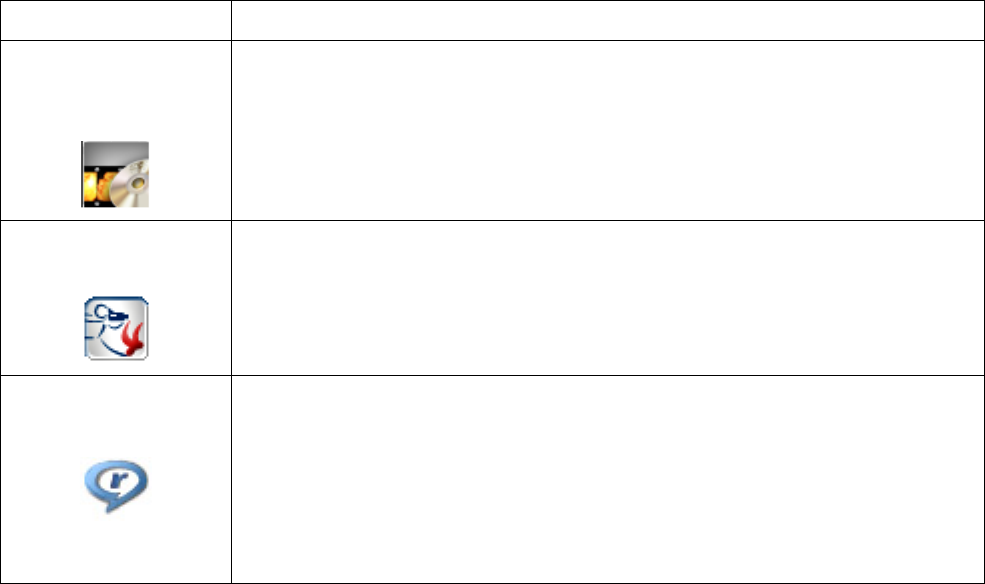
Creating Audio and Data Discs 79
Software Quick Reference Table
Your PC includes a number of software programs that:
•Record and play CDs
•Record data CDs
•Import and edit video files
•Record video CDs and DVDs
•Organize digital media files
The following table describes the functionality specific to each of these programs. Use it to determine which
program to use to perform a task.
Note that some programs listed may not be included with your model, and that this is not a complete list of all
included software.
To open any of these programs, click Start on the taskbar, choose All Programs, select the program folder (for
example, Sonic ), and then click the program name to open the software.
With this program: You can:
InterVideo
WinDVD Player
(select models only)
•Play DVD movies and video CDs (VCDs).
muvee autoProducer
(select models only) •Add your own style to your movies with music, pictures, titles, scene transitions,
and captions.
•Edit your home movies.
RealPlayer
(select models only) •Play music CDs, MP3s, and other audio files.
•Play DVD movies. (RealPlayer can play DVDs only if another DVD player
program, such as InterVideo WinDVD, is installed.)
•Play video CDs.
•Record music files.
•Organize digital files into a library for recording or listening.
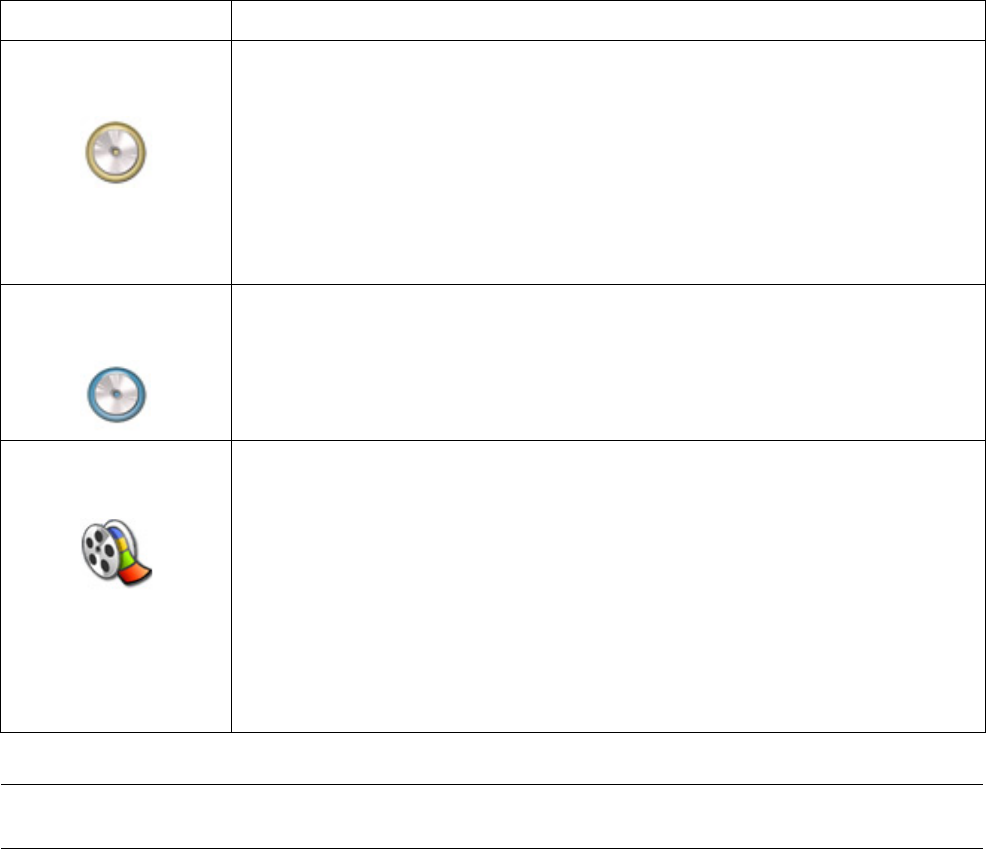
80 Getting Started Guide
Sonic DigitalMedia Plus
(select models only) •Record data and music files.
•Record a copy of an existing music or data CD to use on the PC.
•Create customized music CDs from CDs in your collection, or from .wav, .mp3,
or .wma files. These CDs can be played in your home or car stereo.
•Copy and share data files.
•Create archive CDs or DVDs from files on your PC.
•Capture (copy) video files.
•Has setting for verification that the disc has been created without errors.
Sonic MyDVD Plus
(select models only) •Record data and movie files.
•Record a copy of an existing DVD to use on the PC.
•Copy and share video files.
•Capture (copy) video files.
Windows Movie
Maker 2.0 •Import audio, video, and other media files from a videotape, an audiotape, a
Web camera, or a television broadcast.
•Record audio and video files to create a video project that becomes a Windows
Media source file with a .wmv extension.
•Edit and preview files.
•Send a movie in an e-mail or upload it to a Web server.
•Add music files (.mp3).
•Import audio files such as .mp3, .asf, or .wma; video files such as .wmv, .asf,
.avi, or .mpg; or image files such as .jpg or .gif.
•Create .avi and .wmv (Windows Media Video) files.
With this program: You can:
NOTE: You may have a software update CD included with your PC. You may need to install this CD before using
the DVD Writer/CD Writer drive. To do this, follow the installation instructions that came with the CD.

Creating Video Discs and Movies 81
Creating Video Discs and Movies
Your PC may include the following movie-making programs, depending on
your model:
•Sonic MyDVD (select models only)
•Sonic DigitalMedia Plus (select models only)
•Windows Movie Maker
•muvee autoProducer (select models only)
These programs all capture, edit, and manage your home video files, while
allowing you to add your own personal touch to your home movies. They come
installed on your PC and can be started by clicking Start and then All Programs
on your desktop.
Before You Begin Capturing Video
You can capture (copy) video files to your hard disk drive by using the Sonic
MyDVD program. Among the devices supported by Sonic MyDVD are analog video
devices, digital camcorders, and Web cameras. Use your composite or S-video
inputs (input connectors vary by model) to capture video from a VCR or an analog
video camera.
IMPORTANT: HP supports the lawful use of technology and does not endorse or
encourage the use of our products for purposes other than those permitted by
copyright law.

82 Getting Started Guide
To capture video files, you need to:
1Connect your video source device according to the device’s instructions.
2Turn your device on and set it to playback mode.
3Make sure Sonic MyDVD can detect your digital or analog device.
4If your PC has multiple video devices connected, they all appear on the Capture
screen. You must select the video source you would like to use.
For more information, click Start, All Programs, Sonic, and then DigitalMedia
Home. When the program displays, click Help and then Sonic MyDVD Help.
Sonic MyDVD Video Projects
A Sonic MyDVD video project is a way to group, organize, store, play, and burn
related video and still digital files. For example, if you went on a family vacation,
you might have digital still and video images, and prints from a film camera. You
can transfer all these images onto your PC and organize them into a project. (A
scanner is required to transfer printed photos and is not included.)
Projects can remain on your PC for playback and as an archive, and they can be
burned to a DVD or VCD disc.
Sonic MyDVD enables you to create video projects using the following interfaces:
•Standard program interface (described beginning in “Creating a Video Project”
on page 83).
•Direct-to-Disc Wizards (described beginning in “Creating a Video Project With
the Direct-to-Disc Wizards” on page 88).
Note that the Direct-to-Disc Wizards do not include the editing features that are
available from the standard interface. You can edit a project created with a wizard
before burning it to a disc as described in:
•“Editing the style of a video project” on page 86.
•“Editing movie files” on page 86.
NOTE: You may need to turn your digital video device off and on again for the
program to detect it.

Creating Video Discs and Movies 83
Creating a Video Project
To create a video project:
1Click Start, choose All Programs, Sonic, and then DigitalMedia Home.
2Click the Video button to display the Video Guide.
3Click Create Project, and then DVD or VCD depending on the type of
project you want to create.
A project named Untitled DVD-Video or Untitled Video CD is created and
displayed in the MyDVD project window.
4Click File and then Save to change the name your project from Untitled to a
more descriptive name. After renaming your project, click Save.
Continue your project by performing the procedure described in one or more of the
following sections:
•“Adding files to a video project” on page 83.
•“Capturing video to a video project” on page 84.
•“Adding slideshows to a video project” on page 85.
•“Adding submenus to a video project” on page 85.
Adding files to a video project
You can add files to your DVD or VCD video project from:
•An existing DVD or VCD.
•Video files already stored on your PC.
•Video capture from a digital video camera (as described in the next section).
To add files from a DVD, VCD, or from your hard disk drive:
1Click File, Open, and then select a video project that you created as
described in “Creating a Video Project” on page 83.
2Click Add Files.
3Navigate to the folder that contains the video files you want to add or to the
media drive that contains the DVD or VCD.
4Select the files you want to add, and then click Open. The files are added to
the current project and displayed in the project window.

84 Getting Started Guide
Capturing video to a video project
You can capture live video or still images by connecting a Web camera or digital
video camera to your PC’s USB connector. The video capture is added to your video
project and stored in a file on your hard disk drive.
To add a video capture to a video project:
1Click File, Open, and then select a video project that you created as
described in “Creating a Video Project” on page 83.
2Connect your digital camera to the USB port.
3Click Capture Video to display the Capture screen.
Sonic MyDVD displays the name of the capture device (your camera), the
default Capture Type (audio and video), and the default Quality setting
(DV format).
4Click Record Settings to edit any of these default settings.
5Optionally, set Capture Length, Chapter Points, or Scene Detection. Click
the corresponding Help icon to display the online help for each of these
features.
6Click one of the following:
•Grab Frame — The image currently displayed in the Capture window is
stored as a picture file (.jpg, .bmp, .gif, .tif, or .png format).
•Start Capturing — Starts a video capture (.mpeg format).
•Stop Capturing — Manually stops the capture if you did not set a
capture length (step 5).
7In the Save As dialog box, name the captured file, and select the file format and
the folder where you want to save it. Click Save.
8Click OK to return to the project window.
The file is stored on your hard disk drive and added to the current project.

Creating Video Discs and Movies 85
Adding slideshows to a video project
You can create a slideshow (a series of still images displayed automatically) by
adding existing still photos to your project or by capturing them with a connected
digital video source.
To add a slideshow to a video project:
1Click File, Open, and then select a video project that you created as
described in “Creating a Video Project” on page 83.
2Do one or more of the following:
•Add existing picture files as described in “Adding files to a video project”
on page 83.
•Capture still images as described in “Capturing video to a video project”
on page 84.
3Click Options to set the slide duration, or to add a background audio
track. Online help is available for these features by clicking the
Help icon.
4Click OK to add the slide show to the video project.
Adding submenus to a video project
Each project element (video file, still picture file, and slideshow) that you add to a
video project is represented in the main project window.
Each menu displays six items before a new menu is automatically created
and linked to the previous menu by a Next button.
You can manually add submenus to a project and use them to organize
topics associated with the theme of your project. For example, if the project is your
child’s soccer game, the video files of the game could be the main menu elements,
and you could insert a submenu that contains interviews with your son and his
teammates.
To add a submenu to a video project:
1Click File, Open, and then select a video project that you created as
described in “Creating a Video Project” on page 83.
2Click New Sub-Menu. A submenu called Untitled Menu 0 is added to the
first menu that has less than six project elements.
3Click the submenu name (Untitled Menu 0), and type an appropriate name
for the menu (for example, Interviews using the previous example).
4Double-click the new submenu, and do one or more of the following:
•Add existing picture files as described in “Adding files to a video project”
on page 83.
•Capture still images as described in “Capturing video to a video project”
on page 84.

86 Getting Started Guide
Editing the style of a video project
You can change the style of a number of elements within your video project.
The elements include:
•Background color and graphics on the menus and submenus
•Button styles
•Background music
•Text format (font, color, and size)
•Import custom styles
To edit the look of a video project:
1Click File, Open, and then select a video project that you created as
described in “Creating a Video Project” on page 83.
2Click Edit Style.
3In the Edit Style dialog box, change any of the previously mentioned
elements, and then click Apply To All Menus or Apply
To This Menu.
Editing movie files
After you capture or import video files, you can edit them using Sonic MyDVD to:
•Add additional files
•Add background music
•Search for specific scenes
•Delete scenes
•Add transition effects between scenes
•Superimpose colors, themes, and effects over video scenes
•Superimpose text effects over video scenes
To edit your video files:
1If your project is already open, click Edit Movie and skip to step 4.
2Click Start, All Programs, Sonic, and then DigitalMedia Home.
3Click the Video tab, and then File, New Project or Open Existing
Project.
4If you have already captured video for this project, they appear along the
bottom as a storyboard. If you have video files on your hard disk drive you
would like to add to this project, click Add Files.
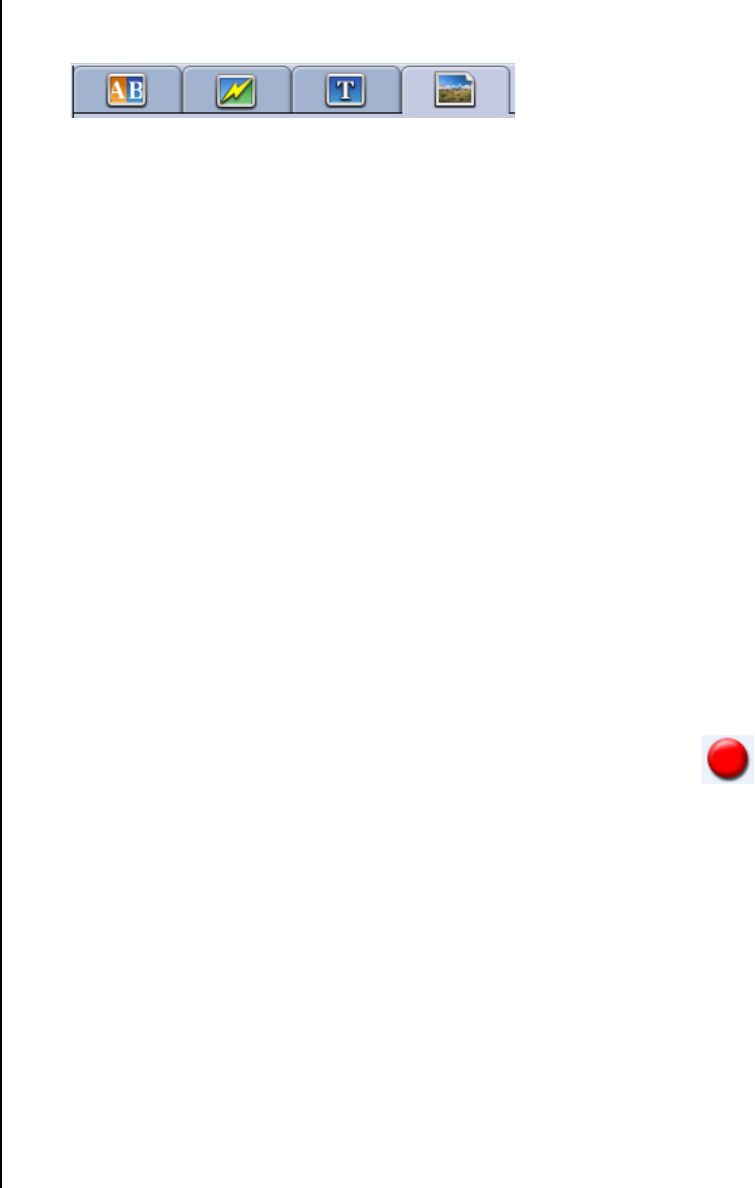
Creating Video Discs and Movies 87
5Click one of the four tabs (Fades & Dissolves, Filters, Text, or Themes
and backgrounds) next to the preview screen.
6Drag and drop any of the effects over scenes (or between them for transitions)
in the storyboard.
7Click OK to save the edits.
For more information about any of the editing features, click Help and then Sonic
MyDVD Help from within the Edit window.
Burning a video project to disc
After you are satisfied with the contents and style of your video project, you can
burn it to a DVD or VCD disc as follows:
1Click File, Open, and then select a video project that you created as
described in “Creating a Video Project” on page 83.
2Save the file if you have made changes.
3In the Quality fields, set the recording quality and the DVD or VCD type:
•The quality settings range from HQ (the highest quality, but uses the most
disc space) to EP (lowest quality, but you can fit more files).
As you select different quality settings, the disc space remaining indicator
displays how much blank space there is on the disc for this mode.
•The DVD formats include 2xDVD (8.5GB) (double layer); DVD (4.7GB)
(the default setting); DVD-RAM (2.6GB); and DVD (1.4BGB).
Some of these formats may not be supported by your model of PC.
4Insert the selected type of disc into the appropriate drive tray, close it,
and click Burn.
For detailed information about DVD and VCD recording quality and
time, see:
•“Video Quality and Disc Size” on page 89.
•“DVD Recording Time” on page 90.

88 Getting Started Guide
Creating a Video Project With the
Direct-to-Disc Wizards
Sonic MyDVD includes Direct-to-Disc Wizards that guide you through the steps you
must complete to create a DVD or VCD video project. A video project is a way to
group, organize, store, play, and burn related video and still digital files.
1Connect your digital camcorder or Web camera to your PC.
2Click Start, choose All Programs, Sonic, and then DigitalMedia Home.
3Click the Video button and then Direct-to-Disc.
4Click DVD or VCD depending on the type of project you want to create.
The Direct-to-VCD or Direct-to-DVD Wizard displays.
5Click Edit Style, and edit any of the following elements:
•Background color and graphics on the menus and submenus
•Button styles
•Background music
•Text format (font, color, and size)
•Custom styles
Alternately, you can click No Menus in the Direct-to-Disc Wizard if you do not
want to be able to select from multiple files in the project.
6Type a name for your project in the project name field.
7Click one of the following:
•Record to DVD (or Record to VCD if you are creating a VCD
project) — Select the device, number of copies, and write speed.
•Record to hard disk — The video capture is stored by default in the
My DVDs folder. Click Location if you want to select a different folder.
8Click Next. The Capture screen displays.
Make sure the output from your digital camcorder appears in the Preview
window. If it does not, double-check your connections and make sure your
camera is in playback mode.
9Click Record Settings to edit any of the default settings.
10 Optionally, set a capture length, chapter points, or scene detection. Click
the corresponding Help icon to display the online Help for each of these
features.
11 Click one of the following:
•Grab Frame — The image currently displayed in the Capture window is
stored as a picture file (.jpg, .bmp, .gif, .tif, or .png format).
•Start Capturing — Starts a video capture (.mpeg format).
•Stop Capturing — Manually stops the capture if you did not set a
capture length (step 10).
12 A confirmation message displays stating the disc or file was created
successfully. Click OK.

Creating Video Discs and Movies 89
Note that the Direct-to-Disc Wizards do not include the editing features that are
available from the standard interface. You can edit a project created with a wizard
before burning it to a disc as described in:
•“Editing the style of a video project” on page 86.
•“Editing movie files” on page 86.
Video Quality and Disc Size
Sonic MyDVD includes four DVD video quality (bit-rate) settings, and a Fit-to-DVD
option that can be applied to a video project or to individual movie files. The DVD
quality settings are:
• HQ (High Quality) — Best audio and video quality available, but requires
the most disc space per second of video. Good choice for video files that
contain high-speed action (for example, motor sports). High Quality is the
default setting for new projects.
• SP (Standard Play) — Good audio and video quality with most video
sources.
• LP (Long Play) — Fits approximately twice as much video onto a DVD as
HQ. Not recommended when the original video is low-quality or noisy.
• EP (Extended Play) — Fits the most video onto a DVD, but video quality is
low. Not recommended unless the original video is very good quality.
• Fit-to-DVD — (Available only with upgrade to MyDVD Deluxe.) As you add
more content to the project, MyDVD reduces the project quality automatically to
fit the selected disc size.
NOTE: VCDs have a fixed bit rate that delivers one quality level. You can fit
approximately 1 hour of video on a VCD (the recording time is reduced if you use
animated menu buttons or backgrounds).
NOTE: You can record the same file on a disc at each different quality level to
compare the results.

90 Getting Started Guide
DVD Recording Time
The following table lists the approximate DVD-Video recording time for different disc
sizes at different video quality settings (your DVD recorder may not support all these
disc sizes).
•The video quality depends on PC speed and graphics processing abilities.
Some PCs may be unable to capture video at the HQ setting.
•These are estimated recording times. The maximum duration is reduced if you
use animated menu buttons or backgrounds.
•To choose the audio format, see the online Help.
•Your version of MyDVD may not support Dolby Digital audio. See the online
Help for details.
Video
quality
Audio
format
Estimated time per disc size
8.5 GB 4.7 GB 2.6 GB 1.4 GB
HQ Dolby Digital 130 min. 70 min. 40 min. 20 min.
PCM 110 min. 60 min. 30 min. 15 min.
SP Dolby Digital 210 min. 120 min. 65 min. 35 min.
PCM 160 min. 95 min. 50 min. 25 min.
LP Dolby Digital 310 min. 180 min. 100 min. 50 min.
PCM 215 min. 125 min. 65 min. 35 min.
EP Dolby Digital 415 min. 240 min. 130 min. 70 min.
PCM 265 min. 150 min. 85 min. 45 min.

Creating Movies Using muvee autoProducer 91
Creating Movies Using
muvee autoProducer
Creating personalized and professional-looking video movies is simple
with muvee autoProducer (select models only).
Basic Steps to Make a Movie
The basic steps to produce a movie with muvee autoProducer are:
1 Capture digital video: Capture live or recorded video to your hard disk
drive directly from a compatible digital video camcorder.
2 Add videos and pictures: Select video and picture files from your PC
folders. You can easily add videos and still images to your movie production.
You can use these video and still image file types in your movie project:
File extension File type
.dv Digital video
.avi Audio Video Interleaved
.mpeg-1 Motion Picture Experts Group
.mpeg-2 For DVD video playback
.mpeg-4 High-quality video format (for Web streaming,
wireless devices, etc.)
.wmv Windows Movie Video
.asf Advanced Streaming Format
.mov Apple QuickTime video clip
.jpg, .jpeg Joint Photographic Experts Group, still image
.gif Graphics Interchange Format, still image
.bmp Bitmap, still image
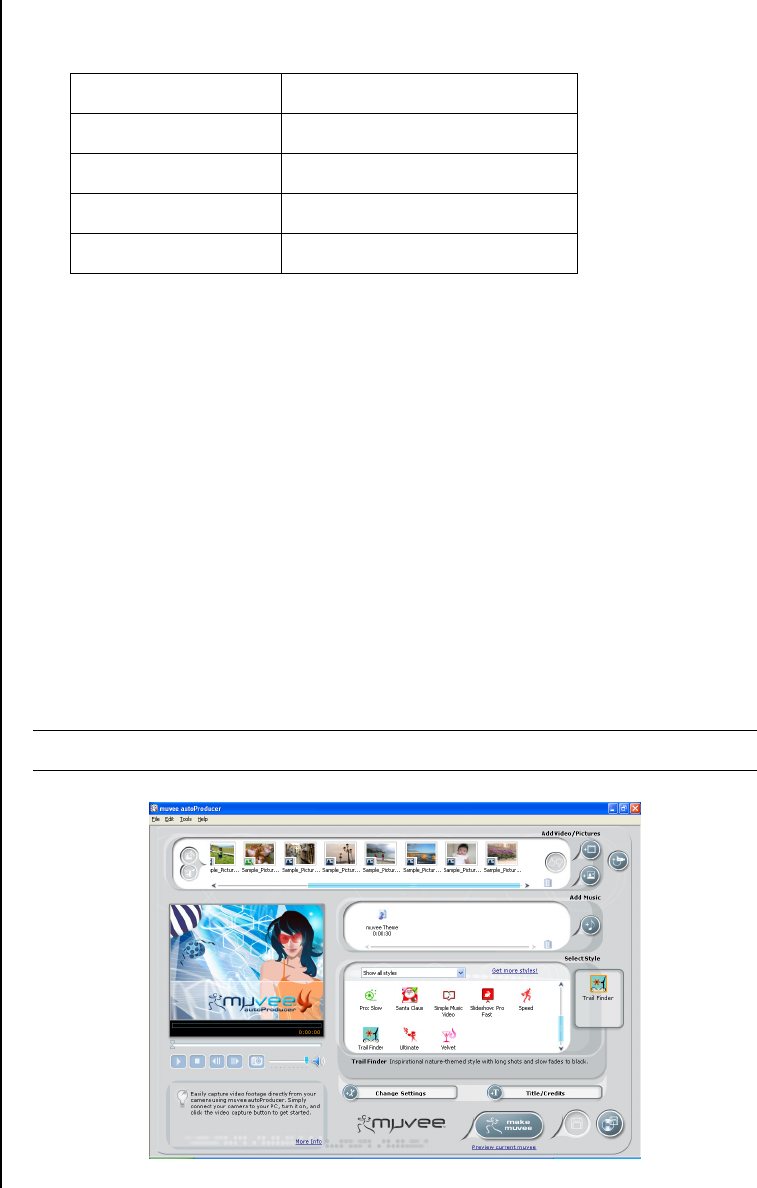
92 Getting Started Guide
3Add music: Select music files on your PC to add to your movie soundtrack.
You can use these music file types in your movie project:
4 Select a style: Apply a movie style editing template for different effects and
picture transitions in your movie.
5Add captions: Personalize your movie with opening titles and closing credits.
6 Make the movie: Automatically analyze the videos, pictures, music, movie
style, and captions you added to your movie, and save your movie to your PC
hard disk drive, CD, or DVD.
7 Burn to disc: You can burn a video to DVD, VCD, or SVCD.
The following sections contain detailed instructions.
Locating muvee autoProducer
You can access muvee autoProducer as follows:
•Click Start on the desktop taskbar, and select All Programs, muvee
Technologies, muvee autoProducer, and then muvee autoProducer
to open muvee autoProducer.
File extension File type
.mp3 MPEG Layer 3 audio
.m4a MPEG-4 audio layer
.wav Windows audio
.wma Windows Media audio
NOTE: To view Help files, press the F1 function key on the keyboard.
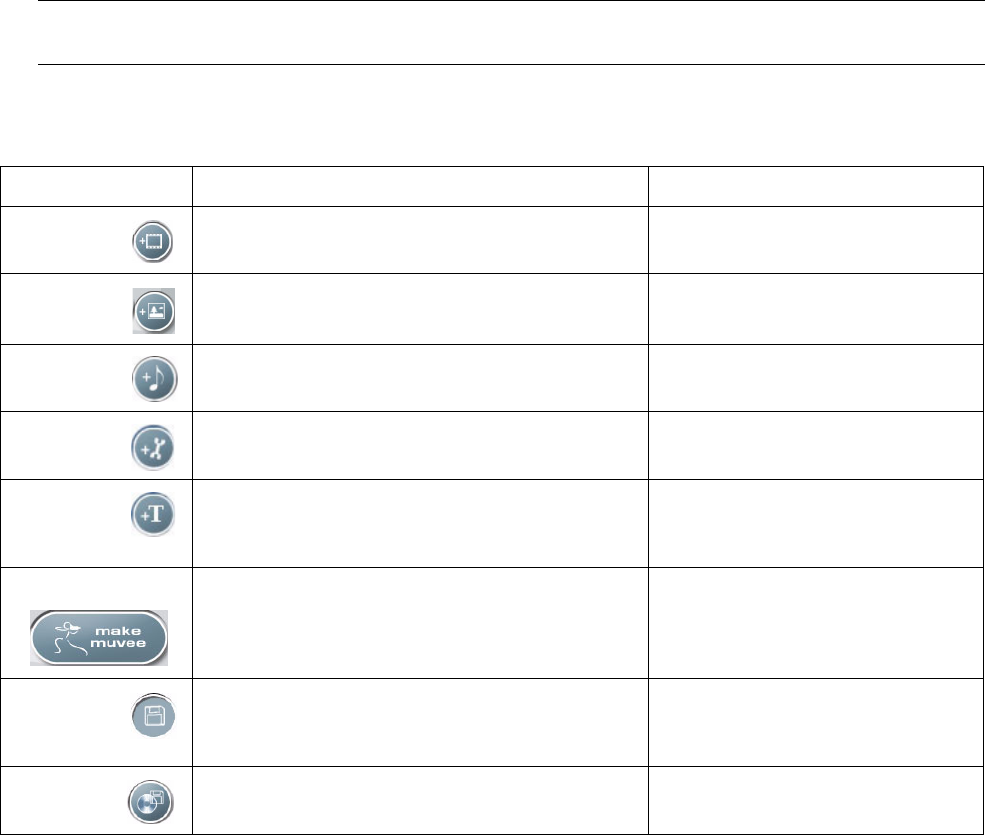
Creating Movies Using muvee autoProducer 93
Using muvee autoProducer
Getting started
To open muvee autoProducer:
1Click Start on the taskbar.
2Select All Programs, muvee Technologies, muvee autoProducer, and then muvee
autoProducer to open muvee autoProducer.
3Open a project by selecting, from the File menu, either New Project or Open Project.
4Select one of the button options:
NOTE: You can also open muvee autoProducer from within Digital Media Plus. Select the Video tab and
then muvee autoProducer.
Button Allows you to See
Add
Video
Open the Add Video window to add existing
video files to your project. “Adding videos” on page 95.
Add
Pictures
Open the Add Pictures window to add existing
still image files to your project. “Adding pictures” on page 96.
Add
Music
Open the Add Music files window to add existing
music files to your project. “Adding music” on page 97.
Change
Settings
Open the muvee Settings window to adjust audio
and video production settings for your movie. “Changing the settings” on
page 97.
Title/
Credits
Open the muvee Title and Credits window to
type in an opening title and closing credits for
your movie.
“Adding an opening title and
closing credits” on page 98.
make muvee Open the Make muvee window to automatically
create and preview the movie. “Making the movie” on page 99.
Save
muvee
Open the Save muvee window to save the
finished movie on your PC hard disk drive in .wmv
or .mpeg formats.
“Saving the movie project” on
page 100.
Burn to
Disc
Open the muvee Burner window to record the
finished movie in DVD, VCD, or SVCD formats. “Recording the movie project to
disc” on page 100.

94 Getting Started Guide
Capturing video from a DV camcorder
You can capture (copy) digital video files to your hard disk drive by using muvee
autoProducer either:
•Live (known as camera mode) using a compatible DV camcorder. See
“Capturing live video from a DV camcorder” on page 94.
Or
•Recorded (known as VCR mode) using a recorded tape in your DV
camcorder. See “Capturing recorded video from a DV camcorder” on
page 95.
Captured video files are automatically added to your movie project. To remove the
file from your movie project, select the video file in the Captured Video Files list, and
then click the trash can icon.
When capturing video, it is important to be aware of the amount of free space
available on your PC hard disk drive. Capturing video can use a large amount of
disk space. The amount of free disk space displays on the Capture Video window in
muvee autoProducer while you are capturing video.
Capturing live video from a DV camcorder
Capturing live video in camera mode allows you to create a video file without even
having a tape in the camcorder.
To capture (copy) live video to your hard disk drive using muvee autoProducer:
1Connect your DV camcorder to the FireWire (IEEE 1394) port on your PC.
2Turn on the camcorder and set to VCR mode. Refer to the instructions in the
manufacturer’s documentation.
3Click Tools, then Get Video from Camera.
4Click the Start Capture button to begin capturing the live image directly to
your hard disk drive.
5Click the Stop Capture button to stop capturing.
6Click Capture Folder to specify a folder for the captured video file.
7Click Filename to specify a file name for the captured video file.
8Click the Done button to automatically add captured video files to your
movie project.

Creating Movies Using muvee autoProducer 95
Capturing recorded video from a DV camcorder
For best results with muvee autoProducer, capture only video footage that you are
most interested in using in your movie project.
To capture camcorder (copy) recorded video to your hard disk drive:
1Connect your DV camcorder to the FireWire (IEEE 1394) port on your PC.
2Turn on the camcorder and set to VCR mode. Refer to the instructions in the
manufacturer’s documentation.
3Click Tools, then Get Video from Camera.
4Click the Play button on the screen to begin viewing the video.
5Click Start Capture when you see the start of the video footage you want to
use in your movie project.
6Click Stop Capture to stop capturing.
7Repeat steps 5 and 6 to capture additional sections of video footage.
8Click the Capture Folder to specify a folder for the captured video file.
9Click Filename to specify a file name for the captured video file.
10 Click the Done button to automatically add captured video files to your
movie project.
Adding videos
To add video files to your movie production:
1Select the Add video button in the video/pictures area. The Add
Video window opens.
2Browse the folders.
3Select existing video files on your hard disk drive, if desired for your movie:
•Add up to three video files.
•Select multiple video files by pressing and holding Ctrl on your keyboard
while selecting the files.
4Adjust the order of the video files by selecting and then dragging and dropping
the file.
To remove a video clip from the production, select the clip, and click the trash
can icon.
5You can mark specific scenes in a video clip to include or leave out of your final
movie, with the magicMoments feature in muvee autoProducer.
To select video scenes with magicMoments:
aSelect a video file in the Select Video/Pictures window, and then
click the magicMoments button. The magicMoments window
opens.
bClick the Play button to start viewing the video.

96 Getting Started Guide
cUse the magicMoments controls to mark video scenes to include and
exclude:
•Click and hold down the green thumbs-up button to mark scenes that
must be included in the movie.
•Click and hold down the red thumbs-down button to mark scenes
that must be left out of the movie.
•Click and hold down the gray thumb button to undo one second of a
selected scene. Shift and click to undo scenes that were marked with the
thumbs-up or thumbs-down buttons.
•Click and hold down the arrow buttons to navigate backward and
forward through the video footage.
Video footage left unmarked is still analyzed when you make the movie and
may be included in the final version of the movie.
For best results with the production of your movie:
•Keep each magicMoment to less than 10 seconds.
•Keep the total duration of magicMoments to less than 50 percent of the
duration of your movie. It is recommended to select only a few scenes.
dClick OK when you finish marking scenes. The window closes. Note that
the video clip is marked on the lower-left side.
Adding pictures
To add still image files to your movie production:
1Select the Add Pictures button in the Video/Pictures area. The Add
Picture window opens.
2Browse the folders, as required.
3Select existing still image files on your hard disk drive, if desired for your
movie:
•Add up to 50 .jpg, .gif, or .bmp picture files.
•Select multiple picture files by pressing and holding Ctrl on your keyboard
while selecting the files.
4Adjust the order of the picture files by selecting and then dragging and
dropping the picture file.
To remove a picture from the production, select the picture, and click the trash
can icon.
5Select the Rotate Image Clockwise button to rotate still images.

Creating Movies Using muvee autoProducer 97
6Use magicSpot to control the motion that is applied to your picture:
•Select the magicSpot button to open the magicSpot window.
•Click the manual button to display two overlapping frames over
your picture.
•Move the frames around to set the start and end points for motion.
The arrow in the frames shows the direction of motion.
Adding music
To add music files to your movie production soundtrack:
1Select the Add Music button in the music area. The Add Music
window opens.
2Browse the folders, as required.
3Select existing music files on your hard disk drive, if desired for your movie:
•Add up to three .mp3, .wav, or .wma files.
•Select multiple music files by pressing and holding Ctrl on your keyboard
while selecting the files.
4Adjust the order of the music files by selecting and then dragging and dropping
the file. Select the music, and click the trash can icon to remove a music clip
from the production.
Selecting the style
The muvee autoProducer program comes with a set of style templates for setting the
pace, scene transition effects, and caption fonts. The style you use also affects how
muvee autoProducer combines the video, picture, and music files in your movie
project to produce the final movie.
For example, using the Cinema style results in a movie that is moderately paced,
color enhanced, and uses a wide-screen format.
To select a style, just click a style from the list. A sample of the style displays in the
preview window.
Changing the settings
You can adjust audio and video production settings for your movie.
1Select the Change Settings button. The muvee Settings window
opens.
2Select the Duration tab to set the length of your video production and
preferences. Click one of the following duration settings:
•Fit to music. The produced version may reuse or drop some video and
pictures.
•Best fit for videos and pictures. The produced version may repeat or
trim music.

98 Getting Started Guide
•User Defined. Select the duration in minutes and seconds:
•If the duration of your music is longer than the duration of video and
pictures, place a check in the Allow video and pictures to repeat
check box to repeat video clips and pictures for the full duration of your
music files.
•If the total duration of your video and picture files is longer than the
duration of your music, place a check in the Allow Music to repeat
check box to repeat music for the duration of the video clips.
3Select the Video tab to set the video and still image preferences. Click one of
the following settings:
•Style default. Use the selected style to sequence still images and video
clips.
•Keep shots in sequence. Use the sequence of still images and video
clips in the Add Video/Pictures window.
•Shuffle shots. Move the slider bar to determine the frequency of
sequencing still images and video clips.
•Place a check in the Interleave pictures check box to blend pictures with
video at intervals.
4Select the Audio tab to set the sound preferences. Click one of the following
settings:
•Use all music. Place a check in the check box to use the sequence of
sound files in the Add Music window.
•smartJoin™ multiple music files. Place a check in the check box to
automatically remove silence between music tracks.
•Normalize music. Place a check in the check box to automatically adjust
audio playback volume to the same level.
•Move the slider bar to adjust the Sound mix level of the music and
original soundtrack.
5Click OK when you are finished adjusting the settings for your movie project.
Or
Click Cancel to not change any settings.
Adding an opening title and closing credits
You can personalize your movie project by adding an opening title and closing
credits.
1Click the Title/Credits button. The muvee Title and Credits window
opens.
2Click the Title tab:
aSelect a Title effect from the drop-down window.
bType the text you want to appear at the start of your movie in the Enter
your title here box.

Creating Movies Using muvee autoProducer 99
cClick the Use font button to select the font, style, size, color, and effects
from the Font window.
dSelect a background image or color for the title.
3Click the Credits tab.
aSelect a Credits effect from the drop-down window.
bType the text you want to appear at the end of your movie in the Enter
your credits here box.
cClick the Use font button to select the font, style, size, color, and effects
from the Font window.
dSelect a background image or color for the ending credits.
4Click Apply.
5Click OK to close the muvee Title and Credits window.
Making the movie
After you have added at least one video or picture file to your movie project, you
can have muvee autoProducer make the movie.
The muvee autoProducer program makes a movie by combining the video, picture,
and music files you have selected, along with the style of movie, and puts together
all of these pieces into a professional-looking movie with just a few steps.
To make a movie:
1Click the make muvee button. Click OK as required.
2After making a movie you can preview the movie in the muvee autoProducer
Preview window. Use the controls in the Preview window to play, pause, and
stop the movie preview:
•Each time you make a change to a movie project, you need to click the
make muvee button again to add that change to your movie.
•You can revise and preview the movie as often as you want to experiment
with different styles and the content of the movie.

100 Getting Started Guide
Saving the movie project
Once you are satisfied with the look of your movie project, you are ready to save it.
You can save the movie to a file on your hard disk drive or create a VCD or
DVD disc:
1Click the Save muvee button. The Save muvee window opens.
2Choose the movie file type to save to your hard disk drive:
•Computer Playback
•E-mail
•DV (camcorder)
•DVD
•VCD (video CD)
•SVCD
•Web Streaming
Click the Change Settings button to change the video and audio settings of
the movie file type as required (advanced users only).
3Click the Save button.
4Enter a name for the output movie. Select a folder on your hard disk drive, as
required. The movie saves. You can watch the preview as it saves.
5Click the Save button.
6Click Yes to preview the movie file.
Recording the movie project to disc
To create a DVD, VCD, or SVCD disc:
1Click the Burn to Disc button. The muvee Burner window opens.
2Type the disc title.
3Select the video(s) to burn to the disc:
•Select the order of the chapters.
•Add or delete videos, as required.
4Select the disc menu theme from the drop-down list.
5Select the CD or DVD burner drive.
6Select the type of video disc to create: DVD, VCD, or SVCD.
7Click Burn Now to begin burning your movie to disc.
To save the current settings for future use, click Burn Later.
8Click OK when the recording is complete. Close the muvee Burner window.

Getting Help 101
Getting Help
Finding Onscreen Guides
Onscreen guides are available in the User’s Guides folder (select models only).
1Click Start on the taskbar.
2Choose All Programs.
3Choose User’s Guides.
4Click an item to view it or use it.
Finding Guides on the Web
You can find guides and information for your PC using the Internet to access the
Support Web site.
1Go to http://www.hp.com/support in your Web browser.
2Select your country/region and language.
3From the Support and Drivers page, click See support and
troubleshooting information, enter the model number of your PC, and
then click Search .
4Click Manuals.
5Locate the manual you want and do one of the following:
•Click the title to display the file in Adobe Acrobat Reader (you can
download it from the Manuals page if it is not currently installed on
your PC).
•Right-click the title, select Save Target As, specify a location on your PC
where you want to save the file, rename the file (retaining the .pdf
extension), and then click Save.
NOTE: If there are no guide titles listed in the folder, your PC has no onscreen
guides.

102 Getting Started Guide
Using the Onscreen Help and Support
Center
Information about your PC is in the onscreen Help and Support Center (select
models only). Here you can find links to driver updates, access to technical support
options, and information about commonly asked questions.
To open the Help and Support Center:
•Press the Help button (select models only) on your keyboard.
Or
•Click Start on the taskbar, and choose Help and Support.
Using PC Help & Tools
The PC Help & Tools folder (select models only) in the All Programs menu contains
special utilities for PC owners such as support information and programs.
To see the items in the PC Help & Tools folder:
1Click Start on the taskbar.
2Choose All Programs.
3Choose PC Help & Tools.
4Click an item to view it or use it.
Using Updates from HP
Updates from HP (select models only) is an Internet-based service provided by HP to
bring you important information for your PC:
•Product notices
•Tips
•Special offers for your PC
Messages arrive while you’re connected to the Internet and will display an alert or a
notice on your desktop. You can view messages as they arrive or read them later.
Most Support updates delivered by Updates from HP messages are also available to
you through the Support Web site under the information for your PC model.

Getting Help 103
Getting messages
After you view or close a message, it will not automatically display again.
To read a previously received message, open Updates from HP:
1Click Start on the taskbar.
2Choose All Programs.
3Choose PC Help & Tools.
4Click Updates from HP. Updates from HP displays.
•If Updates from HP has been activated on your system, click View
messages to view a list of previously received messages. To read a
message, double-click the message title in the window. You can exit this
window, and Updates from HP remains active.
•If Updates from HP has not been activated on your system, the screen
contains an Activate button to activate the service. Click Activate to start
the service and view a list of messages that may have been received
previously.
Turning off messages
To turn off the Updates from HP Service:
1Click Start on the taskbar.
2Choose All Programs.
3Choose PC Help & Tools.
4Click Updates from HP. Updates from HP displays.
5Click Choose preferences and then Deactivate to deactivate the service.
The service is turned off until you reactivate it.
NOTE: You cannot receive Updates from HP messages, including important
information that may be critical to the operation of your PC, while the service is off.

104 Getting Started Guide
Reactivating messages
When you reactivate the Updates from HP service, the service runs whenever you
are connected to the Internet, and you automatically receive messages as they
become available.
To turn on the service:
1Click Start on the taskbar.
2Choose All Programs.
3Choose PC Help & Tools.
4Click Updates from HP. Updates from HP displays.
5Click Activate to reactivate the service.

Index 105
Index
A
adding
files to video projects 83
music 93, 97
pictures 93, 96
video 93, 95
adhesive disc labels 76
antivirus, installing program 10
appending discs 71, 72
audio connectors
retasking (multi-streaming) 43
B
best fit for videos and pictures 97
bit rate
DVDs, VCDs 89
Burn to disc 92, 93, 100
burning
audio and data disc 68–72
CDs, DVDs 67–80
DVDs
quality settings 89
video quality 89
image files 74
labels, LightScribe 75
multiple sessions 71
time
DVD 90
VCD 89
tips, data discs 71
VCDs 87
video projects to disc 87
buttons, keyboard
customizing 15
special keys 13
C
cable tunnel 19
camcorder capture 94
camera docking station 18
captions 92
capturing video
DV camcorder 94
in video projects 84
live video 94
recorded video 94
requirements 81
card reader, memory 49
carpal tunnel syndrome 8
CDs
burning tips
data discs 71
erasing rewritable 68
Computer Playback 100
connecting
audio 21–23
digital video camera 31
headphones 47
peripherals 2
connectors
audio 21–23
PC 2
country/region codes 65
creating
CDs 74
DVDs 74, 87
VCDs 87
Credits effect 99
customizing keyboard buttons 15
D
data

106 Getting Started Guide
archiving 73
burning in multiple sessions 71
burning tips 71
verifying integrity 71
digital images, managing 60
digital picture 49, 59
digital video camera
recording videos 31
Direct-to-Disc Wizards (MyDVD) 82, 88
discs
drive compatibility 76
erasing rewritable 68
features and compatibility 77
labeling
adhesive 76
docking bay 17
docking station, camera 17
documentation, onscreen 101
double-sided DVD 64
driver updates, LightScribe 75
DV (camcorder) 100
DVD
double-sided 64
DVDs
burning to disc 87
data discs, burning tips 71
erasing rewritable 68
movies, creating 81
quality settings 87
supported formats 86
E
editing
video files (MyDVD) 86
equalizer
Realtek HD Sound Effect Manager 41
erasing rewritable discs 68
errors
reducing recording speed 69
verifying data integrity of data discs
69, 71
F
file extensions
.asf 91
.avi 91
.bmp 91
.dv 91
.gif 91
.jpg 91
.m4a 92
.mov 91
.mp3 92
.mpeg-1 91
.mpeg-2 91
.mpeg-4 91
.wav 92
.wma 92
.wmv 91
file formats, video 84
files
adding to partially recorded discs 71
image 74
supported video formats 84
verifying copied data 71
verifying integrity of backups 71
FireWire 17, 94, 95
Fit to music 97
G
getting video from Camera 94
H
headphones, using 47
Help and Support 102
home stereo system
connecting to the PC 31
home videos 31
HP Organize 11
HP Personal Media Drive 53
activity and power lights 55
automatic on and off feature 54
disconnecting the drive 58
inserting a drive 55
location and drive letter 56
storing files 57
I
image files 74
interleave pictures 98
Internet
organizing destinations 11
signing up with an ISP 6
K
keeping shots in sequence 98
keyboard
customizing buttons 15
types of buttons 13
using 13

Index 107
L
labeling discs
adhesive labels 76
with LightScribe 75
LightScribe
compatible media 75
disc labeling 75
driver updates 75
requirements 75
M
magicMoments 95
magicSpot 97
make muvee 99
manuals
storing 5
memory card reader
card types 49
using 49
movie
making movies with muvee
autoProducer 93
multi-channel speakers
configuring 42
music 92
Allow Music to repeat 98
normalize 98
playing with Windows Media Player
63
muvee autoProducer 91
copying a movie to disc 100
features 79
getting started 93
making a movie 99
setting the style 97
MyDVD see: Sonic MyDVD
N
Norton Internet Security
configuring 7
registering 7
O
optical drive quick reference 78
organizing Internet links and the PC 11
P
Passwords
creating 10
PC
Help & Tools 102
setting up 1
transferring files and settings to new PC
11
peripherals 5
using the docking station 18
pictures, managing 60
playing music CDs 63
Q
quality settings, recording DVDs 87
R
RealOne Player, features 79
recording
CDs, VCDs, and DVDs see: burning
with Realtek HD Sound Effect
Manager, 42
repetitive strain injury (RSI) 8
rewritable discs, erasing 68
S
Safety & Comfort Guide 8
safety warnings 8
setting up PC 1
settings
user defined, muvee autoProducer 98
Shuffle shots 98
slideshows in MyDVD 85
smartJoin multiple music files 98
software programs
Windows Movie Maker 2.0 80
WinDVD Player 79
Sonic Digital Media Plus see: Sonic
MyDVD
Sonic MyDVD
default verify data setting 69, 71
Direct-to-Disc Wizards 82, 88
editing video files 86
erasing discs 68
online Help 85
verifying data feature 71
video
projects 82
quality 89
settings (quality) 90
speaker systems 21
speakers
enable digital audio output 38, 40

108 Getting Started Guide
multichannel audio
configuring 37
connecting 23, 25, 25–30, 34,
41
resolving sound issues 48
stereo
connecting to the PC 31
storing data files 71
style 92, 97
submenus in video projects 85
Support
messages 102
supported formats
DVD 86
video 84
surge protector 2
SVCD 100
T
Title effect 98
Title/Credits 93
Title/Credits in muvee autoProducer 98
transferring information to your new PC
11
TV shows
copying to CDs or DVDs 91
U
Updates from HP, using 102
updates, LightScribe drivers 75
updating, system 102
Use font 99
User accounts
creating 9
user interfaces 82
V
VCD 100
bit rate 89
burning 89
recording time 89
playing with Windows Media Player
66
playing with WinDVD 66
verifying copied data setting 71
video
adding files to projects 83
allow to repeat 98
capturing 81, 84, 88, 94
DVD recording times 90
editing
files (MyDVD) 86
muvee autoProducer 93
projects
background music 86
burning to disc 87
button styles 86
capture length 84
capturing video 84
chapter points 84
custom styles 86
Direct-to-Disc wizards 88
editing 86
MyDVD 82
scene detection 84
searching for scenes 86
slideshows 85
submenus 85
supported file formats 84
text formatting 86
transition effects 86
user interfaces 82
quality settings (MyDVD) 90
supported DVD formats 86
W
Web Streaming 100
Windows Media Player
play music CDs 63
playing video CDs 66
Windows Movie Maker 2.0, features 80
Windows update 8
WinDVD
control panel 65
playing DVD movies 64
playing video CDs 66
WinDVD Player, features 79
working in comfort 8

Getting Started Guide
Appendix: Regulatory Notices
Regulatory Notices
.To identify this product refer to the part or model number on the product label
Federal Communication Commission Notices
Federal Communication Commission Interference Statement
This equipment has been tested and found to comply with the limits for a Class B digital
device, pursuant to Part 15 of the FCC Rules. These limits are designed to provide reasonable
protection against harmful interference in a residential installation. This equipment generates,
uses and can radiate radio frequency energy and, if not installed and used in accordance with
the instructions, may cause harmful interference to radio communications. However, there is
no guarantee that interference will not occur in a particular installation. If this equipment does
cause harmful interference to radio or television reception, which can be determined by turning
the equipment off and on, the user is encouraged to try to correct the interference by one of the
following measures:
- Reorient or relocate the receiving antenna.
- Increase the separation between the equipment and receiver.
- Connect the equipment into an outlet on a circuit different from that to which the receiver is
connected.
- Consult the dealer or an experienced radio/TV technician for help.
This device complies with Part 15 of the FCC Rules. Operation is subject to the following two
conditions: (1) This device may not cause harmful interference, and (2) this device must accept
any interference received, including interference that may cause undesired operation.
FCC Caution: Any changes or modifications not expressly approved by the party responsible
for compliance could void the user's authority to operate this equipment.
IMPORTANT NOTE:
FCC Radiation Exposure Statement:
This equipment complies with FCC radiation exposure limits set forth for an uncontrolled
environment. This equipment should be installed and operated with minimum distance 20cm
between the radiator & your body.
This transmitter must not be co-located or operating in conjunction with any other antenna or
transmitter.
WUBR-177G12WW ( FCC ID: MXF-U950424G ) is limited in CH1~CH11 for 2.4GHz by specified
firmware controlled in U.S.A.

Getting Started Guide
IC CAUTION
“ To prevent radio initerference to the licensed service, this device is intended to be
operated indoors and away form windows to provide maximum shielding. Equipment
(or its transmit antenna) that is installed outdoors is subject to licensing.”
Operation is subject to the following two conditions : (1) this device may not cause
interference, and (2) this device must accept any interference, including interference
that may cause undesired operation of the device.
This device has been designed to operate with an antenna having a maximum gain
of 0 dBi. Antenna having a higher gain is strictly prohibited per regulations of Industry
Canada. The required antenna impedance is 50 ohms.
IMPORTANT NOTE:
IC Radiation Exposure Statement:
This equipment complies with IC radiation exposure limits set forth for an uncontrolled
environment. End users must follow the specific operating instructions for satisfying RF
exposure compliance. This equipment should be installed and operated with minimum
distance 20cm between the radiator & your body.
This transmitter must not be co-located or operating in conjunction with any other
antenna or transmitter.